|
Meinem Lehrer und Freund Prof. Dr. Heinrich von Stietencron ist die gesamte Amarakośa-Übersetzung in Dankbarkeit gewidmet. |
Zitierweise | cite as: Amarasiṃha <6./8. Jhdt. n. Chr.>: Nāmaliṅgānuśāsana (Amarakośa) / übersetzt von Alois Payer <1944 - >. -- 2. Dvitīyaṃ kāṇḍam. -- 12. manuṣyavargaḥ III. (Über Menschen). -- 3. Vers 22c - 41. (Körperpflege, Schlafzimmereinrichtung). -- Fassung vom 2011-03-10. -- URL: http://www.payer.de/amarakosa4/amara212c.htm
Erstmals hier publiziert: 2011-03-10
Überarbeitungen:
©opyright: Creative Commons Lizenz (Namensnennung, keine kommerzielle Nutzung, share alike)
Dieser Text ist Teil der Abteilung Sanskrit von Tüpfli's Global Village Library
|
Meinem Lehrer und Freund Prof. Dr. Heinrich von Stietencron ist die gesamte Amarakośa-Übersetzung in Dankbarkeit gewidmet. |
Falls Sie die diakritischen Zeichen nicht dargestellt bekommen, installieren Sie eine Schrift mit Diakritika wie z.B. Tahoma.
Die Devanāgarī-Zeichen sind in Unicode kodiert. Sie benötigen also eine Unicode-Devanāgarī-Schrift.
| 22c./d. parikarmāṅgasaṃskāraḥ syān mārṣṭir mārjanā mṛjā परिकर्माङ्गसंस्कारः स्यान् मार्ष्टिर् मार्जना मृजा ॥२२ ख॥ [Bezeichnungen für Körperpflege:]
|
Colebrooke (1807): "Embellishment of person. Dress for cleanliness ; or else ornament by sandal wood and perfumes."
परिकर्मन् - parikarman n.: Vorbereitung, Kultus, Reinigung, Körperpflege
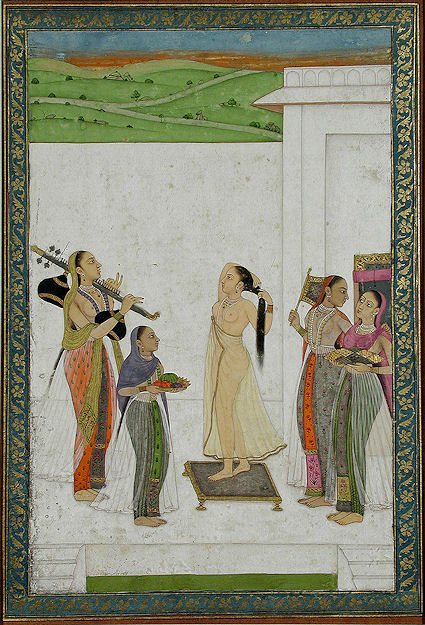
Abb.: परिकर्म । "A woman completing her toilette", Andhra Pradesh, ca.
1725
[Bildquelle: Asian Curator at The San Diego Museum of
Art. --
http://www.flickr.com/photos/asianartsandiego/4838259626/. -- Zugriff am
2011-03-05. --
Creative Commons Lizenz (Namensnennung, keine kommerzielle Nutzung,
keine Bearbeitung)]
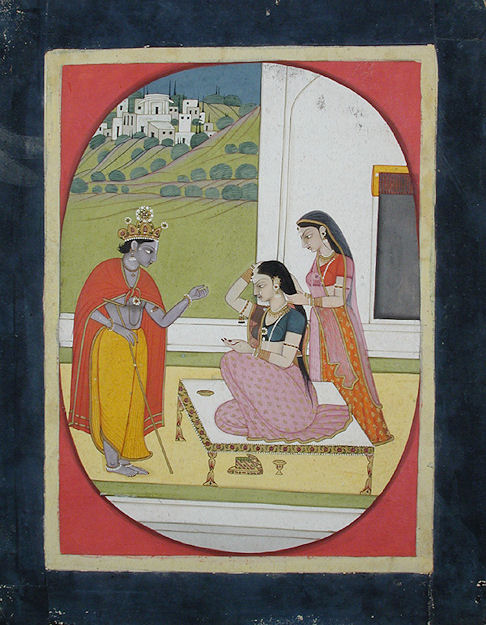
Abb.: परिकर्म । Kṛṣṇa schaut Rādhā bei der Toilette zu, Uttar Pradesh, ca. 1795
[Bildquelle: Asian Curator at The San Diego Museum of
Art. --
http://www.flickr.com/photos/asianartsandiego/4837909143/. -- Zugriff am
2011-03-06. --
Creative Commons Lizenz (Namensnennung, keine kommerzielle Nutzung,
keine Bearbeitung)]
अङ्गसंस्कार - aṅgasaṃskāra m.: Zubereitung der Glieder
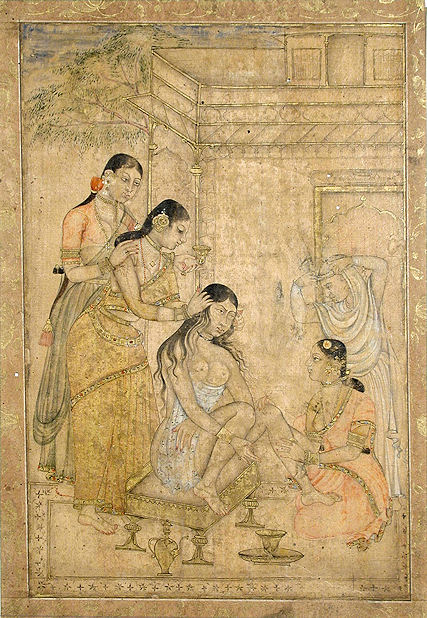
Abb.: अङ्गसंस्कारः । Toilette einer jungen Frau, Andhra Pradesh, 17. Jhdt.
[Bildquelle: Asian Curator at The San Diego Museum of
Art. --
http://www.flickr.com/photos/asianartsandiego/4838253480/. -- Zugriff am
2011-03-05. --
Creative Commons Lizenz (Namensnennung, keine kommerzielle Nutzung,
keine Bearbeitung)]
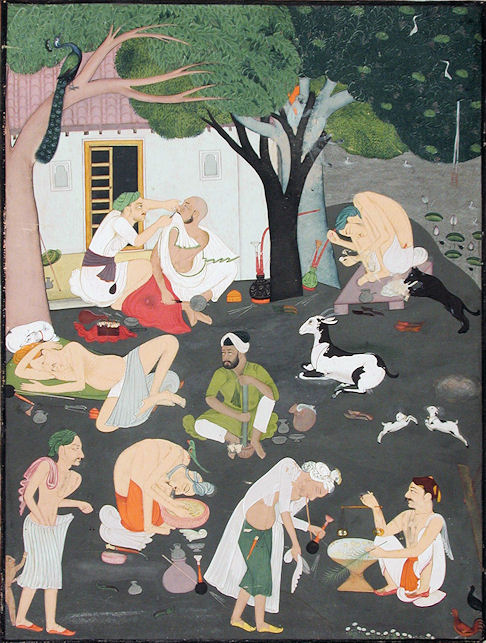
Abb.: अङ्गसंस्कारः । "Nine sadhus eating, bathing, sleeping, being groomed,
smoking, mixing bhang", Rajasthan, ca. 1775
[Bildquelle: Asian Curator at The San Diego Museum of
Art. --
http://www.flickr.com/photos/asianartsandiego/4838328656/. -- Zugriff am
2011-03-05. --
Creative Commons Lizenz (Namensnennung, keine kommerzielle Nutzung,
keine Bearbeitung)]
| 22c./d. parikarmāṅgasaṃskāraḥ syān mārṣṭir mārjanā mṛjā परिकर्माङ्गसम्स्कारः स्यान् मार्ष्टिर् मार्जना मृजा ॥२२ ख॥ [Bezeichnungen für Reinigung:]
|
Colebrooke (1807): "Cleaning of it. By wiping ; or bathing, rubbing with oil and sandal wood."
मार्ष्टि - mārṣṭi f.: Abwischen, Reinigung, Waschung
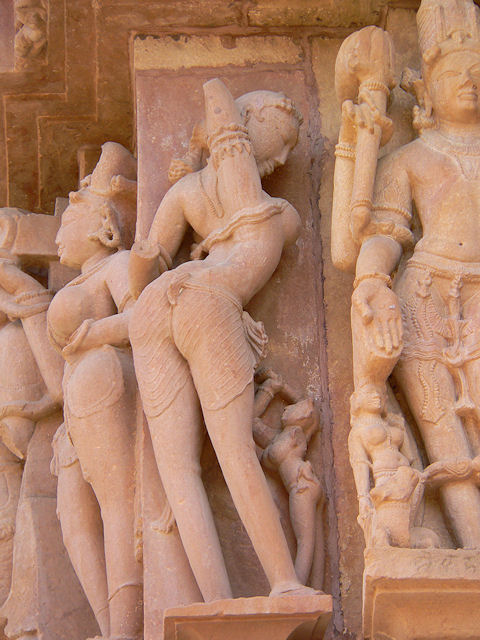
Abb.: मार्ष्टिः । Khajuraho -
खजुराहो,
Madhya Pradesh
[Bildquelle:
Steve Silverman. --
http://www.flickr.com/photos/pov_steve/2271843060/. -- Zugriff am
2011-03-05. --
Creative Commons Lizenz (Namensnennung, keine kommerzielle Nutzung,
keine Bearbeitung)]
मार्जना - mārjanā f.: Abwischen, Reinigung, Waschung

Abb.: मार्जना । Kolkata -
কলকাতা,
West Bengal
[Bildquelle: Jason Hall. --
http://www.flickr.com/photos/extremeboh/448443529/in/photostream/. --
Zugriff am 2011-03-08. --
Creative Commons
Lizenz (Namensnennung, keine kommerzielle Nutzung, keine Bearbeitung)]
मृजा - mṛjā f.: Reinigung, Reinheit, reine Haut

Abb.: मृजा । Varanasi - वाराणसी, Uttar Pradesh
[Bildquelle: Dennis Jarvis. --
http://www.flickr.com/photos/archer10/2214427649/. -- Zugriff am
2011-03-08. --
Creative
Commons Lizenz (Namensnennung, share alike)]
| 23a./b. udvartanotsādane dve same āplāva āplavaḥ उद्वर्तनोत्सादने द्वे समे आप्लाव आप्लवः ।२३ क। [Bezeichnungen für Einreiben:]
|
Colebrooke (1807): "Cleaning with perfumes."
उद्वर्तन - udvartana n.: Einreiben, Mittel zum Einreiben
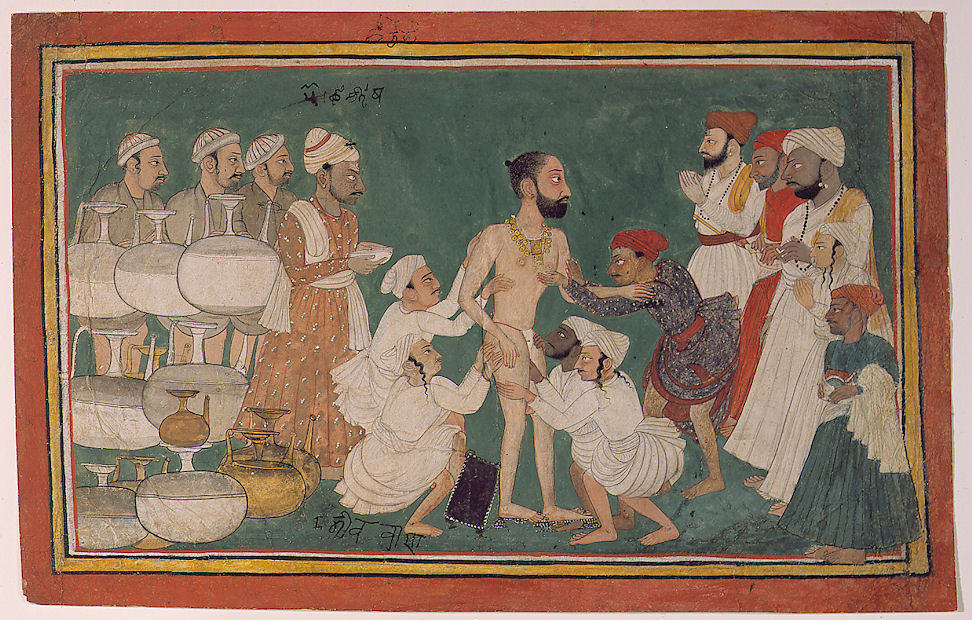
Abb.: उद्वर्तनम् । "The Lustration of Raja Shamsher
Sen", Himachal Pradesh, ca. 1730
[Bildquelle: Asian Curator at The San Diego Museum of
Art. --
http://www.flickr.com/photos/asianartsandiego/4837861217/. -- Zugriff am
2011-03-05. --
Creative Commons Lizenz (Namensnennung, keine kommerzielle Nutzung,
keine Bearbeitung)]
उत्सादन - utsādana n.: Vernichten, Reinigen, Abreiben, Einreiben

Abb.: उत्सादनम् । Ayurvedische Behandlung, Kumarakom - കുമരകം, Kerala
[Bildquelle: BIJI KURIAN. --
http://www.flickr.com/photos/kruain/2555706052/. -- Zugriff am
2011-03-08. --
Creative
Commons Lizenz (Namensnennung, share alike)]
| 23. udvartanotsādane dve same āplāva āplavaḥ snānaṃ carcā tu cārcikyaṃ sthāsako 'tha prabodhanam
उद्वर्तनोत्सादने द्वे समे आप्लाव आप्लवः । [Bezeichnungen für Baden:]
|
Colebrooke (1807): "Bathing
आप्लाव - āplāva m.: Baden, Bad, Übergießen
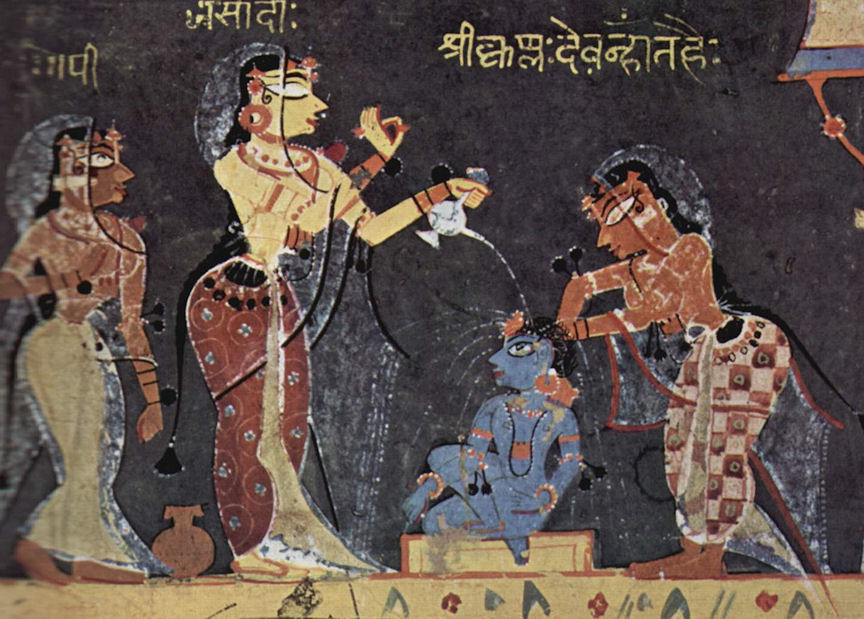
Abb.: आप्लावः । Yaśodhā badet den Knaben Kṛṣṇa, um 1500 n. Chr.
[Bildquelle: Wikipedia. -- Public domain]
आप्लव - āplava m.: Baden, Bad, Übergießen

Abb.: आप्लवः । Delhi
[Bildquelle: runran. --
http://www.flickr.com/photos/runran/4295263796/. -- Zugriff am
2011-03-05. --
Creative
Commons Lizenz (Namensnennung, share alike)]
स्नान - snāna n.: Bad, Waschung, Waschmittel
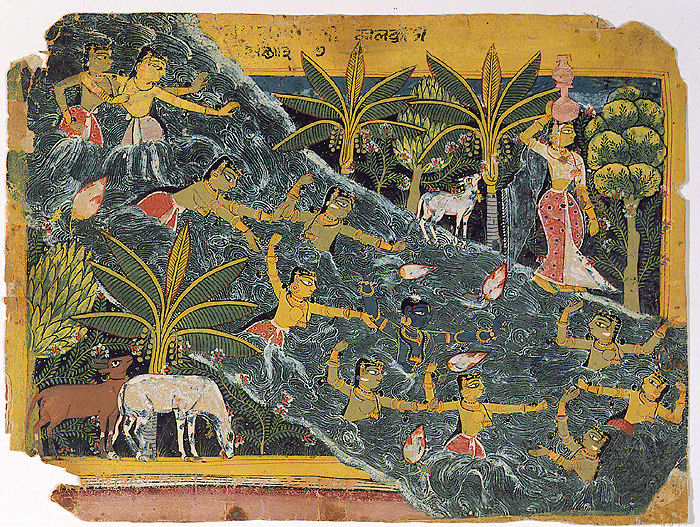
Abb.: स्नानम् । "The sports of love", Bhāgavatapurāṇa, Rajasthan, 16.
Jhdt.
[Bildquelle: Asian Curator at The San Diego Museum of Art. --
http://www.flickr.com/photos/asianartsandiego/4837672831/. -- Zugriff am
2011-03-05. --
Creative Commons Lizenz (Namensnennung, keine kommerzielle Nutzung,
keine Bearbeitung)]
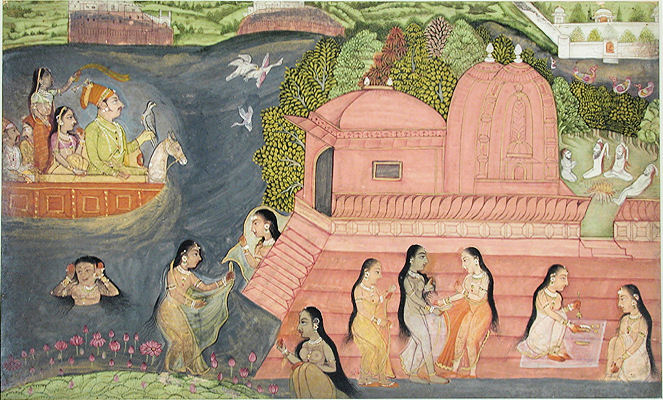
Abb.: स्नानम् । "A Raja hawking from a boat comes upon bathing beauties
by a temple", Rajasthan, ca. 1695
[Bildquelle: Asian Curator at The San Diego Museum of
Art. --
http://www.flickr.com/photos/asianartsandiego/4837776911/. -- Zugriff am
2011-03-05. --
Creative Commons Lizenz (Namensnennung, keine kommerzielle Nutzung,
keine Bearbeitung)]
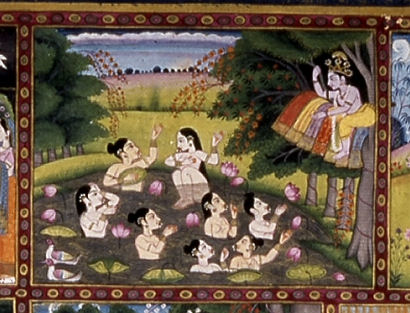
Abb.: स्नानम् । Kṛṣṇa stiehlt die Kleider der badenden Gopis, 1800/1850
[Bildquelle: Wikipedia. -- Public domain]
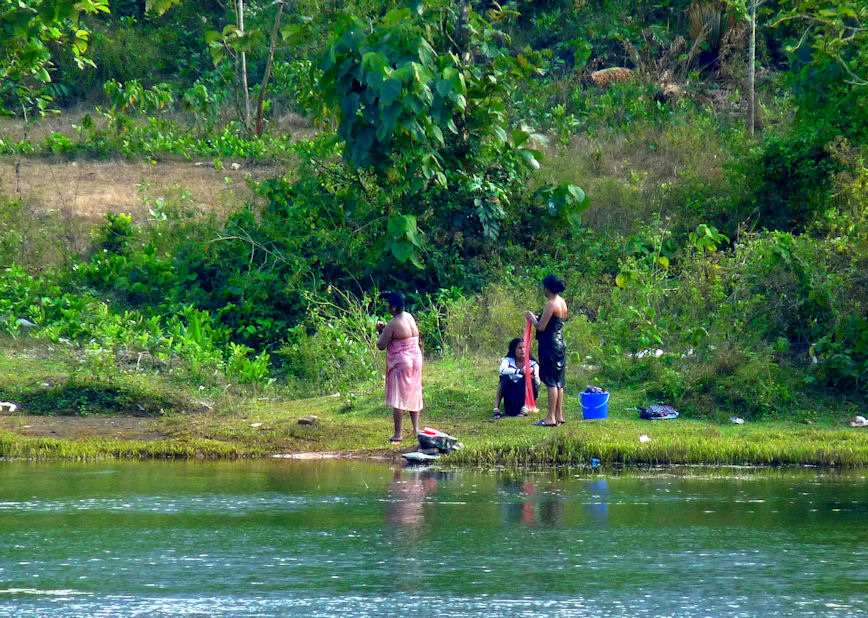
Abb.: स्नानम् । Kerala
[Bildquelle:
jeevan jose. --
http://www.flickr.com/photos/jkadavoor/5074620660/. -- Zugriff am
2011-03-05. --
Creative
Commons Lizenz (Namensnennung, keine kommerzielle Nutzung, share alike)]
| 23c./d. snānaṃ carcā tu cārcikyaṃ sthāsako 'tha prabodhanam स्नानं चर्चा तु चार्चिक्यं स्थासको ऽथ प्रबोधनम् ॥२३ ख॥ [Bezeichnungen für Ganzkörpereinreibung:]
|
Colebrooke (1807): "Perfuming. By plastering the whole person with sandal wood, &c."
चर्चा - carcā f.: Einsalben des Körpers, Salbe (zu carc: wiederholen; einen Überzug machen)

Abb.: चर्चा । Ayurvedische Behandlung, Kovalam - കോവളം,
Kerala
[Bildquelle: Fabrice Florin. --
http://www.flickr.com/photos/fabola/3288476972/. -- Zugriff am
2011-03-08. --
Creative Commons Lizenz (Namensnennung, keine kommerzielle Nutzung,
keine Bearbeitung)]
| 23c./d. snānaṃ carcā tu cārcikyaṃ sthāsako 'tha prabodhanam 24a./b. anubodhaḥ patralekhā patrāṅgulir ime same
स्नानं चर्चा तु चार्चिक्यं स्थासको
ऽथ प्रबोधनम् ॥२३ ख॥ [Bezeichnungen für Erfrischung:]
|
Colebrooke (1807): "Reviving a fragrancy."
| 24a./b. anubodhaḥ patralekhā patrāṅgulir ime same अनुबोधः पत्रलेखा पत्राङ्गुलिर् इमे समे ।२४ क। [Bezeichnungen für Körperbemalung:]
|
Colebrooke (1807): "Painting the person. Delineations with saffron or with musk, &c. on the breast, cheeks, &c."
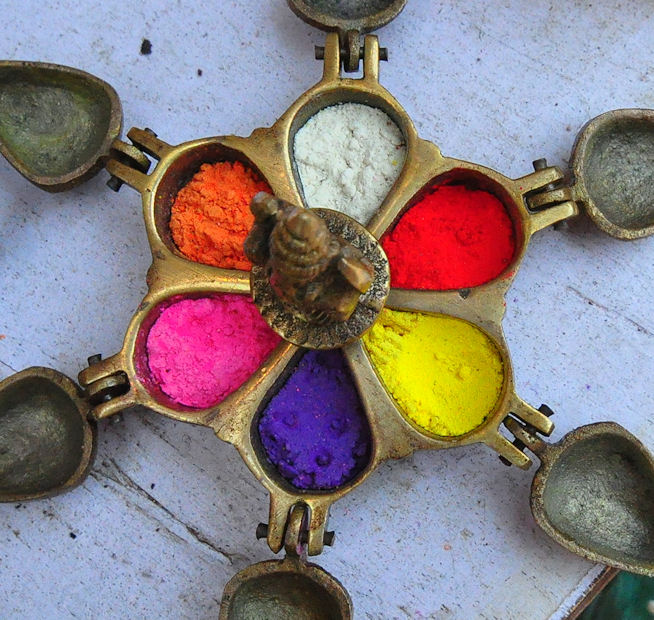
Abb.: Farbpuder-Behälter, Kochi -
കൊച്ചി
, Kerala
[Bildquelle:
Akshay Davis. --
http://www.flickr.com/photos/akshaydavis/4512282816/. -- Zugriff am
2011-03-07. --
Creative
Commons Lizenz (Namensnennung, keine kommerzielle Nutzung, share alike)]
पत्रलेखा - patralekhā f.: "Feder-Linie", auf Gesicht und Körper aufgetragene Zeichen, Körperbemalung
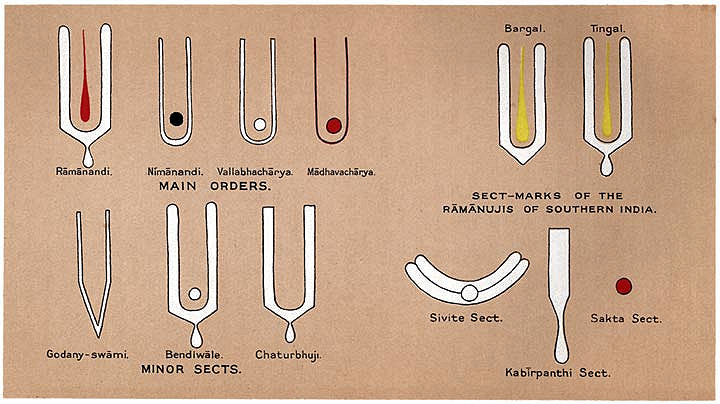
Abb.: पत्रलेखाः । Beispiele von Tilakas als Sektenzeichen
[Bildquelle: The Tribes and Castes of the Central
Provinces of India / by R. V. Russel and
Rai Bahadur Hira Lāl. -- Vol II. -- London, 1916
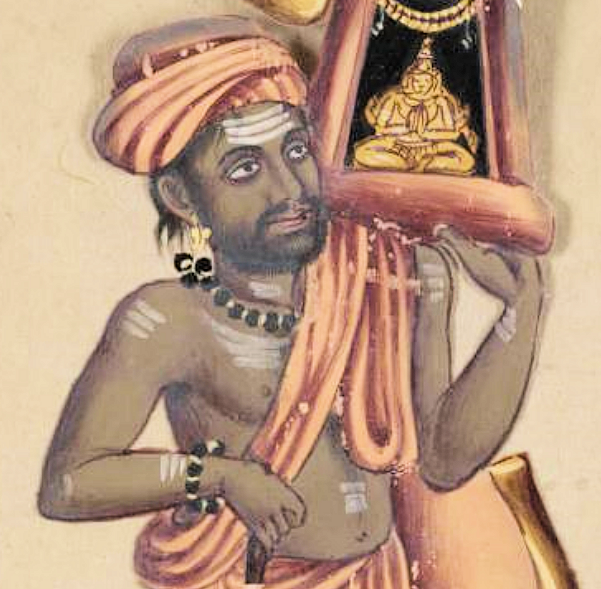
Abb.: पत्रलेखा । Rajputen-Fürst
[Bildquelle: Vardapillai, 1837]
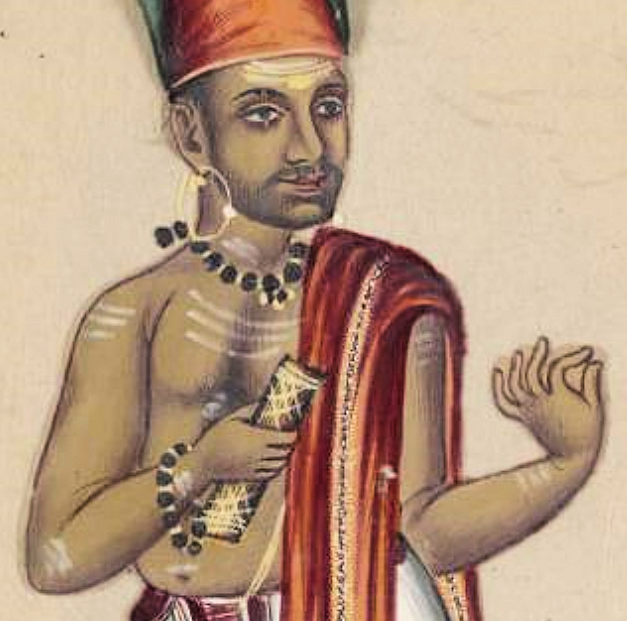
Abb.: पत्रलेखा । Astrologe
[Bildquelle: Vardapillai, 1837]
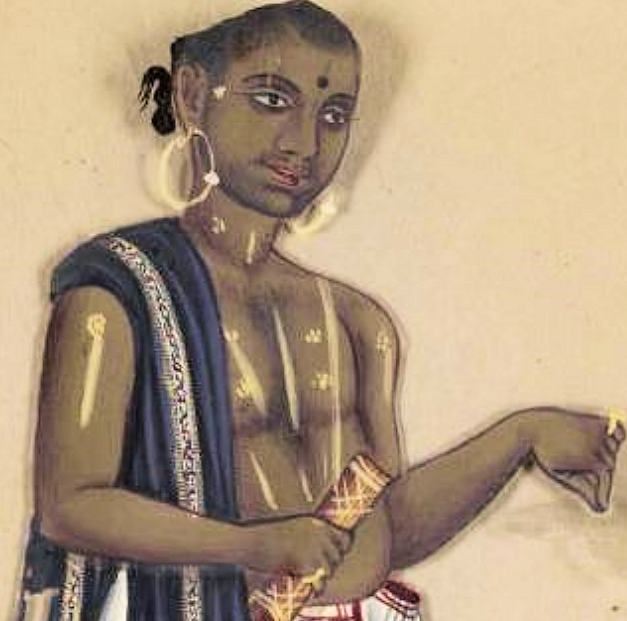
Abb.: पत्रलेखा । Brahmane
[Bildquelle: Vardapillai, 1837]
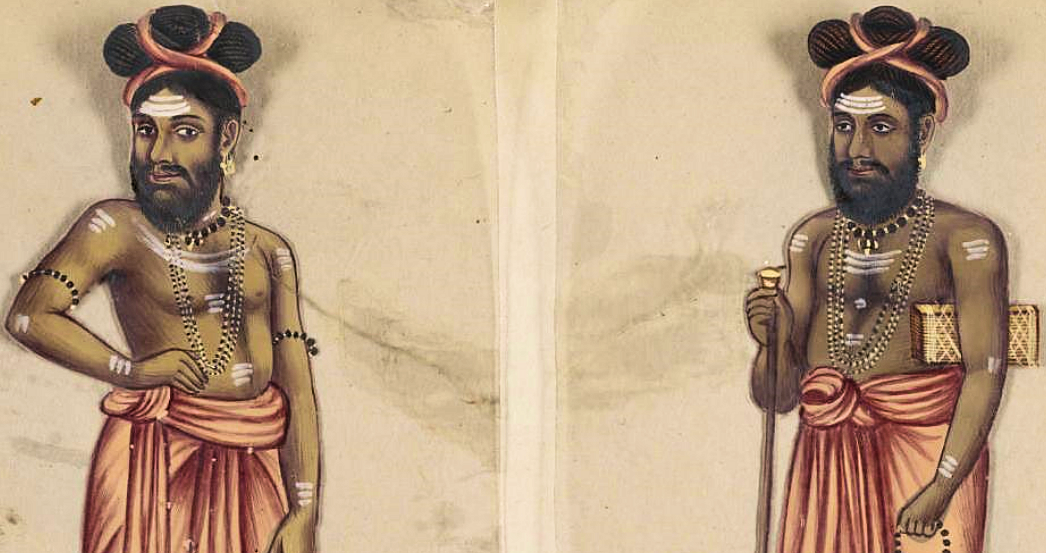
Abb.: पत्रलेखे । Priester
[Bildquelle: Vardapillai, 1837]
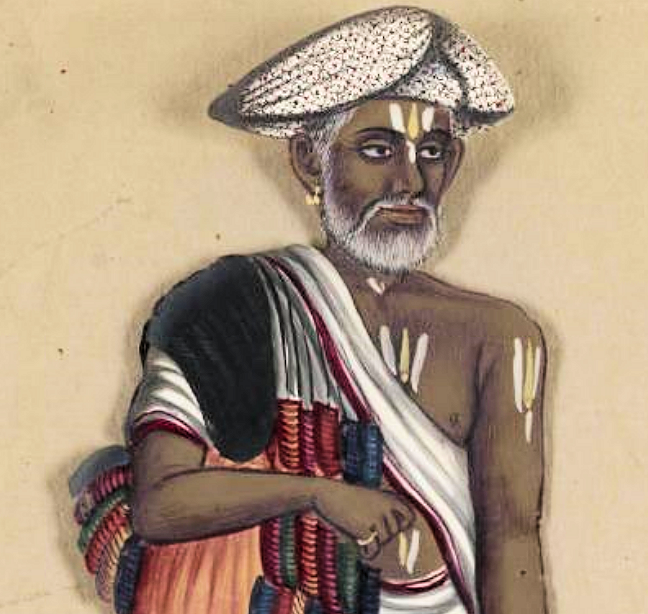
Abb.: पत्रलेखा । Armband-Macher
[Bildquelle: Vardapillai, 1837]
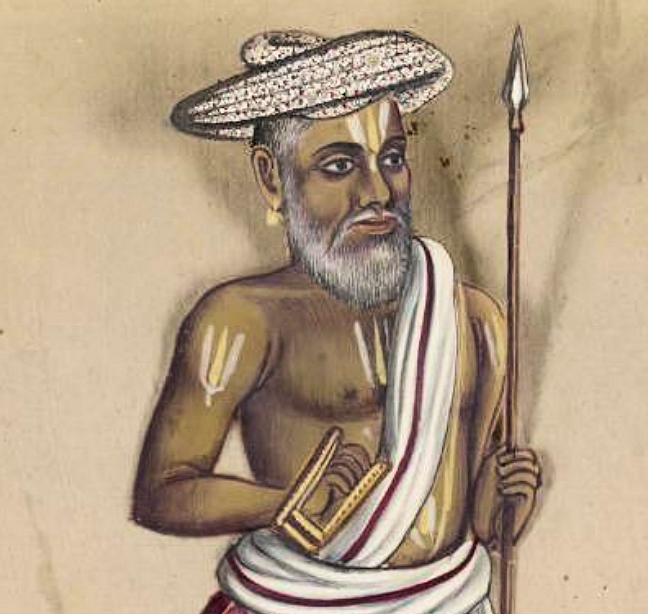
Abb.: पत्रलेखा । Jäger
[Bildquelle: Vardapillai, 1837]
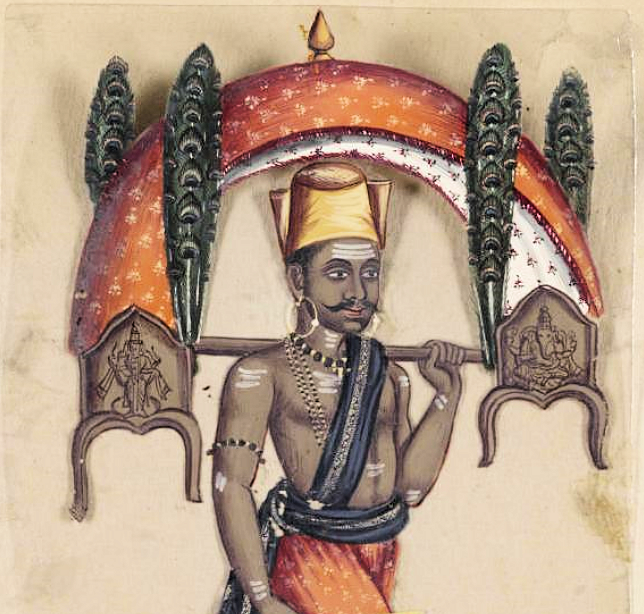
Abb.: पत्रलेखा । Malabarischer Pilger
[Bildquelle: Vardapillai, 1837]
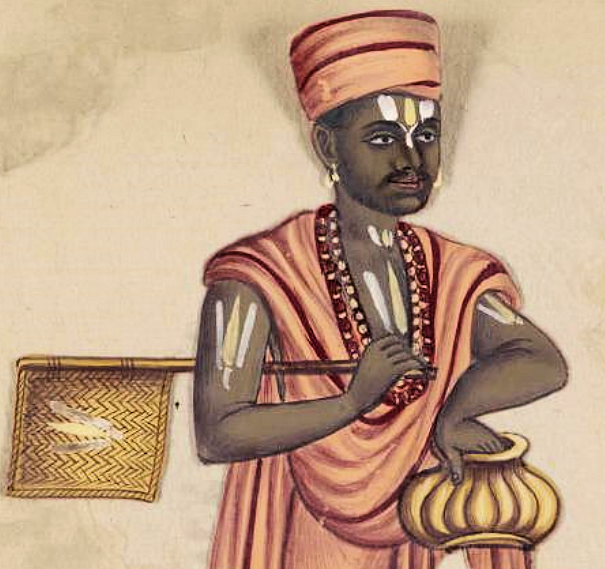
Abb.: पत्रलेखा । Bettler
[Bildquelle: Vardapillai, 1837]
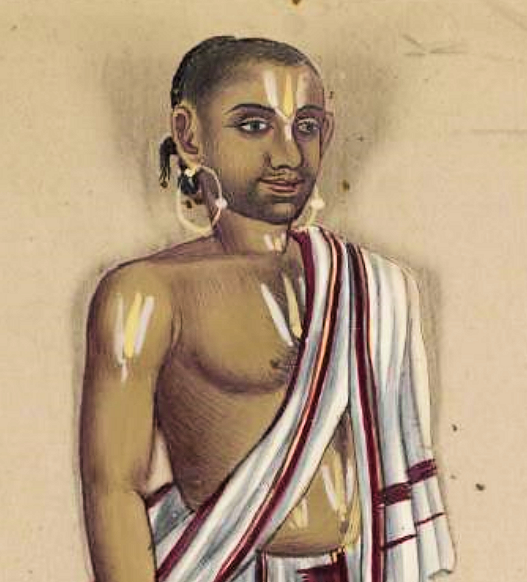
Abb.: पत्रलेखा । Shringeri-Brahmane
[Bildquelle: Vardapillai, 1837]
पत्राङ्गुलि - patrāṅguli f.: "Feder-Finger", Auf Gesicht und Körper aufgetragene Zeichen, Körperbemalung
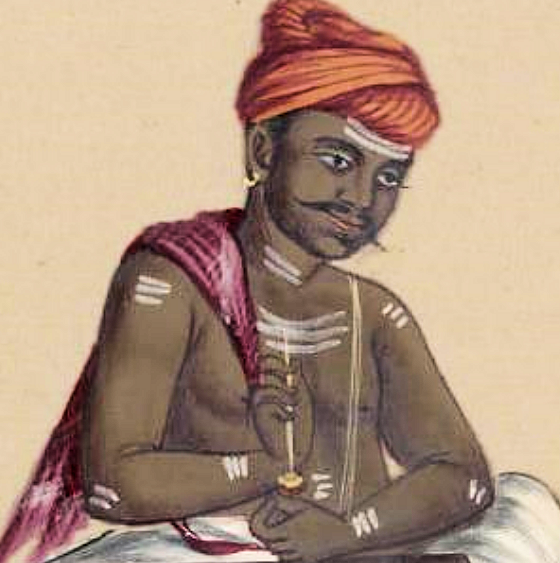
Abb.:
पत्राङ्गुलिः
। Malabarischer Goldschmied
[Bildquelle: Vardapillai, 1837]
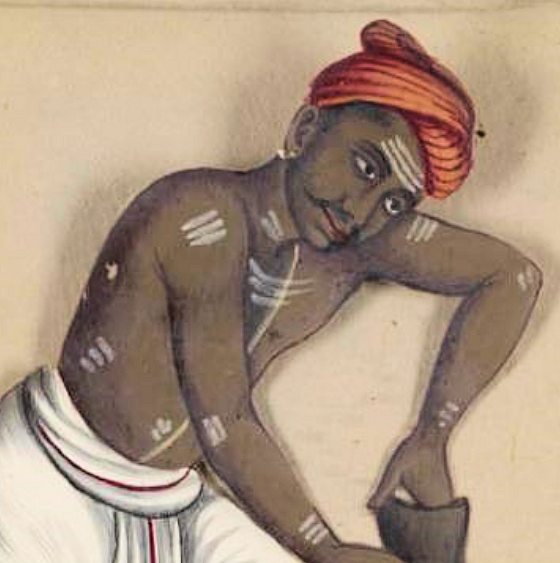
Abb.:
पत्राङ्गुलिः
। Töpfer
[Bildquelle: Vardapillai, 1837]
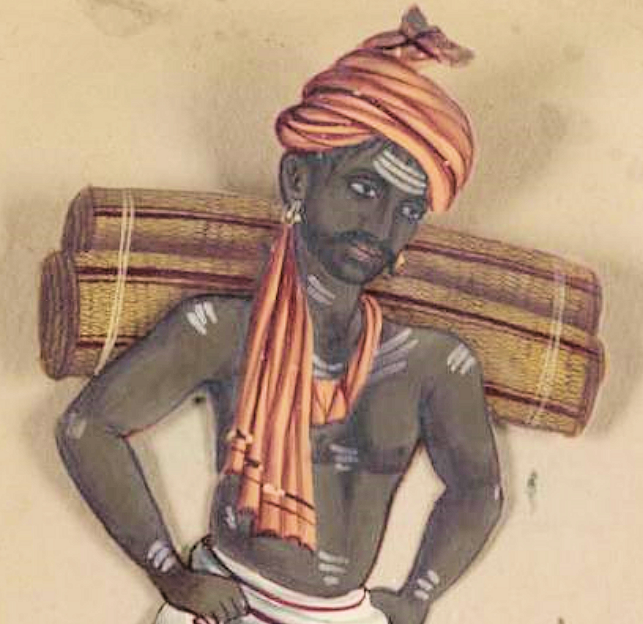
Abb.:
पत्राङ्गुलिः
। Mattenmacher
[Bildquelle: Vardapillai, 1837]
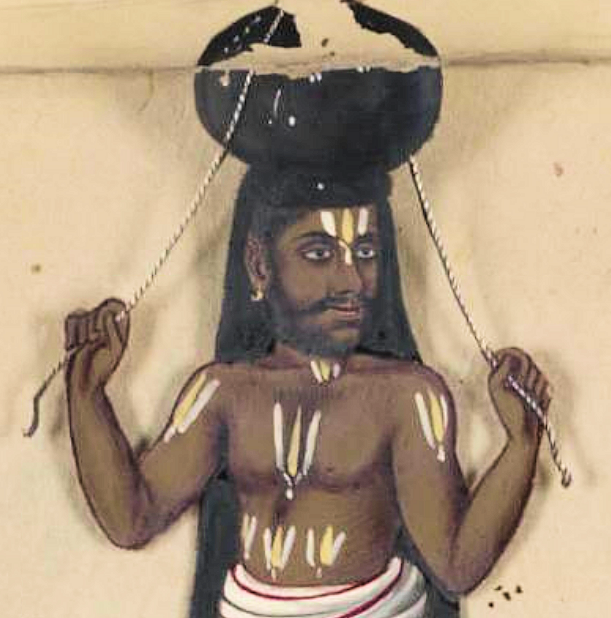
Abb.:
पत्राङ्गुलिः
। Milchmann
[Bildquelle: Vardapillai, 1837]
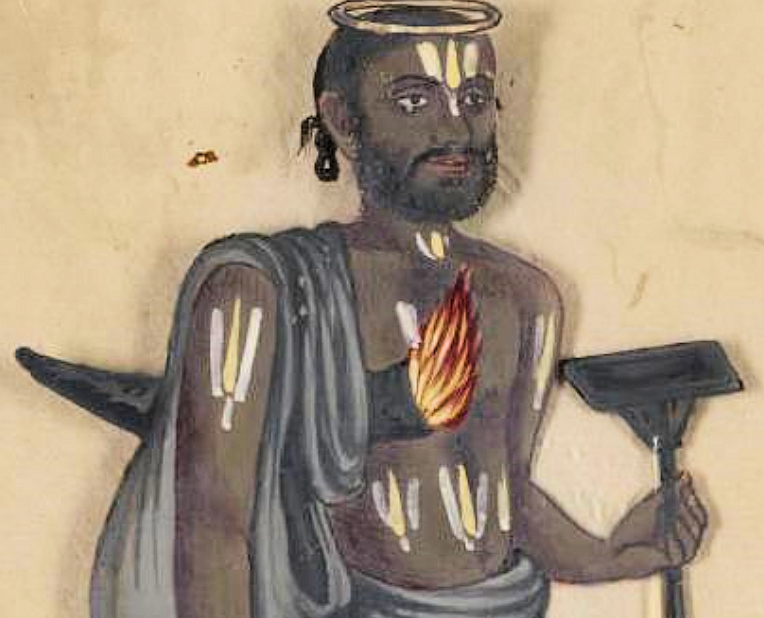
Abb.:
पत्राङ्गुलिः
। Bettler
[Bildquelle: Vardapillai, 1837]
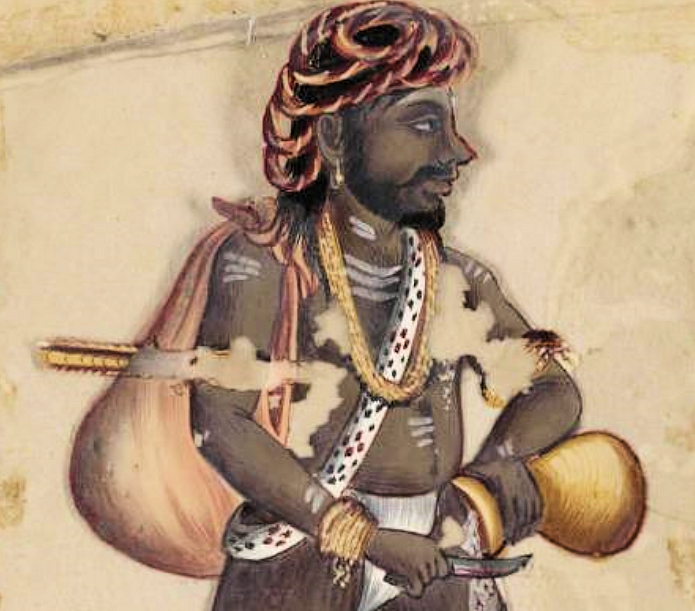
Abb.:
पत्राङ्गुलिः
। Bettler
[Bildquelle: Vardapillai, 1837]
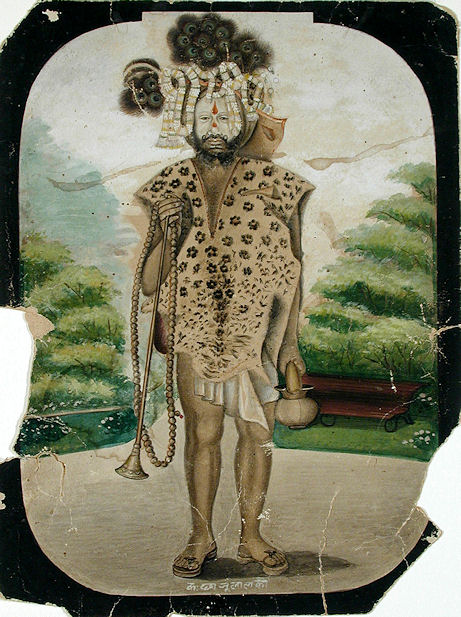
Abb.: पत्राङ्गुलिः
। Sādhu, ca. 1900
[Bildquelle: Asian Curator at The San Diego Museum of
Art. --
http://www.flickr.com/photos/asianartsandiego/4837920847/. -- Zugriff am
2011-03-06. --
Creative Commons Lizenz (Namensnennung, keine kommerzielle Nutzung,
keine Bearbeitung)]
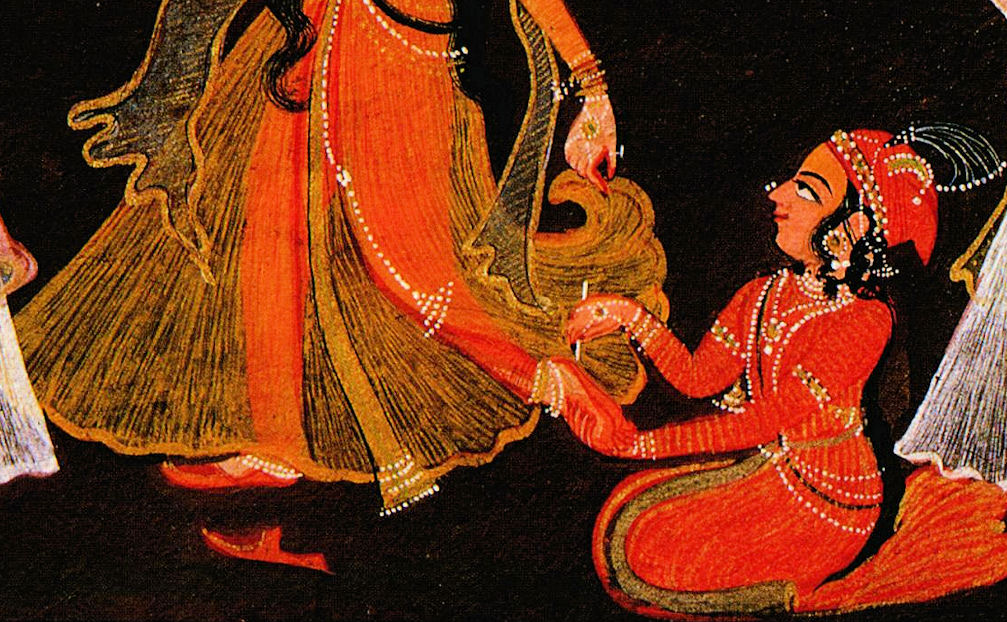
Abb.: पत्राङ्गुलिः
। Bemalen der Füße
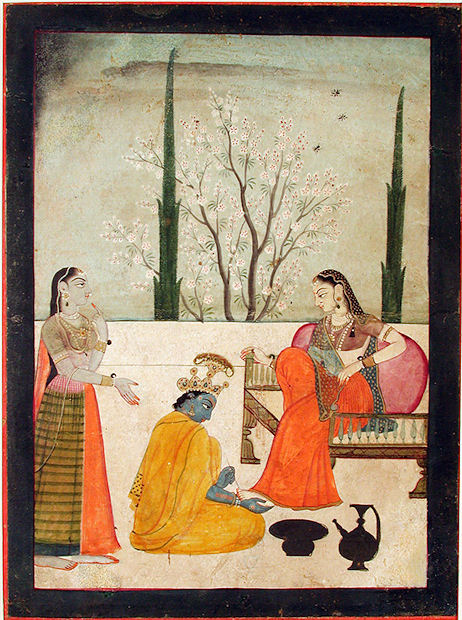
Abb.: पत्राङ्गुलिः
। Kṛṣṇa bemalt Rādhās Füße, Himachal Pradesh, ca. 1760
[Bildquelle: Asian Curator at The San Diego Museum of
Art. --
http://www.flickr.com/photos/asianartsandiego/4838493760/. -- Zugriff am
2011-03-06. --
Creative Commons Lizenz (Namensnennung, keine kommerzielle Nutzung,
keine Bearbeitung)]
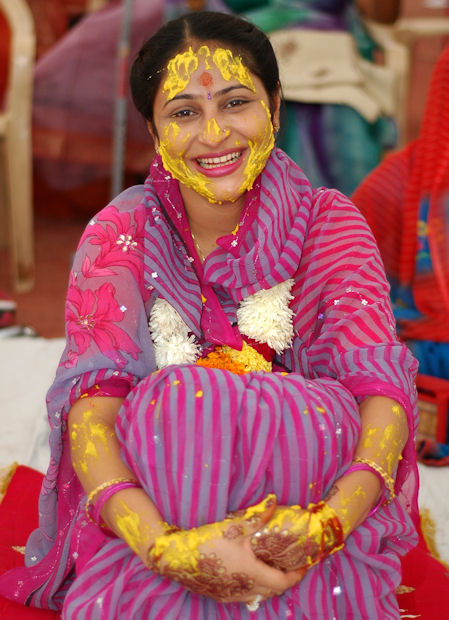
Abb.: पत्राङ्गुलिः
। Bemalung mit Haldi - हल्दी - Curcuma longa L.
1753 - Gelbwurzel - Turmeric, Jodhpur -
जोधाणा,
Rajasthan
[Bildquelle: Shreyans Bhansali. --
http://www.flickr.com/photos/thebigdurian/2200356564/. -- Zugriff am
2011-03-07. --
Creative
Commons Lizenz (Namensnennung, keine kommerzielle Nutzung, share alike)]
Exkurs: Holi - होली
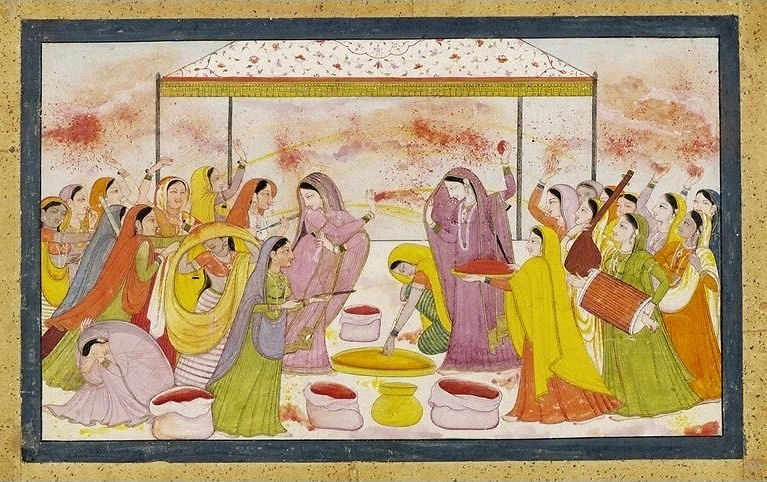
Abb.: होली । Rādhā beim Holi-Fest, ca. 1788
[Bildquelle: Wikimedia. -- Public domain]
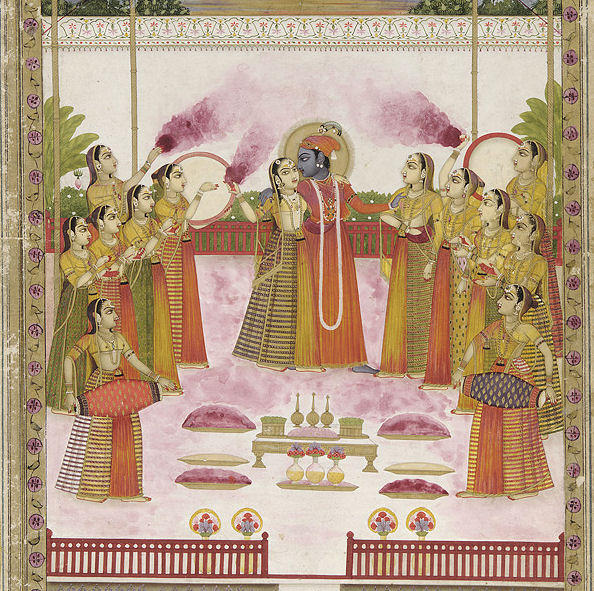
Abb.: होली । Rādhā und Kṛṣṇa beim Holi-Spiel, 19. Jhdt.
[Bildquelle: Wikipedia. -- Public domain]
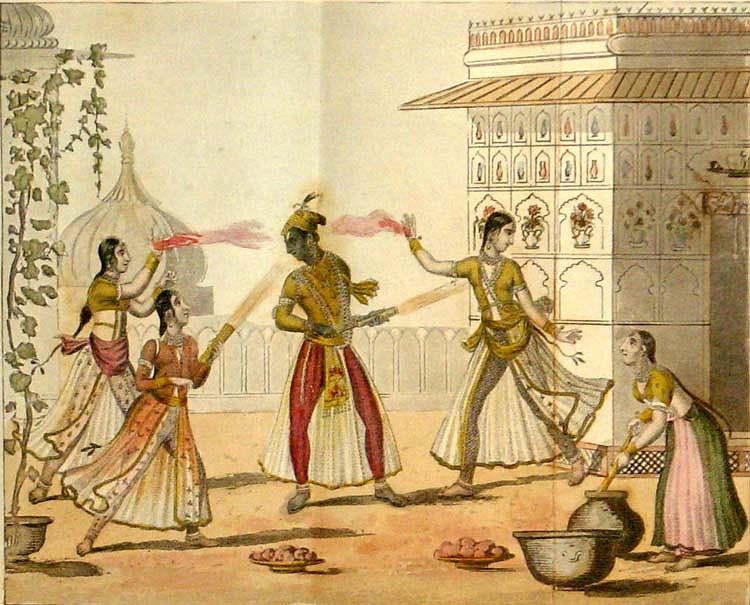
Abb.: Holi - होली, 1820
[Bildquelle: Frederic Shoberl: The world in miniature: Hindoostan, ca. 1820]
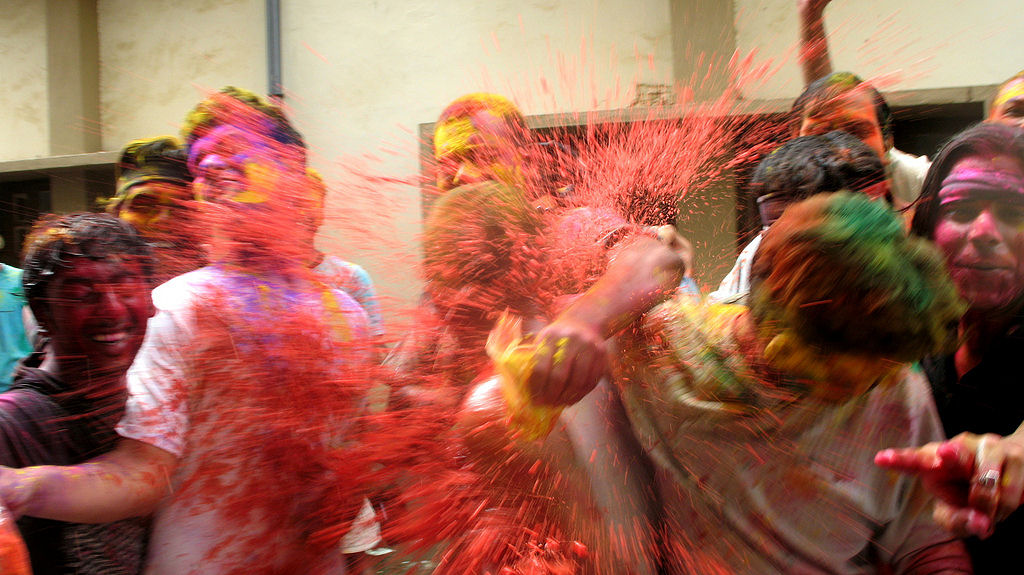
Abb.: होली । Holi - ஹோலி,
Chennai - சென்னை, Tamil Nadu
[Bildquelle: Amre Ghiba. --
http://www.flickr.com/photos/amre/2356414081/. -- Zugriff am 2011-03-07.
-- Creative
Commons Lizenz (Namensnennung, keine kommerzielle Nutzung)]
"HOLI, a popular Hindu festival, called in Sanskrit Holikha, or Phalgotsava, or Hutasham, or Hutasavi, also Dola or Dolavatra, or the Swinging Festival. It is supposed to relate to the vernal equinox, and to be similar to the Persian New Year's day. It is held about the 19th March, or ten days before the full moon of Phalgun. It is in honour of Krishna, and is quite a saturnalia, red powders being thrown and red fluids squirted at passers-by, and licentious songs sung. At the close of the festival, a pile is lighted, and a wheaten cake or Poli offered on it."
[Quelle: Balfour, Edward <1813-1889>: Cyclopædia of India and of eastern and southern Asia, commercial, industrial and scientific: products of the mineral, vegetable and animal kingdoms, useful arts and manufactures / ed. by Edward Balfour. -- 3rd ed. -- London: Quaritch. -- Vol. 2. -- 1885. -- S. 93.]
Unentbehrlich für Farben:
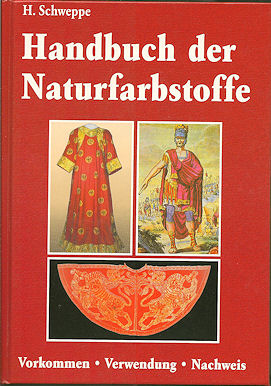
Schweppe, Helmut: Handbuch der Naturfarbstoffe : Vorkommen, Verwendung, Nachweis. -- Sonderausgabe. -- Hamburg : Nikol, 1993. -- 800 S. : Ill. ; 25 cm. -- ISBN 3-933203-46-5. -- [Enthält auch eine vorzügliche Zusammenfassung indischer Färbemethoden.]
Spannend geschrieben, mit vielem auf Indien Bezüglichen:
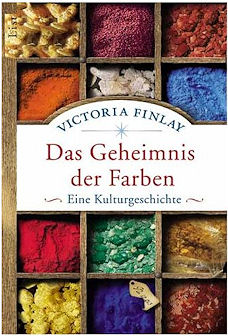
Abb.: Einbandtitel der Taschenbuchausgabe
Finlay, Victoria: Das Geheimnis der Farben : eine Kulturgeschichte. -- München : Claasen, 2003. -- 464 S. ; 22 cm. -- Originaltitel: Colour : travels trough the paintbox (2002). -- ISBN 3-546-00329-2
| 24c./d. tamālapatra-tilaka-citrakāṇi viśeṣakam 25a./b. dvitīyaṃ ca turīyaṃ ca na striyām atha kuṅkumam
तमालपत्र-तिलक-चित्रकानि विशेषकम् ॥२४ ख। [Bezeichnungen für den Punkt auf der Stirn:]
|
Colebrooke (1807): "A circle on the forehead."
1 tamālapatra n.: Cinnamomum tamala (Buch.-Ham.) Nees et C. H. Eberm. 1831; Tamāla m.: Garcinia morella Desr. 1792 - Indian Gamboge Tree - Gummiguttbaum
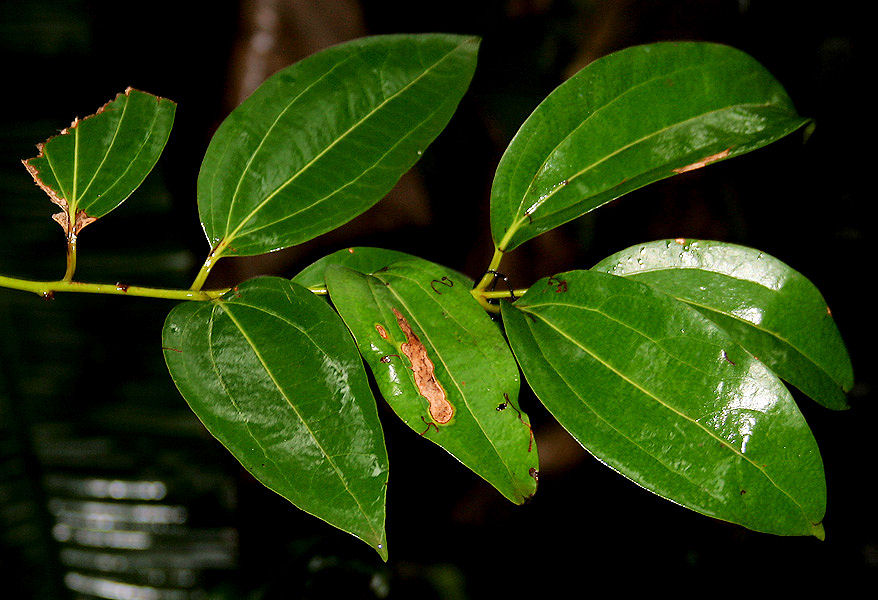
Abb.: तमालपत्रम् - Cinnamomum tamala (Buch.-Ham.) Nees
et C. H. Eberm. 1831
[Bildquelle: J. M. Garg / Wikimedia. -- GNU FDLicense]
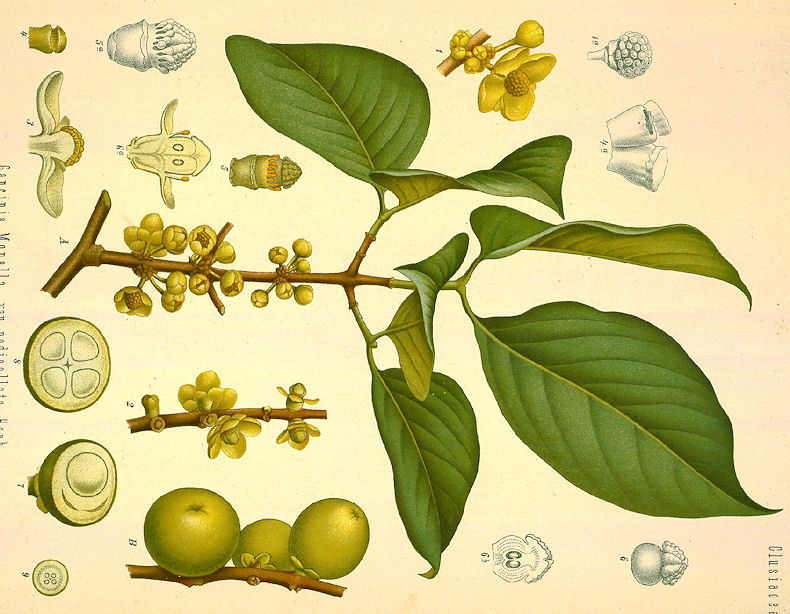
Abb.: तमालः - Garcinia morella Desr. 1792 - Indian
Gamboge Tree - Gummiguttbaum
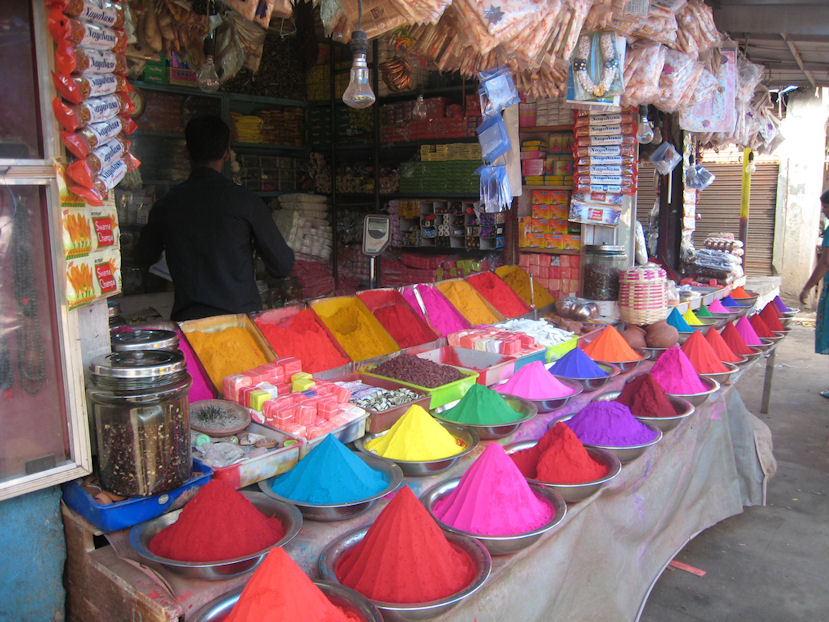
Abb.: Kumkum-Laden - ಕುಂಕುಮ, Mysore -
ಮೈಸೂರು,
Karnataka
[Bildquelle: Ben and Debs
Blench. --
http://www.flickr.com/photos/benanddebsyearoff/2540367271/. -- Zugriff
am 2011-03-06. --
Creative
Commons Lizenz (Namensnennung, keine kommerzielle Nutzung, share alike)]
"Kumkum (Sanskrit कुङ्कुमम् kuṅkumam, Bengali কুমকুম kumkum Tamil குங்குமம் kungumam, Telugu కుంకుమ kumkuma, Kannada ಕುಂಕುಮ Kumkuma), is a powder used for social and religious markings in Hinduism. It is either made from turmeric or saffron. The turmeric is dried and powdered with a bit of slaked lime, which turns the rich yellow powder into a red color." [Quelle: http://en.wikipedia.org/wiki/Kumkum. -- Zugriff am 2011-03-06]
तिलक - tilaka n., m.: Körpermal, Sektenzeichen, Schönheitspunkt (zu tila m.: Sesam, Sesamkorn)
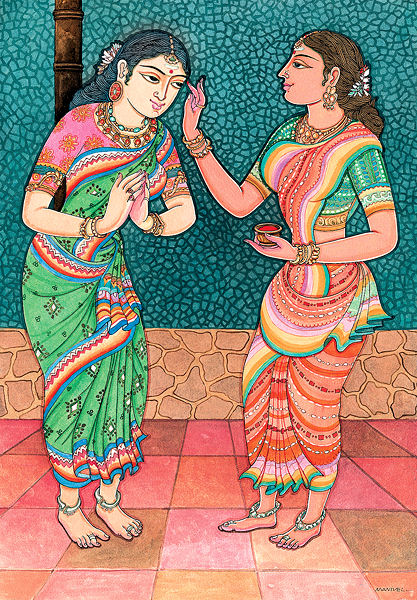
Abb.: तिलकम्
[Bildquelle: Himalayan Academy Publications, Kapaa,
Kauai, Hawaii / Wikimedia. --
Creative
Commons Lizenz (Namensnennung, share alike)]
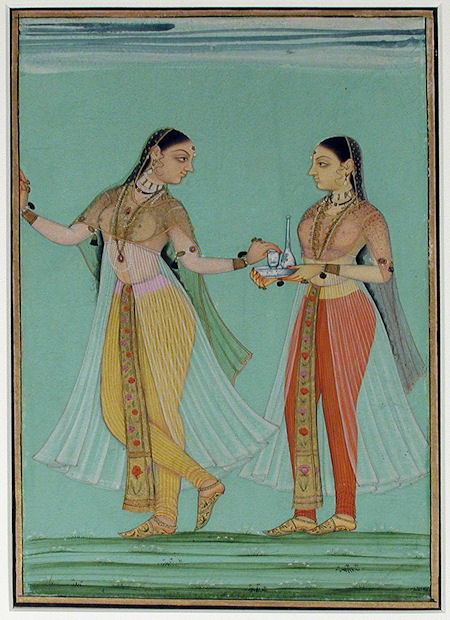
Abb.: तिलके । ca. 1670
[Bildquelle: Asian Curator at The San Diego Museum of
Art. --
http://www.flickr.com/photos/asianartsandiego/4838250342/. -- Zugriff am
2011-03-06. --
Creative Commons Lizenz (Namensnennung, keine kommerzielle Nutzung,
keine Bearbeitung)]
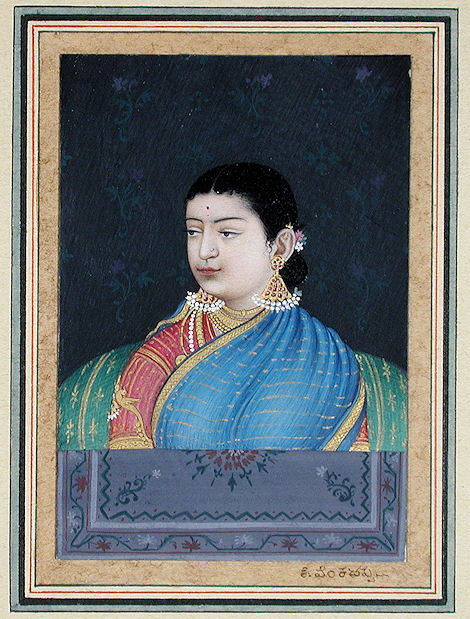
Abb.: तिलकम् । Karnataka, 19. Jhdt.
[Bildquelle: Asian Curator at The San Diego Museum of
Art. --
http://www.flickr.com/photos/asianartsandiego/4838280612/s. -- Zugriff am
2011-03-06. --
Creative Commons Lizenz (Namensnennung, keine kommerzielle Nutzung,
keine Bearbeitung)]
चित्रक - citraka n.: Kennzeichnung, Zeichen, Gemälde (zu citra 3: bunt)
Bindi - बिंदी
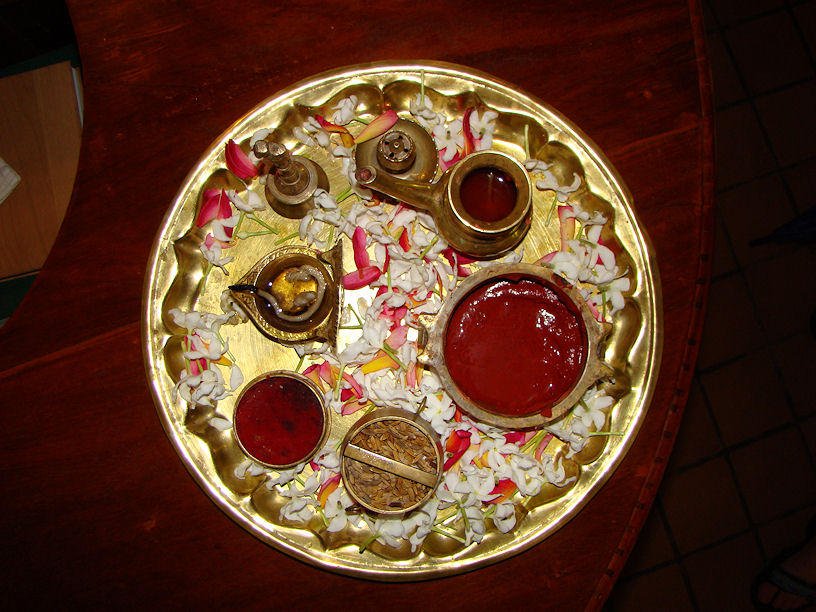
Abb.: Requisiten zum Anbringen eines Willkommens-Bindi
[Bildquelle: Tony. --
http://www.flickr.com/photos/42371658@N00/2378960995/. -- Zugriff am
2011-03-06. --
Creative Commons Lizenz (Namensnennung, keine Bearbeitung)]

Abb.: चित्रकम् । बिंदी । Vandana Shiva - वन्दना शिवा,
Köln, 2007
[Bildquelle: Elke Wetzig / Wikimedia. -- GNU FDLicense]
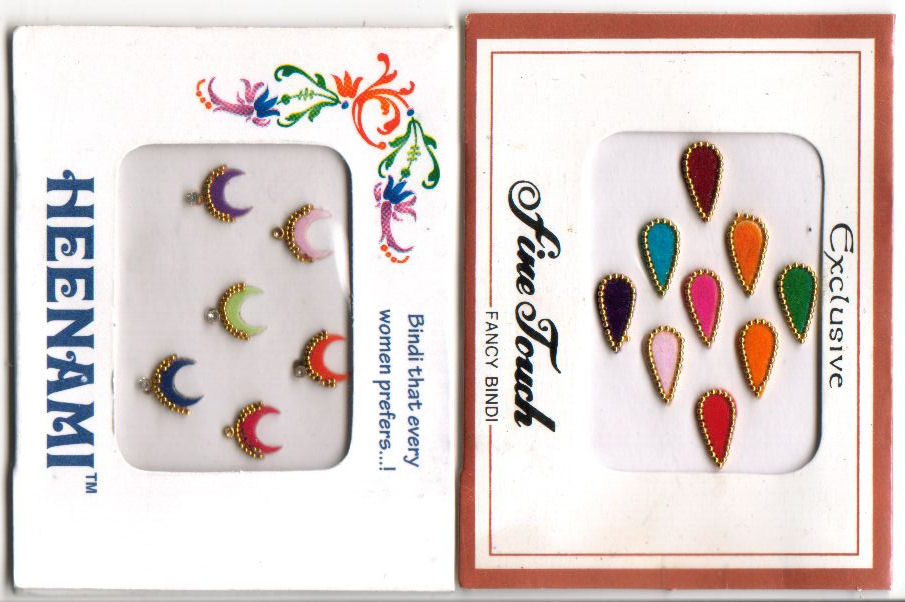
Abb.: चित्रकानि । बिंदी
। Selbstklebende Schmuck-Bindis
[Bildquelle: Neitram / Wikipedia. -- GNU FDLicense]
विशेषक - viśeṣaka n., m.: Unterscheidungskennzeichen, Stirnzeichen
Sindoor - सिन्दूर

Abb.: विशेषकम् । Aufmalen des Sindoor (सिन्दूर) als Zeichen der
verheirateten Frau
[Bildquelle:
Anjana Samant. --
http://www.flickr.com/photos/mydigitalmemory/2427051616/. -- Zugriff am
2011-03-06. --
Creative
Commons Lizenz (Namensnennung, keine kommerzielle Nutzung, share alike)]

Abb.: विशेषकं चित्रके च । Sindoor (सिन्दूर) und Bindi
(बिंदी): Mutter und Kind, Kerala
[Bildquelle:
Aura Beckhofer-Fialho. --
http://www.flickr.com/photos/digitaura/266863534/. -- Zugriff am
2011-03-06. -- Creative Commons Lizenz (Namensnennung,
keine kommerzielle Nutzung, keine Bearbeitung)]
| 25 dvitīyaṃ ca turīyaṃ ca na striyām atha kuṅkumam 25 kāśmīrajanmāgniśikhaṃ varaṃ vāhlīka-pītane 26a./b. rakta-saṃkoca-piśunaṃ dhīraṃ lohitacandanam
द्वितीयं च तुरीयं च न स्त्रियाम् अथ कुङ्कुमम् ।२५। [Bezeichnungen für Crocus sativus L. 1753 - Echter Safran - Saffron Crocus:]
|
Colebrooke (1807): "Saffron. 1 And other terms signifying red or blood."
काश्मीरजन्मन्
- kāśmīrajanman n.: In Kaschmir Gewachsenes
वाह्लीक - vāhlika n. (= bālhīka): von den
Bālhika Stammendes
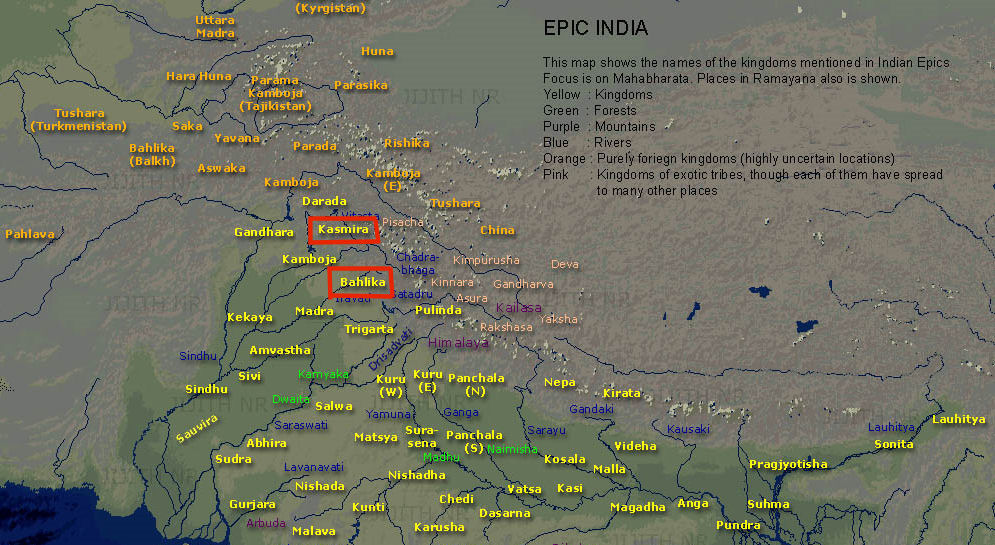
Abb.: Lage der Kaśmīra und Bālhika
[Bildquelle: JIJITH NR / Wikimedia. -- GNU FDLicense]
कुङ्कुम - kuṅkuma n.: Safran
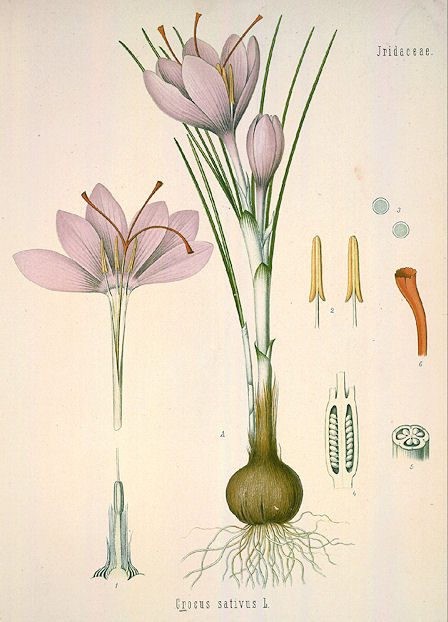
Abb.: कुङ्कुमम्
। Crocus sativus L. 1753 - Echter Safran - Saffron
Crocus
[Bildquelle: Köhler, 1883]
अग्निशिख - agniśikha n.: Feuerflammiges, Safran
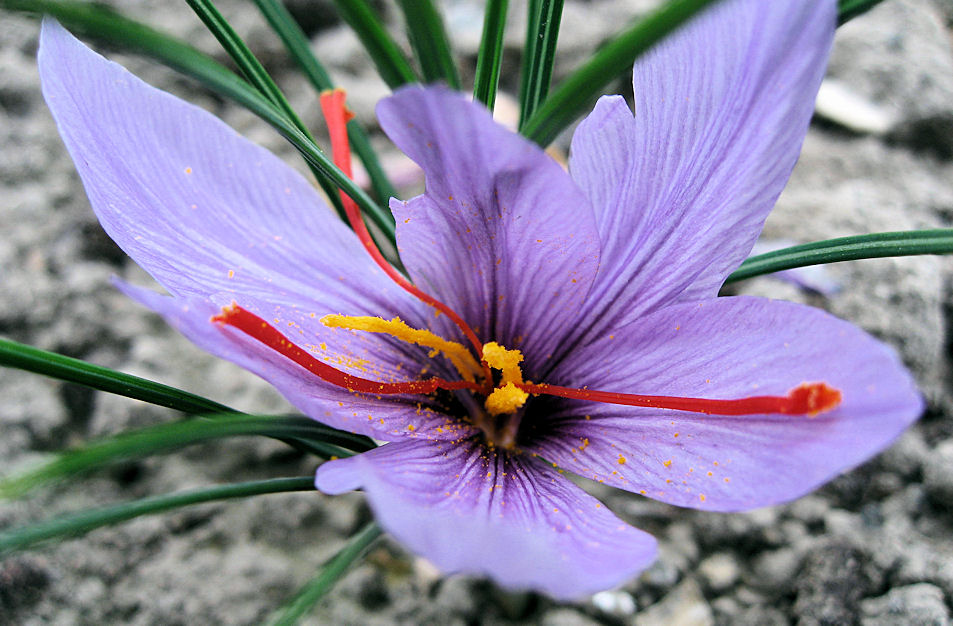
Abb.: अग्निशिखम् । Crocus sativus L. 1753 - Echter Safran - Saffron
Crocus
[Bildquelle: Liné1 / Wikimedia. -- GNU FDLicense]
रक्त - rakta n.: Rotes, Blut
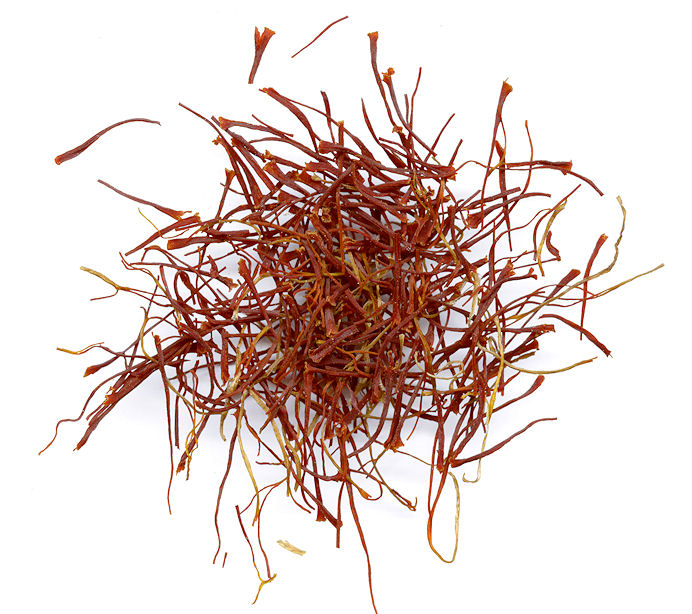
Abb.: रक्तम् । Crocus sativus L. 1753 - Echter Safran - Saffron
Crocus, Getrocknete Safranfäden
[Bildquelle: Rainer Zenz / Wikipedia. -- Public domain]
पीतन - pītana n.: Gelb-Färbemittel, Auripigment, Safran
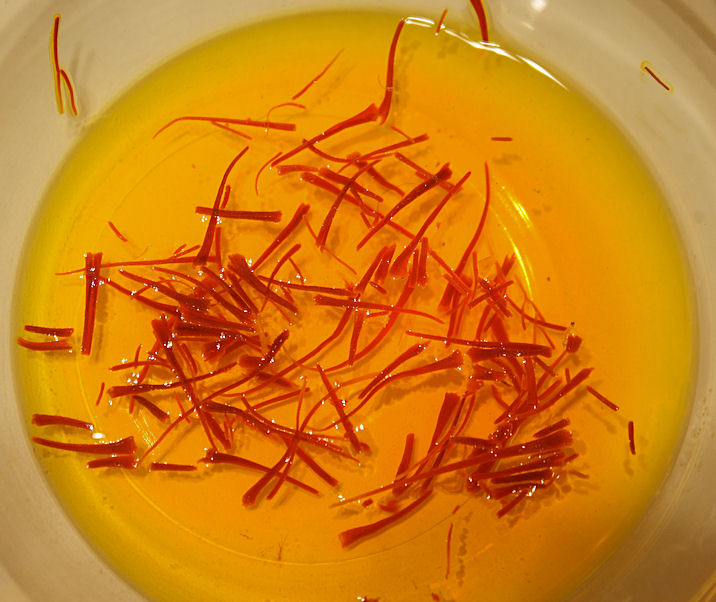
Abb.: पीतनम् ।
[Bildquelle: Alan Sheffield. --
http://www.flickr.com/photos/arsheffield/2368248387/. -- Zugriff am
2011-03-08. --
Creative Commons Lizenz (Namensnennung, keine kommerzielle Nutzung)]
CROCUS SATIVUS, Linn. Fig.—Bentl. and Trim., t. 274; Woodv., t. 259; Royle, Ill., t. 90.
Saffron (Eng.), Saffran (Fr.).
Hab.—Greece, Asia Minor, Persia. Cultivated elsewhere. The stigmas with portions of the styles.
[...]
History, Uses, &c.—Saffron, on account of its brilliant yellow colour, like that of the rising sun, has been especially valued by mankind from the earliest ages ; in Sanskrit it bears the name of Kunkuma (a name also given in India to the red colour prepared from turmeric), and is described as Charu "fair," Vara "suitor," Agnisikha "having a crest of fire," Saurabha " fragrant," Mangalya " propitious," &c. In Persia the word Zard, derived from the Zend, signifies "yellow, and saffron," and the sun is called Zard-ru "yellow or golden- faced," and Zardah-i-kamrān" the fortunate yellow." Saffron is the Karkôm of the Hebrews, a name borrowed from the Persians, and in the Song of Solomon the beauty of the bride is likened to it. Amongst the Greeks κροκος signified both saffron and yellow; Eos or Aurora, the goddess of the morning, is clothed in it, and in Homer she is described as accompanying the Sun throughout the day.
Yellow, and plants having that colour, have also an erotic signification, hence we find them playing an important part in marriage ceremonies and the relations between the sexes : Juno in the Iliad is represented as preparing a bed of saffron and hyacinths when she wishes to tempt Jove, and Jayadeva in the Gita Govinda represents Hari as inviting Radha to repose upon a bed made of the saffron-coloured flowers of the Asoka. The following lines indicate the significance which is attached to this colour in popular estimation in India: —
Sānjh suni piyā āvan piyāri, sundar nāri singār banai,
Piar kesar, piar besar, piar hār liya larkai,
Piar chir diyo kamlāpati, piar chandan de lagai,
Piar pān ki biri lagi, piyāri piri bhai, piu nahin ai."The loved one heard that her lover would come in the evening, and made a grand toilette: yellow saffron, a yellow nose-ring, and a threaded necklace of yellow flowers. She has donned a yellow robe, applied yellow sandalwood, and placed ripe yellow betel leaves in her mouth. The damsel herself has grown yellow waiting for a lover who has not come."
The Grecian Hetairae and also effeminate youths used to wear the κροκωτος, or "saffron-coloured garment," and the Arabs relate that Abu Jahl dyed his ist with saffron, and was addicted to the enormity, termed ubnah. He was a great enemy of the Prophet's, and is promised in the Koran a taste of Hell. A similar use of saffron by the libidinous old witch Zatel-Dawahi is mentioned in the 93rd night of the Arabian Nights :
Magic properties are ascribed to saffron in Persia; Haji-Zein-el-Attār (1368) states that it is called Jādū-i-dihkān, "peasant's . magic,' and that pregnant women wear a ball of it, about the size of a walnut, at the pit of the stomach to ensure speedy delivery and expulsion of the after-birth. The saffron bag was not unknown in Europe in the Middle Ages, and even later. The Arabs believe that saffron kept in the house will drive away the lizard called Sam Abras, which they greatly dread ; they also say of a man who is melancholy or a little odd innahu lafi sufrihi, i. e. that he is in a state in which he requires to be rubbed with saffron.
Zardāb, or saffron water, is considered to have magical virtues in Persia, and we hear Indian conjurors ascribe the same virtues to turmeric water when they say Pihalad āni ho gora in the sense of "Hocus Pocus," &c. Saffron ink is used in India to write Mantras with. That auspiciousness is attributed to these plants on account of their colour, and not on account of any inherent properties, is shown by the fact that other plants furnishing yellow dyes are considered auspicious. In Persia Delphinium Zalil is much esteemed as a yellow dye, and is even brought to India for that purpose, where it bears the Sanskrit names of Trāyamāna "preserving," Mangalya "auspicious," &c: It is quite possible that this plant was used in ancient Iran before saffron, as the word trāyamāna occurs in old Persian with the meaning of "yellow." Dr. Aitchison speaks of D. Zalil as very common in Khorasan, and remarks that when in flower it gives a wondrous golden hue to the pastures.
A yellow Colour is considered most auspicious in the East's Vasanta, or Spring, and Krishna are represented as clothed in this colour, and Vasanti-coloured garments are worn at the Basant panchami in many parts of India; at this season also garlands of yellow flowers are offered. This custom is alluded to in the Bāramāsa, where the wife says:—
Nahin ghar kanth, leke basant ai ghar mālan,
Main kaise pūjūn, sakhi, nahin ghar sājan."My husband is away, and the gardener's wife has brought (yellow) spring flowers. How can I make an offering, my dear, when my beloved is absent?"
A yellow garment, called Basanti, was worn by the Rajputs when about to sacrifice themselves in a desperate conflict, a sacrifice to their supposed ancestor Surya (the sun). Yellow is the favourite colour of the Buddhists, and the Sakya family was a branch of the great Solar race of Gautama. Sénart considers that the Buddha is the Sun-god, and that the details of his life have been taken from Solar mythology.
The use of saffron and turmeric for colouring and flavouring food is universal throughout India, and saffron is still used for this purpose in Germany, Switzerland, and in Cornwall, cakes made on festive occasions being coloured with it. There is a curious story about saffron-coloured rice in the Persian Burhān, where it is called Birinj-i-shamālah, "candle rice." The author relates that in former times there was a cook at Shiraz, who was in the habit of sitting by the roadside every evening and preparing a dish with yellow rice, before which he lighted two lamps, or sometimes two torches, and cried out—" Come to the rice of the candle," and repeated the following couplet : —
"The lights which burnt in the heart of Bushāk were kindled by the passing of the light of the rice of the candle."
Who was Bushāk, or Bashāk ? We cannot help thinking that he must have been some sturdy fire-worshipper testifying, as far as he dared, in the presence of a Mahomedan population, to his ancient faith. As the story was an old one when the Burhān was written, it shows at any rate that the use of saffron- coloured rice in Persia is of great antiquity. The earliest European travellers in India called turmeric Crocus indicus, "Indian saffron," and evidently regarded it as a substitute for that article. In those days saffron was of much more importance in Europe than it is now, and the punishment for adulterating it was death.
Saffron was much employed by the Romans for seasoning food, and to make an essence with wine and water which was used as a perfume (Pliny, 21, 6, 17; Lucretius, ii., 416; Ovid A. A. 104, &c.). The name Zāfarān occurs in the Sihāh of El Jowhari who wrote in the 10th century, and from Arabian writers (Istakhri, Edrisi) we learn that it was cultivated at this time in Persia at Darband and Ispahān. It is not improbable that the plant was carried from that country to China, as, according to the Chinese, it was introduced by Mahometans. Chinese writers have recorded that under the Yuen dynasty (A. D. 1280—1368) it became the custom to mix Sa-fa-lang (Zāfarān) with food (Bretschneider, Chinese Botanical Works, Foochow, 1870). Saffron appears to have been cultivated in Spain in the 10th century. The Rāja Nirghanta, which was written about 600 years ago by a native of Cashmere, speaks of saffron as coming from Cashmere, and the plant is still cultivated there on the Kareewahs near Pampur ; the plants are arranged in parterres, and flower about the end of October; the inhabitants of the district are then summoned to gather the crop; during this time they live in the gardens which are guarded by police to prevent theft (Ince, Handbook of Cashmere).
The earliest medical writers mention saffron, and describe it as cardiacal and aphrodisiacal, improving the complexion, increasing the brilliancy of the eyes, and promoting the delivery of women. They also considered it to be diuretic, astringent, deobstruent, and emmenagogue. Saffron, formerly as highly esteemed in Europe as in the East, is still considered by some European physicians to have emmenagogne properties, but is generally regarded as a colouring and flavouring agent only. Saffron has recently been deleted from the drug list of the Medical Store Depôts in Bengal. For much interesting information concerning the early history of saffron in Europe, we would refer our readers to the Pharmacographia of Flückiger and Hanbury."
[Quelle: Pharmacographia indica : a history of the principal drugs of vegetable origin met with in British India / by William Dymock [1834-1892], C. J. H. Warden and David Hooper [1858-1947]. -- Bd. 3. -- London, 1893. -- S. 453ff.]
| 26c./d. lākṣā rākṣā jatu klībe yāvo 'lakto drumāmayaḥ लाक्षा राक्षा जतु क्लीबे यावो ऽलक्तो द्रुमामयः ॥२६ ख॥ [Bzeichnungen für Lack:]
|
Colebrooke (1807): "Lac. [jatu:] One author disjoins this from the preceding and following terms. Some distinguish the four last terms ; others, the three last, from the preceding : the distinction seems to be the gum or resin discriminated from the dye of the insect."
Lack ist das Produkt folgender Lackschildläuse:
लाक्षा - lākṣā f.: Lack
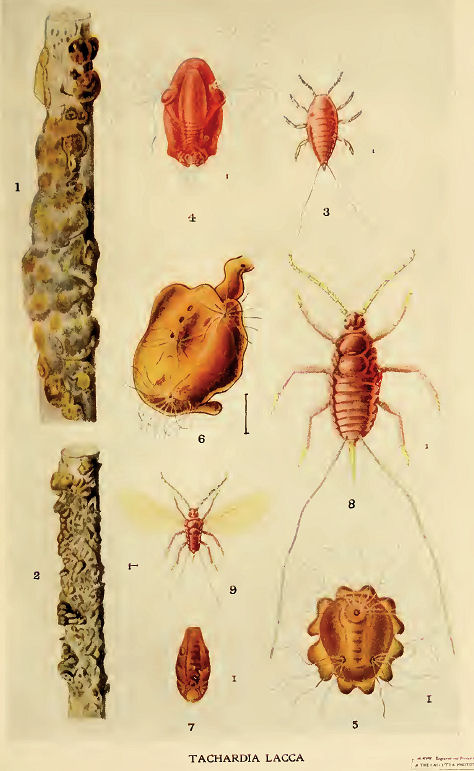
Abb.: लाक्षा । Kerria lacca Kerr, 1782 - Lackschildlaus -
Lac-insect
[Bildquelle:
Maxwell-Lefroy, H. (Harold)
<1877-1925>: Indian insect life : a manual of the insects of the plains (tropical
India). -- Calcutta, 1909. -- Pl. LXXXIII.]
द्रुमामय - drumāmaya m.: Baum-Krankheit
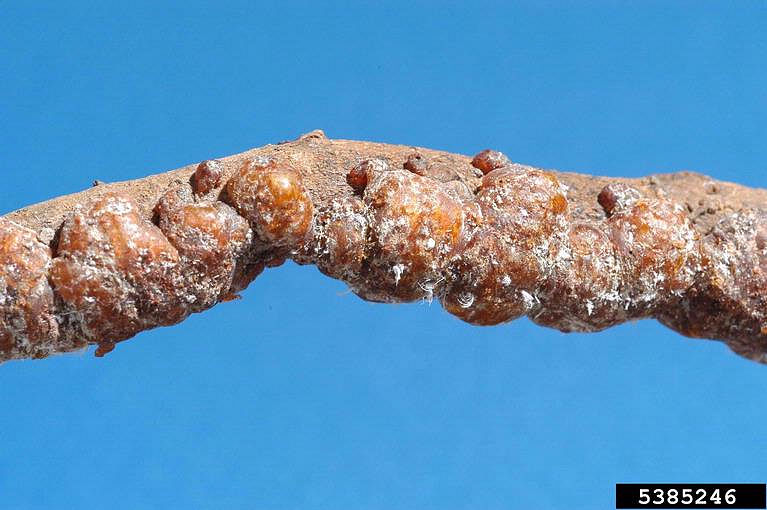
Abb.: द्रुमामयः । Kerria lacca Kerr, 1782 - Lackschildlaus -
Lac-insect
[Bildquelle: Jeffrey W. Lotz, Florida Department of Agriculture and Consumer
Services, Bugwood.org. --
Creative Commons Lizenz (Namensnennung)]
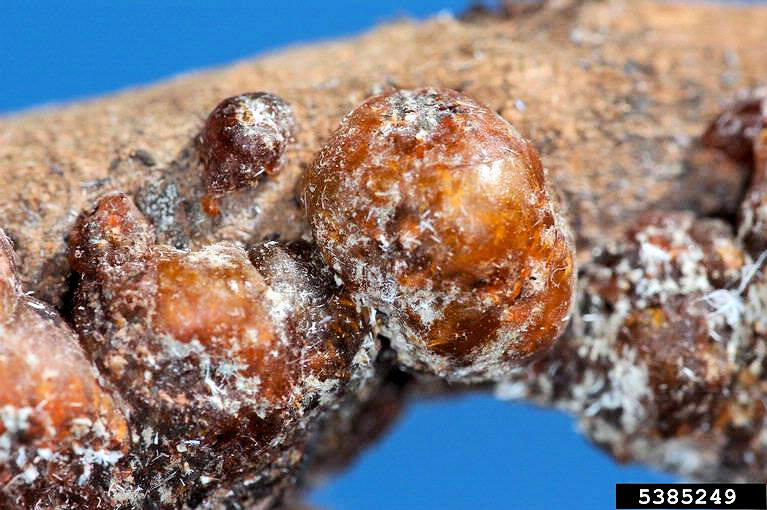
Abb.: द्रुमामयः । Kerria lacca Kerr, 1782 - Lackschildlaus - Lac-insect
[Bildquelle: Jeffrey W. Lotz, Florida Department of Agriculture and Consumer
Services, Bugwood.org. --
Creative Commons Lizenz (Namensnennung)]
जतु - jatu n.: Lack, Gummi
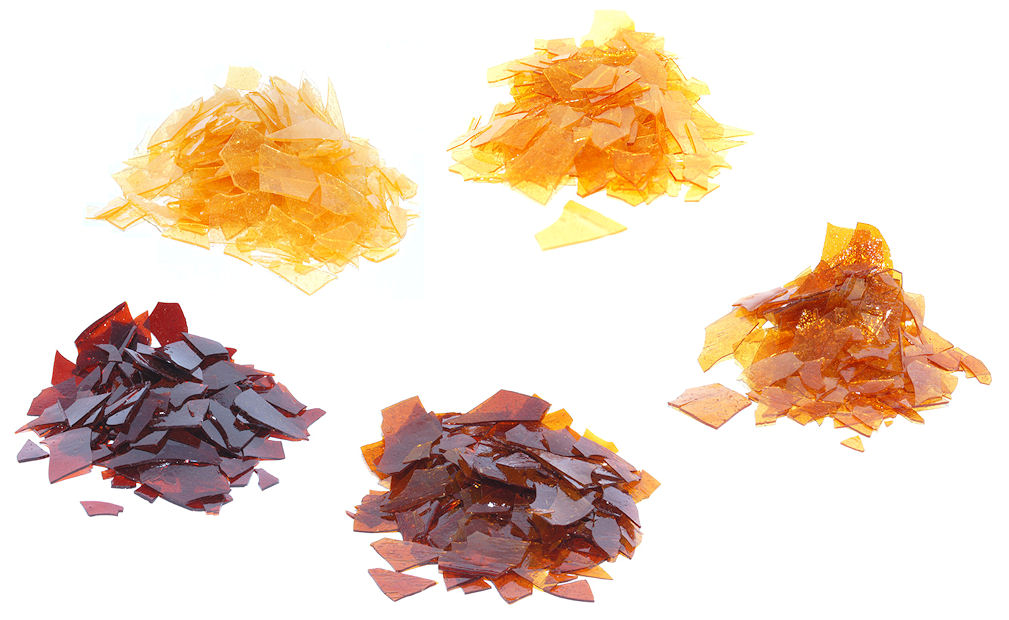
Abb.: जतु । Schellack, verschiedene Sorten
[Bildquelle: Nuberger13 / Wikimedia. -- Public domain]
"LAC.
[...]
Lac is obtained from incrustations made by an insect (Coccus lacca), similar to the cochineal (Coccus cacti), on the branches and twigs of the Acacia Arabica, A. concinna, Aleurites laccifera, Anona squamosa, Butea frondosa, Carissa spinarum, Celtis, sp., Croton draco, C. lacciferum, C. sanguiferum, Dicrostachys cinerea, Erythrina Indica, E. monosperma, Feronia elephantum, Ficus Indica, F. infectoria, Gyrocarpus Asiaticus, Inga dulcis, Mimosa cinerea, Rhamnus jujuba, Schleichera trijuga, Terminalia tomentosa, Urostigma religiosum, U. elastica, Vatica laccifera, Vismia laccifera ? V. micrantha ? Zizyphus jujuba.
The Coccus genus of insects belongs to the order Hemiptera. The species known in the south and east of Asia are the C. cacti or cochineal insect ; the C. lacca that yields the lac of commerce ; C. maniparus of Arabia, which punctures the Tamarix gallica, and causes the exudation of the Arabian manna ; and C. Sinensis of China, that secretes a wax from which candles are made. When the females of the C. lacca have fixed themselves to a part of the branch of the trees on which they feed, a pellucid and glutinous substance begins to exude from the margins of the body, and in the end covers the whole insect as with a cell of this substance, which, when hardened by exposure to the air, becomes lac. So numerous are these insects, and so closely crowded together, that they often entirely cover a branch; and the groups take different shapes, as squares, hexagons, etc, according to the space left round the insect which first began to form its cell. Under these cells the females deposit their eggs, which after a certain period are hatched, and the young ones eat their way out. The accumulation of insects is so great that the trees on which they live are exhausted and injured by them. The parent lac insect, after laying her eggs, becomes a mere lifeless bag, of an oval shape, containing a small quantity of a beautiful red liquid. The young insects feed on this liquid, and their bodies assume the same hue, so that the branch which bears them appears to be covered with red powder. The cells of gum-lac which shelter them are more deeply tinged with the same colour.
The best time for gathering stick-lac so as to secure the colouring matter, is before the insects have made their escape. In some places the insect is sedulously cultivated, the modus operandi being the very simple one of cutting off old branches inhabited by it, and tying them to fresh branches ; in other places nature is left to accomplish the work unaided. That a great deal may be done to extend the industry, is evident from the success which has attended its introduction into the territory of Kapurthala, where three maunds of seed were transported safely from so distant a locality as Oudh. The forests of Burma alone are capable of producing an almost unlimited quantity, if plantations are only formed.
The cells made by the insect for its eggs adhere to the branches in grains, completely encrusting them, and, in commerce, are either imported in that form, and called 'stick-lac,' or the grains are gathered from the branches, their colouring matter extracted, and formed into flat cakes, still preserving the granular appearance, and called 'seed-lac,' or the seed-lac is melted up into masses, and called 'lump-lac.' 'Shell-lac' is seed-lac further purified by being put in bags of fine linen, and melted over a charcoal fire until it passes through them. The bags are squeezed, and passed over a smooth surface of wood, on which the lac is deposited in thin layers. If pure, this kind of lac will take fire on a hot iron, and burn with a powerful smell. The heat of a ship's hold will sometimes run it into a solid mass, and thus diminish its value. By pouring warm water on stick-lac, a crimson colouring matter is obtained, which is made into square cakes for sale, and called lac dye, lac lake, or cake lake. These cakes, when broken, are dark-coloured, shining, and compact, but when scraped they yield a bright red powder approaching carmine.
The best quality of stick-lac is obtained from Siam, the twigs being frequently encrusted all round to the depth of a quarter of an inch, while sometimes a great accumulation takes place on one spot; that of Assam ranks next; the stick-lac of Bengal is inferior to these, being scanty and irregular in its coating of resinous matter.
The largest export is from the Central Provinces, but it is also produced in considerable quantity in Assam, and in the Gaya and Hazaribagh districts, in Oudh, the North-Western Provinces, the Punjab, and a limited portion of Sind, in Maisur, and in British Burma. The lac which is so largely exported from Burma is obtained chiefly in the Shan districts, and is perhaps the finest in the world, preferable even to that of Bengal. The jungle at Taldungah consists chiefly of thorny bushes, jujube of two species, an Acacia and Butea frondosa, the twigs of the latter often covered with lurid red tears of lac, which is there collected in abundance.
The supply of lac from among the mountains of India could support a consumption ten times greater than at present. In Cuttack, Travancore, Mysore, and most of the Madras districts, it is found in considerable abundance.
Previous to the discovery of the true cochineal, the colouring matter of the lac insect was universally employed for dyeing red. The crimsons of Greece and Rome, and the imperishable reds of the Brussels and Flemish schools, were obtained from this source.
A mixture of lac, alum, and tamarind-water is the native dye for silk or cotton cloth of a crimson colour.
After the dye is extracted, the gum-lac still requires much purification before it can be used for the more delicate varnishes. A premium of 30 guineas and a gold medal were offered by the Society of Arts for a varnish made from shell or seed lac, equally hard, and as fit for use in the arts, as that prepared from any other substance. These were claimed by two persons, Mr. Field and Mr. Luning, and as both their processes were found to answer the desired end, a premium of 20 guineas was awarded to each.
The chief consumption of lac in Europe is for the manufacture of sealing-wax and varnishes. In India the inferior kind is made into bangles or armlets for women of the lower classes, the superior is fashioned into rings, beads, and other trinkets. To fit it for such purposes, the natives purify it by melting in bags. When the lac begins to exude, it is scraped off, and the bags are twisted or wrung by means of cross sticks at their ends, to force out the melted contents.
The natives of India make a good varnish of lac, coloured with cinnabar or some other pigment, with which they varnish boxes, cabinets, and other articles. Coloured varnishes of this description are much used in the adornment of their religious houses.
Lac and sandarach form the basis of spirit varnishes ; these resins are more soluble than amber, anime, and copal. They are dissolved in spirits of wine, or pyroligneous spirit, which is cheaper. Lac is harder than sandarach, and is the basis of most lacquers, and also of French polish. Sandarach is used for making a pale varnish for light-coloured woods. It may be hardened by the addition of shell-lac or of mastic if required to be kept pale; and when required to be polished, Venice turpentine is added to give it body.
The Indian lapidaries make use of lac as a vehicle for retaining the hard corundum powders used in cutting and polishing gems, and as laps.
Lac enters into the composition of the best Chinese lacquer, - gamboge or dragon's blood, with copal, being added to increase the colour.
[...]
The name lac or laksha is derived from the word signifying a hundred thousand, from the great number of the insects which swarm over the tree.
It is the female insect of the Coccus lacca that produces the resin and the dye. This is a small, round, red-coloured, flat insect, having 12 abdominal rings, and a bifurcated tail. The male is much larger than the female, and is furnished with wings. It is stated that no more than about one male to 5000 females is to be met with. The female insect is said to be destroyed in the process of producing her young ones, for the eggs become hatched beneath the mother insect within the concrete resin globule, and escape by boring through the mother's back. At first, the young brood, having made its escape, clusters on the twigs of the trees, and very shortly afterwards the incrustation of lac begins to be formed over and round them, covering the twigs. The bubble-like exudations are all close together, and hollow and cellular inside. About the end of March the lac-resin exudation is complete, and the female insects within are glued down by it to the tree. The oval body of the insect becomes of a deep-red colour. If at this stage a little piece of the lac incrustation on a twig be broken off, the insect is perceived as a little bag of red liquid (which yields the dye), and the place where the wood of the twig has been punctured bears a snow-white mark, as if the place had been touched with a point of chalk. On removing an entire piece of lac incrustation from the twig, the bark underneath is observed to be covered with these little white dots, one in every cell and one under every insect ; under the microscope they clearly appear to be specks of a semi-crystalline saline efflorescence at the place punctured by the insect.
The proper stage to collect the lac (if intended to produce dye) is when the insect is in the stage of being like a soft red sac. At a later stage it lays its eggs under its body, which is glued down by the resin ; when, therefore, the eggs are hatched, they have no means of egress save by eating through the body of the mother, which they do, feeding the while on the red colouring matter contained in her body, which is thus consumed.
When the lac is first gathered, it is picked off the twigs with the insects and all on it. In this state it is called 'kacha' or 'kham lakh.' This lac is treated with water, and thus the colouring matter is extracted. The clarified kind of lac is called 'chapra-lakh,' or shell-lac, chapra, a shell."
[Quelle: Balfour, Edward <1813-1889>: Cyclopædia of India and of eastern and southern Asia, commercial, industrial and scientific: products of the mineral, vegetable and animal kingdoms, useful arts and manufactures / ed. by Edward Balfour. -- 3rd ed. -- London: Quaritch. -- Vol. 2. -- 1885. -- S. 646ff.]
| 27a./b. lavaṅgaṃ devakusumaṃ śrīsaṃjñam atha jāyakam लवङ्गं देवकुसुमं श्रीसंज्ञम् अथ जायकम् ।२७ क। [Bezeichnungen für Syzygium aromaticum (L.) Merr. et L. M. Perry 1929 - Gewürznelkenbaum - Clove Tree:]
|
Colebrooke (1807): "Cloves. Or any other name of Lakṣmī."
श्रीसंज्ञ - śrīsaṃjña: Śrī (Glück) und andere Bezeichnungen für Lakṣmī / Glück
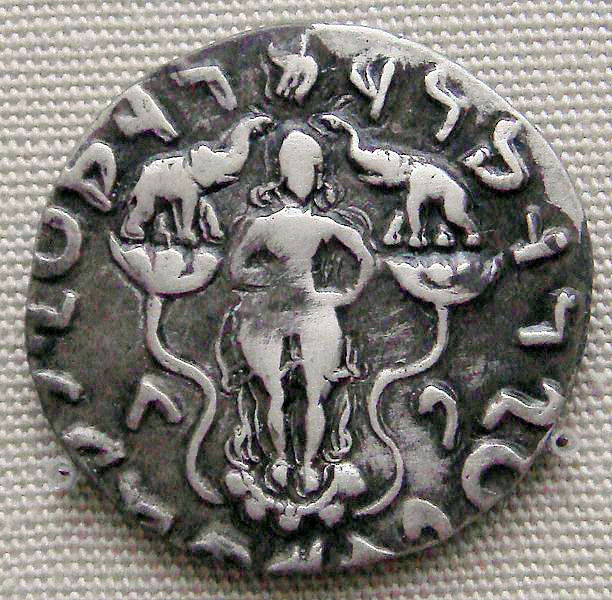
Abb.: गजलक्ष्मी । Gandhara, 1. Jhdt. v. Chr.
[Bildquelle: Uploadalt / Wikipedia. -- GNU FDLicense]
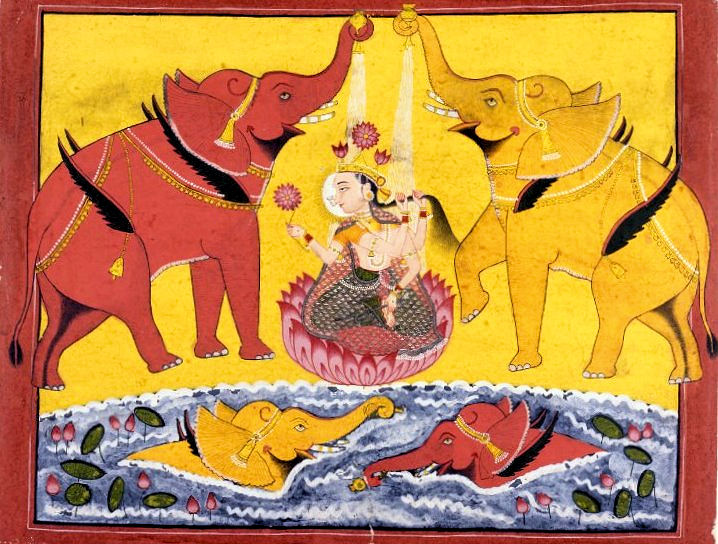
Abb.: गजलक्ष्मी । ca. 1780
[Bildquelle: Wikipedia. -- Public domain]
लवङ्ग - lavaṅga n.: Syzygium aromaticum (L.) Merr. et L. M. Perry 1929 - Gewürznelkenbaum - Clove Tree, Gewürznelke
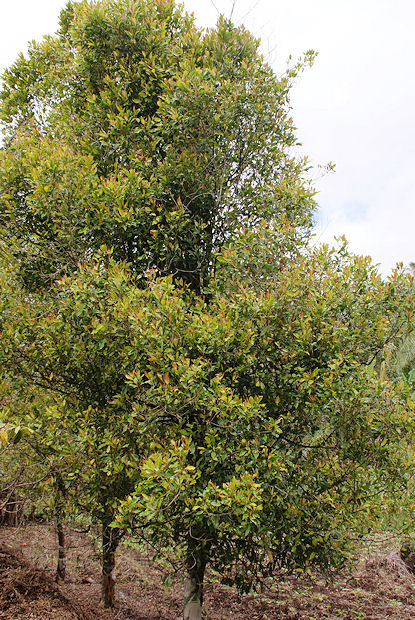
Abb.: लवङ्गम् । Syzygium
aromaticum (L.) Merr. et L. M. Perry 1929 - Gewürznelkenbaum - Clove
Tree, Sulawesi, Indonesien
[Bildquelle: Midori / Wikimedia. -- GNU FDLicense]
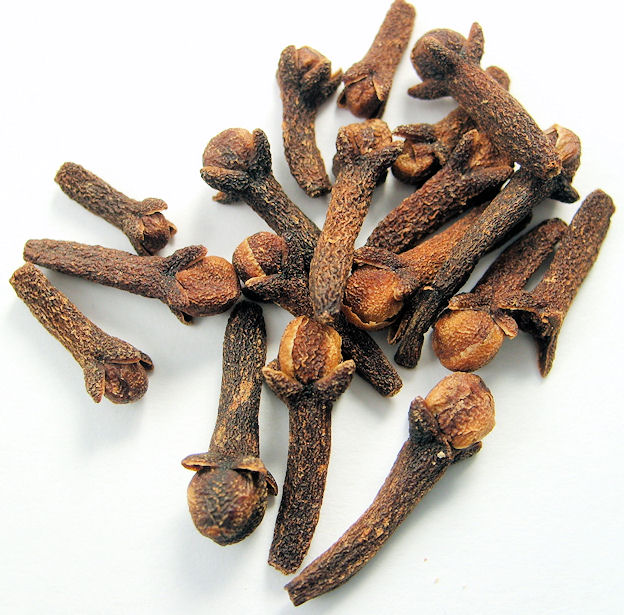
Abb.: लवङ्गम् । Getrocknete Gewürznelken
[Bildquelle: Jorge Barrios / Wikimedia. -- Public domain]
देवकुसुम - devakusuma n.: Götter-Blume
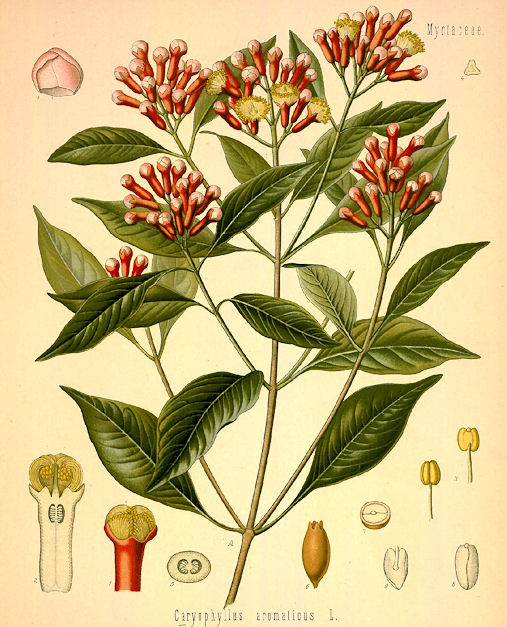
Abb.: देवकुसुमम् । Syzygium
aromaticum (L.) Merr. et L. M. Perry 1929 - Gewürznelkenbaum - Clove
Tree
[Bildquelle: Köhler, 1883]
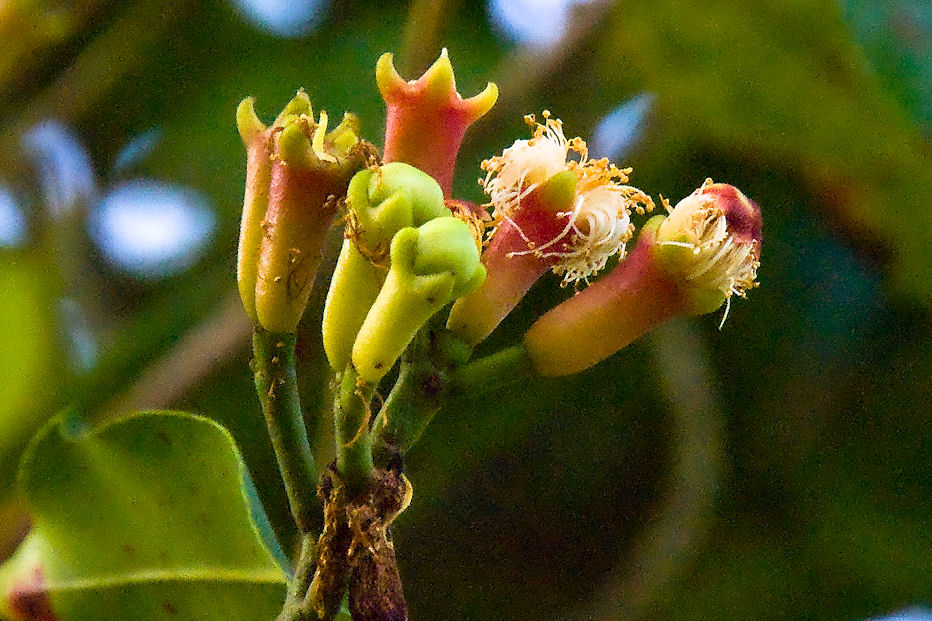
Abb.: देवकुसुमम् । Syzygium
aromaticum (L.) Merr. et L. M. Perry 1929 - Gewürznelkenbaum - Clove
Tree
[Bildquelle:
Hafiz Issadeen. --
http://www.flickr.com/photos/yimhafiz/5375106402/. -- Zugriff am
2011-03-03. --
Creative
Commons Lizenz (Namensnennung, keine Bearbeitung)]
"CARYOPHYLLUS AROMATICUS, Linn.
Fig.—Bentl. and Trim., t. 112.
Clove tree (Eng.)
Hab.—Moluccas, cultivated elsewhere.
[...]
History, Uses, &c.— The clove tree is said to be indigenous only in the five small islands, which constitute the Moluccas proper, viz., Tarnati, Tidori, Mortir, Makiyan and Bachian. It was afterwards introduced into other neighbouring islands, where it is now cultivated, and at a later period into Zanzibar and Pemba on the East coast of Africa. Cloves appear to have been known in China as early as B.C 266. At that time it was customary for the officers of the court to hold the spice in the mouth before addressing the sovereign in order that their breath might have an agreeable odour. (Pharmacographia.) It is difficult to say when they were first introduced into India, but they are mentioned by Charaka, who is considered to be the oldest Sanskrit medical writer, under the name of Lavanga, a name which, with various modifications, is applied to cloves all over India. They are regarded by Sanskrit writers as light, cooling, stomachic, digestive and useful in thirst, vomiting, flatulence, colic, &c., and are prescribed with other spices and with rock salt. (Dutt's Hindu Materia Medica.) A paste of cloves is applied to the forehead and nose as a remedy for colds. A clove roasted in the flame of a lamp and held in the month is a popular remedy for sore throat. The early Arabian writers call them Karanfal, a name evidently derived from the Indian languages of the Malabar Coast, Ceylon, and the Straits ; this name appears to us to have been the source from whence the Greeks have derived the name καρνοφυλλον which we meet with in Galen and Pliny; the latter writer speaks of Caryophyllon as resembling pepper but longer and more brittle and imported for the sake of its odour. We do not think it possible that a spice in such common use in the East can have escaped their notice. Paulus describes cloves as the flowers of a tree, and καρφιοειδη (like a nail). Myrepsicus in a prescription calls mother cloves γαρεοφαλον το μεγα το λεγομενον παρ ιταλοις ανθοφαλον. In the debased Greek of the later Greek physicians, the name takes various forms more nearly corresponding to the Arabic. Later Arabian and Persian authors of treatises on Materia Medica describe cloves as the fruit of a tree growing in Java or Batavia, a territory belonging to the Dutch Christians. In the Makhzan-el-Adwiya, a work written about one hundred years ago, it is distinctly stated that they are only produced in the Dutch possessions, and that they are of two kinds, male and female. The fruit of the clove is called Nar-laung (male clove) in India, a strange mistake but a common one among Asiatics, who argue that the seed-bearing organ or plant must be the male. Mahometan writers describe cloves as hot and dry, and consider them to be alexipharmic and cephalic, whether taken internally or applied externally; they also recommend them for strengthening the gums and perfuming the breath, and on account of their pectoral, cardiacal, tonic, and digestive qualities. They have a curious superstition to the effect that one male clove eaten daily will prevent conception. On the other hand, they tell us that the saliva after cloves have been chewed, if applied to the orifice of the male urethra before connection, increases the sexual orgasm in both parties. In modern medicine cloves are used as a carminative and stimulant; to relieve irritation of the throat accompanied by racking cough, and to deaden the pain of toothache."
[Quelle: Pharmacographia indica : a history of the principal drugs of vegetable origin met with in British India / by William Dymock [1834-1892], C. J. H. Warden and David Hooper [1858-1947]. -- Bd. 2. -- London, 1891. -- S. 20ff.]
| 27a./b. lavaṅgaṃ devakusumaṃ śrīsaṃjñam atha jāyakam 27c./d. kālīyakaṃ ca kālānusāryaṃ cātha samārthakam
लवङ्गं देवकुसुमं श्रीसंज्ञम् अथ जायकम् ।२७ क। [Bezeichnungen für Coscinium fenestratum (Gaertn.) Colebr. -- Tree Tumeric:]
|
Colebrooke (1807): "A yellow fragrant wood. Perhaps yellow sandal wood."
जायक - jāyaka n.: Jāyaka (zu jan: zeugen, gebären)
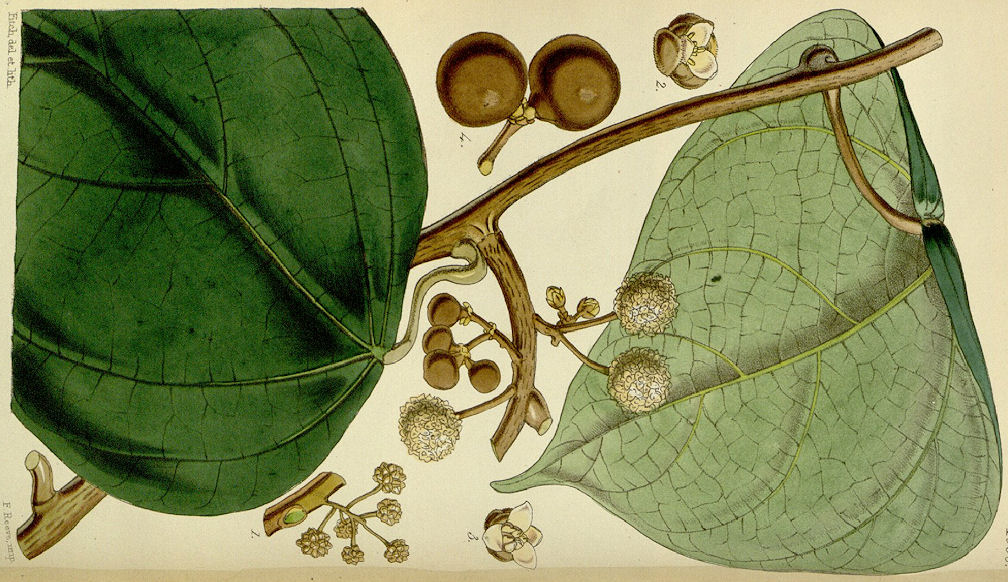
Abb.: जायकम् । Coscinium
fenestratum (Gaertn.) Colebr. - Tree Tumeric
[Bildquelle: Curtis's Botanical Magazine, v. 78 (1852), Tab. 4658]
"COSCINIUM FENESTRATUM, Colebr. Fig,—Miers, in Hook. Bot. Mag., t. 6458; Contrib. iii. 22, t. 88.
Tree Turmeric, False Calumba
Hab.—Western Peninsula, Ceylon.
[...]
History, Uses, &c.—The stem is said to have been long in use in Ceylon and Southern India as a bitter medicine, and as a yellow dye. We have not met with any account of it in native works ; but there is reason to believe that it has some times been confounded with Darhalad, the stem of the Barberry. Ainslie was probably the first European physician who noticed it. He says:—"Mera Munjil is the Tamil name of a round yellow-coloured bitterish root, common in the bazaar, about one inch in circumference, employed in preparing certain cooling liniments for the head; and is also used as a yellow dye ; it is brought from the mountains, but I have endeavoured in vain to ascertain the plant." Subsequently it attracted attention in Ceylon by being mistaken for Calumba, and some of it found its way to Europe, where it became known as False Calumba and Tree Turmeric; it is favourably noticed in the Pharmacopoeia of India, and is used at the present time in the hospitals of the Madras Presidency as a bitter tonic. (See Berberis.)"
[Quelle: Pharmacographia indica : a history of the principal drugs of vegetable origin met with in British India / by William Dymock [1834-1892], C. J. H. Warden and David Hooper [1858-1947]. -- Bd. 1. -- London, 1890. -- S. 63.]
| 27c./d. kālīyakaṃ ca kālānusāryaṃ cātha samārthakam 28a./b. vaṃśikāguru rājārhaloha-krimimija-joṅgakam
कालीयकं च कालानुसार्यं चाथ समार्थकम् ॥२७ ख॥ [Bezeichnungen für Aquilaria agallocha Roxb. - Adlerholzbaum - Agarwood:]
|
Colebrooke (1807): "Agallochum. Perhaps Amyris Agallocha, R[oxb]."
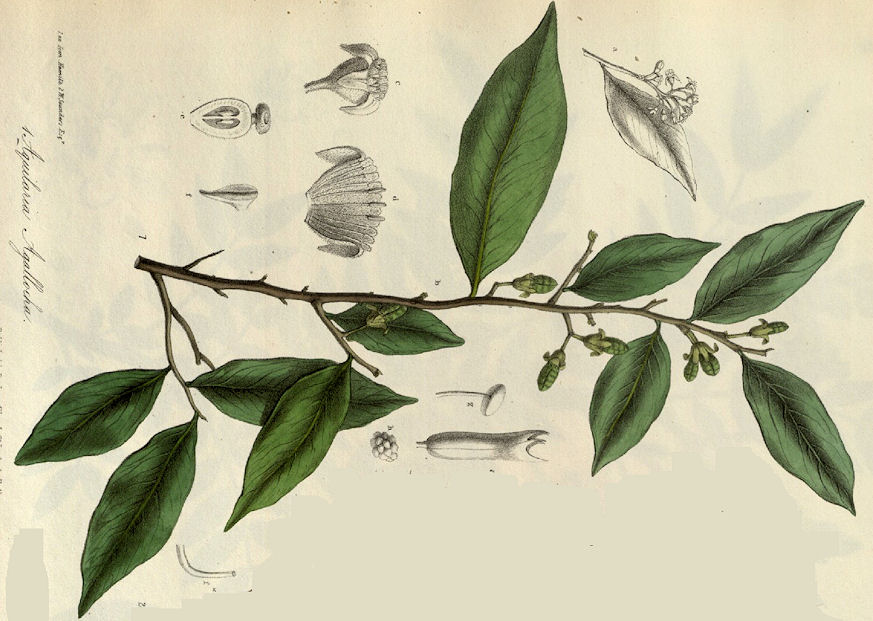
Abb.: Aquilaria
agallocha Roxb. - Adlerholzbaum - Agarwood
[Bildquelle: Royle, J. Forbes <1799-1858>: Illustrations of the botany and other branches of the natural history of the
Himalayan Mountains :and of the flora of Cashmere. -- Vol 2: Plates. -- London :
Allen, 1839. -- Pl. 36.]
"Aquilaria agallocha, Roxb. Fig.-Roxb. & Coleb. in Trans. Linn. Soc. xxi., t. 21 ; Royle Ill., t. 36, f. 1.
Hab.-Eastern Himalaya, Bhotan, Assa,, Khasia Mts., Silhet and Tippera Hills, Martaban Hills.
Aquilaria malaccensis, Lam.
Fig.-Lam. Ill., t. 356; Cav. Diss. vii., t. 224 ; Rumph. Amb. ii., t. 10.
Hab.-Malacca, Malay Islands.
Eagle or Aloe wood.
Ver. - Agar, Aguru (Indian Bazaars).
History, Uses, &c. - The use of this precious wood as a perfume and medicine is of great antiquity, together with myrrh, cassia, and other products of the East, it is mentioned in the sacred writings of the Jews (Num. 24, 6; Psalm. 45, 8; Prov. 7, 17; Cantic. 4, 14) under the name of Ahalot or Ahalim. It is the -αγαλλοχον - of the ancient Greeks, which is described by Dioscorides as a wood brought from India to Arabia. Later writers, from Aetius' time, call it -ξυλαλον - or "aloe wood", the name by which it is still known in Europe. The same substance is the Agaru of the Hindus, the Garu of the Malays, and the Chin-heang of the Chinese. In Sanskrit medical works it bears the synonym of Rājārha "worthy of prince," Visvarupa "taking all forms," Krimi-ja "produced by worms," Krimi-jagdha, Anarya-ja "produced in a non-Aryan country," Kanaka "golden," Kāliya "black," &c., and is described as hot, light and cholagogue; removing diseases of the ear, nose and eyes. In native practice Agar is used as a deobstruent, stimulant, carminative, and tonic; it is said to relieve the pain in gout, and to check vomiting. Susruta directs Aguru, Guggula (resin of Boswelia serrata), Sarjarasa (resin of Shorea robusta), Vacha (Acorus Calamus), white mustard, Nim leaves and salt to be made into a paste with ghī to form an anodyne fumigation for surgical wounds, called in Sanskrit Vedanarakshoghnairdhupaih. As aloe wood bears the Sanskrit name of Anarya-ja, it is probable that it was used by the aborigines of Eastern Asia before it became known to the Hindus, but that at a very early date it was carried overland to Central Asia and Persia, and from thence reached Arabia and Europe.
The early Arab travellers appear to have collected a good deal of information concerning the commerce and sources of supply of the wood.
Yohanna-bin-Serapion mentions four kinds, Hindi, Mandali, Sinfi and Kamāri, and Ibn Sina in the 10th century has the following account of it: -"The best is called Mandali from the more central parts of India; next is the Indian or Hill aloe wood, which has the advantage over Mandali of preserving clothes from lice. Some say that Mandali and Indian aloe wood are the same. One of the best kinds is Samandūri from Sofala in India; again there is the Kamāri and the Simfi from the same parts, and there is Kākuli, and Kismūri which is moist and sweet; and the worst kinds are Halāi, Kamtāi, Mabatāi, Lawathi, or Rabatāthi. Mandali is the best; then Samandūri, of a grey colour, fat and oily, heavy, without any white streaks, and which burns slowly. Some consider black aloe wood better than grey, and the best black is the Kamāri, without white streaks, fat and oily, which burns slowly. In short, the best aloe wood is black, hard, and heavy, sinks in water, is not fibrous when powdered; that which does not sink is bad. The tree is said to be buried to promote the formation of aloe wood." The Arabian travellers give much the same names to different kinds of the wood. Ibn Batuta speaks of Kamāri as soft, like wax. Abu Zaid calls it Kamarūni, and says it is the best kind. Abulfeda states that it comes from the Kamarūn Mountains. Kākuli is said to derive its name from Kākaleh in Java. The epithets Māwardi, Saimuri and Jāwi are also applied by some writers to aloe wood. As regards the identification of these localities, we would remark that Samfi is probably derived from Champa, a province in Cambodia; Mandali, from Mount Mandar or Mandal, south of the modern town of Bhagalpur in Bengal; Kāmari or Kamaruni, from Kamarun, the Arab name for Cape Comorin; Saimūri, from Saimūr or Samar, an island in the Eastern Archipelago; Halāi may possibly be derived from the Hala Mountains between Sind and Beluchistan, as Abu Zaid says that the best aloe wood is brought for sale by Multanis.
Haji Zein-el-Attār (1368) calls aloe wood Ood-el-jāj, and in Persian, Ood and Balanjūj. After translating Ibn Sina's article on Ood, he gives his own opinion in the following terms: "The author of this work (Ikhtiarat-i-badiaa) says the best is called Kalambak, and comes from the port of Jena, which is ten days' sail from Java; it is sold for its weight in gold; you would think it odourless, but when warmed in the hand it has a very sweet persistent odour; when burnt, the odour is uniformly sweet until the wood is consumed. Next is Mandali and Samandūri, both from Sofala in India, the best of these is of a golden colour and heavy. Kākuli is like the Indian, and is generally in large pieces, marked with black and yellow lines; then there is Kamāri, golden-brown, without white streaks, it comes from Kamarūn and Sofala; then Samfi, from Samp, it is very hard and sweet; then Sakāli and Afasi, a moist kind from China; then Mantai, Randi, Halai, and Lanfi, all of about equal value. And in Manta there is a tribe who call the wood Ashbāh, and it is of two kinds: one of these is in large pieces weighing from 5 to 50 maunds, without much odour, and used for making combs, knife handles, &c.
Mir Muhammad Husain (1770) writes: -"Ood, in Hindi Agar, is the wood of a tree which grows in the Jaintiya hills near Sylhet, a dependency of the Sūbah of Bengal, situated towards the north-east of Bengal Proper. The tree is also found in the islands to the south of Bengal, situated north of the Equator, and in the Chatian islands belonging to the town of Nawaka, near the boundaries of China. The tree is very large, the stem and branches generally crooked, the wood soft. From the wood are manufactured walking sticks, cups, and other vessels; it is liable to decay, and the diseased part then becomes infiltrated with an odoriferous secretion. In order to expedite this change it is often buried in wet ground. Parts which have undergone the change above mentioned become oily, heavy and black. They are cut out and tested by being thrown into water; those which sink are called Gharki, those which partly sink Nim Charki, or Samāleh-i-aala, and those which float Samāleh; the last kind is much the most common. Gharki is of a black colour, and the other qualities dark and light-brown."
The best kind for medicinal use is Gharki Ood from Sylhet; it should be bitter, odoriferous, oily and a little astringent; other kinds are considered inferior. In most receipts raw Ood (Ood-i-khām) is enjoined to be used to prevent the use of wood from which the oil has been abstracted by crushing and maceration in water, or by crushing and admixture with almonds, which are afterward expressed (Nicolaus Myrepsicus prescribes Agallochum crudum). This precaution is the more necessary as Ood shavings are an article of commerce in India under the name of Chūra agar; they are often adulterated with chips of Sandalwood, or Taggar, an odoriferous wood, common in India.
Rumphius describes two kinds of true, and two of false, aloe wood; the first kind of true aloe wood, he says, is called Kilam or Ho-Kilam by the Chinese, and Calambac by the Malayas, and is produced by a tree growing in the provinces of Champa and Coinam, and in Cochin-China. This tree has been described by Loureiro under the name Aleoxylon agallochum. The second kind, called Garo, is the product of Aquilaria malaccensis, Lamk. which he figures. This is the Chin-heang of the Pun-tsaou-kang-muh or great Chinese Herbal. (See Hanbury Science Papers, p.263.) His two kinds of false aloe wood he attributes to Michelia champaca and Excoecaria agallocha.
Roxburgh and other botanists have examined the Aquilaria in Sylhet, and recently an Aquilaria has been ascertained to be the tree which produces aloe wood in the islands of the Mergui Archipelago. Gamble says that "Akyu (the Burmese name for aloe wood) is the most important produce of the forests of South Tenasserim and the Mergui Archipelago. It is found in fragments of various shapes and sizes in the centre of the tree, and usually, if not always, where some former injury has been received."
Aloe wood is used throughout the East as an incense and as a perfume, and was formerly used as a medicine in Europe for the same diseases for which it is still prescribed in India.
Collection. -In Sylhet, the collection of aloe wood is a precarious and tedious business; those engaged in it proceed some days' journey into the hilly districts, where they fell any trees they may find, young or old, and then, on the spot, search them for the Agar, as the valued wood is called. This is done by chopping off the bark, and into the wood, until they observe dark coloured veins, indicating the proximity of wood of valuable quality, which generally extends but a short distance from the centre of a trunk or branch. In this manner a whole tree is searched through, the collectors carrying away only such pieces as are rich in odoriferous resinous matter. In some districts it is customary to facilitate the extraction of the resinous wood by burying portions of the tree in moist ground, or by allowing the entire tree to remain a length of time after it is cut down, the effect of which is to cause decay in the non-resinous wood, and thus render it easily removable by an iron instrument. Aloe wood is sorted by the collectors into various qualities, the finest of which, called Charki, is worth in Sylhet from 6 to 8 rupees per pound. (Hanbury Science Papers.)"
[Quelle: Pharmacographia indica : a history of the principal drugs of vegetable origin met with in British India / by William Dymock [1834-1892], C. J. H. Warden and David Hooper [1858-1947]. -- Bd. 3. -- London, 1893. -- S. 217 - 221.]
| 28c./d. kālāgurv aguruḥ syāt tan maṅgalyā malligandhi yat कालागुर्व् अगुरुः स्यात् तन् मङ्गल्या मल्लिगन्धि यत् ॥२८ ख॥ [Bezeichnungen für Aquilaria agallocha Roxb. - Adlerholzbaum - Agarwood, dunkle Varietät:]
|
Colebrooke (1807): "A black kind."
| 28c./d. kālāgurv aguruḥ syāt
tan maṅgalyā malligandhi yat कालागुर्व् अगुरुः स्यात् तन् मङ्गल्या मल्लिगन्धि यत् ॥२८ ख॥ Die Aquilaria agallocha Roxb. - Adlerholzbaum - Agarwood, die nach Jasmin riecht, heißt मङ्गल्या - maṅgalyā f.: Glückbringende |
Colebrooke (1807): "A very fragrant sort.
| 29a./b. yakṣadhūpaḥ sarjaraso rāla-sarvarasāv api 29c./d. bahurūpo 'py atha vṛkadhūpa-kṛtrimadhūpakau
यक्षधूपः सर्जरसो
राल-सर्वरसाव् अपि । [Bezeichnungen für das Harz von Shorea robusta Gaertn. - Salharzbaum - Sal Tree:]
|
Colebrooke (1807): "Resin."
Zu Räucherstoffen sehr hilfreich:
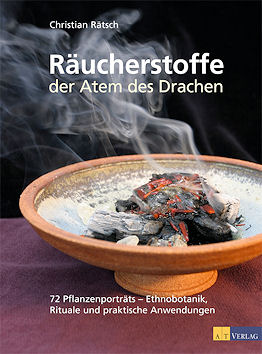
Abb.: Einbandtitel
Rätsch, Christian <1957 - >: Räucherstoffe : der Atem des Drachen. 72 Pflanzenporträts, Ethnobotanik, Rituale und praktische Anwendungen. --4., erw. Aufl. -- Aarau : AT Verlag, 2006. -- 237 S. : Ill. ; 27 cm. -- ISBN 978-3-03800-302-1
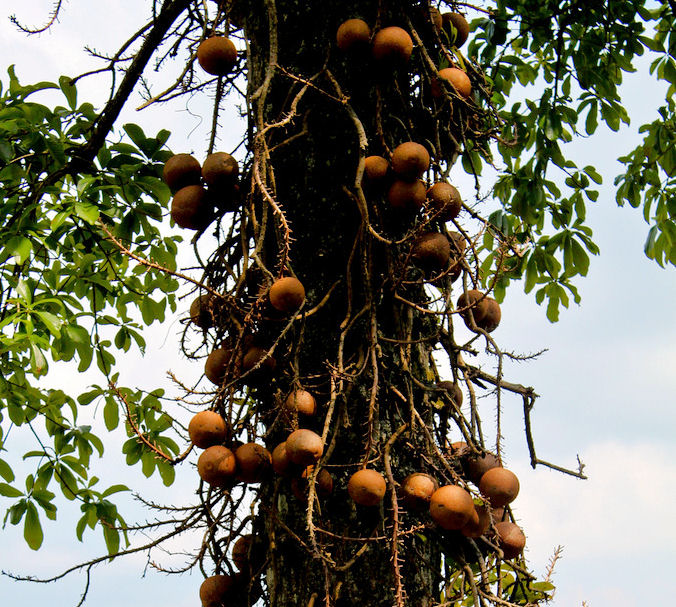
Abb.: शालः । Shorea robusta Gaertn. -
Salharzbaum - Sal Tree
[Bildquelle:
Chinthaka Palliyahguru. --
http://www.flickr.com/photos/chintho/5468310866/. -- Zugriff am
2011-03-08. --
Creative
Commons Lizenz (Namensnennung, keine kommerzielle Nutzung, share alike)]
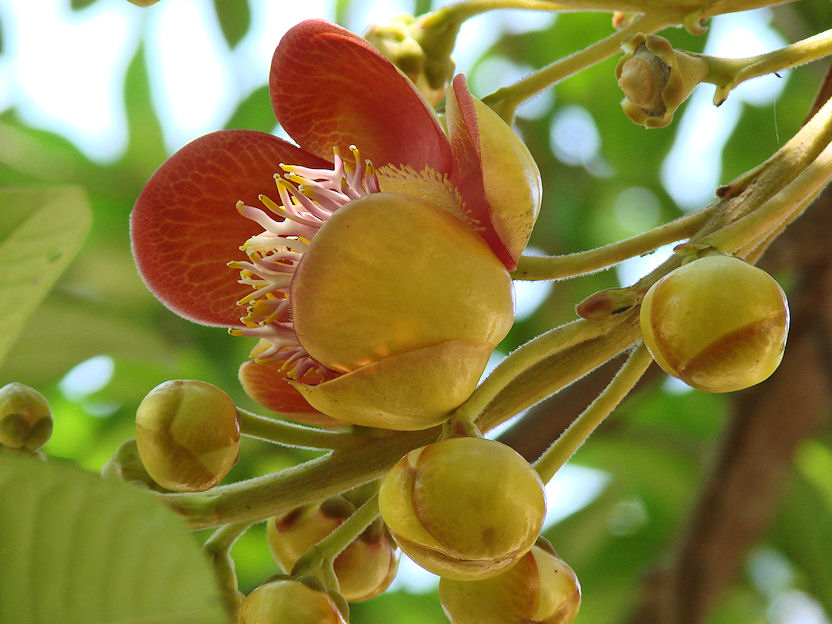
Abb.: शालः । Shorea robusta Gaertn. -
Salharzbaum - Sal Tree, Battambang -
ក្រុងបាត់ដំបង,
Kambodscha
[Bildquelle:
Jean-Pierre Dalbéra. --
http://www.flickr.com/photos/dalbera/2456731455/. -- Zugriff am
2011-03-08. --
Creative
Commons Lizenz (Namensnennung, keine kommerzielle Nutzung, share alike)]
"SHOREA ROBUSTA, Gaertn. f. Fig.—Beddome Fl. Sylv., t. 40.
The Saul tree
Hab .—Tropical Himalaya, Central India, Western Bengal.
The resin.
[...]
History, Uses, &c.—The Sāl tree, called in Sanskrit Sāla and Asvakarna, is of interest from a mythological point of view, as the mother of Buddha is represented as holding a branch of the tree in her hand when Buddha was born, and it was under the shade of a Sala tree that Buddha passed the last night of his life on earth. The small branches of the Sala are used by Indian villagers to detect witches; they write the name of every woman over 12 years of age in the village upon a branch ; the branches are then placed in water and left for 4 1/2 hours; if any woman's branch withers, she is the witch.
This tree is very widely distributed throughout India, and is undoubtedly the source of the Resin or Rāl of Hindu and Mahometan writers on Materia Medica. Rāl, in Sanskrit Rāla and Sāla-veshta, is regarded by the Hindus as attenuant, detergent, and astringent, and is sometimes prescribed internally mixed with sugar, honey or treacle; as resin does with us, it enters into the composition of stimulating plasters and ointments; it is also used for fumigating rooms occupied by the sick. The seeds of the Saul tree are eaten in times of scarcity with Mahwa flowers by the wild tribes of India. Mahometan writers give a similar account of its properties and uses. The author of the Makhzan-el-Adwiya (vide article Kaikahr) notices the fact that more than one kind of. Rāl is met with, but names the Sakoh or Sal as the source from which the genuine article is obtained. In another part of his work (vide article Sakoh) he describes the tree, and says that when old the bark becomes separated from the trunk by the deposit of Rāl beneath it. Ainslie mentions three kinds of resin or dammar as common in the bazars of Southern India, but is in doubt as to the sources from whence the different kinds are obtained. He observes that a great portion of the dammar used in India is imported from Java, Borneo, Joanna, and several of the Soloo Islands. The author of the Bengal Dispensatory, after conducting a series of experiments with genuine Sāl resin, pronounced it to be an efficient substitute for pine resin. In Bombay, at the present time, American resin is to a great extent displacing Indian Rāl. Dr. Sakharam Arjun states (Bomb. Drugs) that he has seen Shorea resin mixed with sugar, given with good effect in dysentery. The oil of the seeds is extracted in Malabar. In the Wynaad Shorea Talara, Roxb. (S. laccifera, Heyne,) yields a fragrant resin, known as Sambrani, which is burnt as an incense."
[Quelle: Pharmacographia indica : a history of the principal drugs of vegetable origin met with in British India / by William Dymock [1834-1892], C. J. H. Warden and David Hooper [1858-1947]. -- Bd. 1. -- London, 1890. -- S. 195f.]
| 29c./d. bahurūpo 'py atha vṛkadhūpa-kṛtrimadhūpakau बहुरूपो ऽप्य् अथ वृकधूप-कृत्रिमधूपकौ ॥२९ ख॥ [Bezeichnungen für (durch Zusätze) verfälschtes Räucherwerk:]
|
Colebrooke (1807): "Compunded perfume."
| 30a./b. turuṣkaḥ piṇḍakaḥ sihlo yāvano 'py atha pāyasaḥ तुरुष्कः पिण्डकः सिह्लो यावनो ऽप्य् अथ पायसः ।३० क। [Bezeichnungen für Styrax von Liquidambar orientalis Miller - Amberbaum - Sweetgum:]
|
Colebrooke (1807): "Incense."
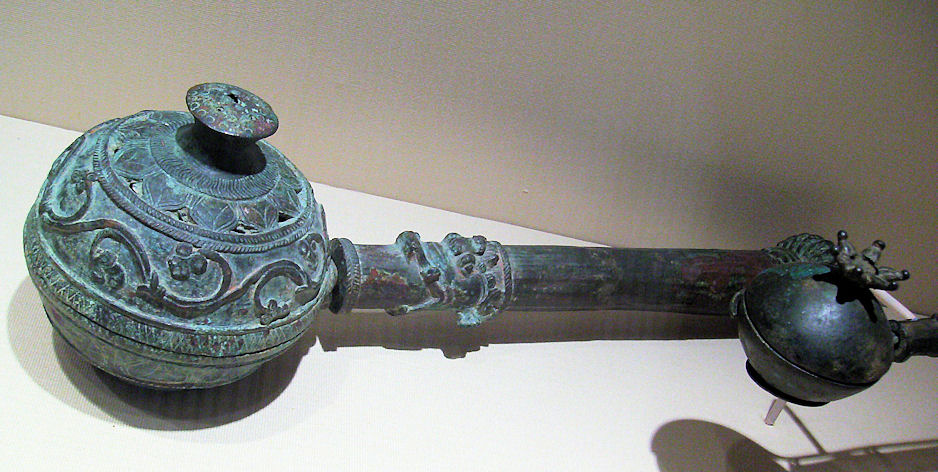
Abb.: Weihrauchgefäß, Nordwestindien, ca. 6. Jhdt. n. Chr.
[Bildquelle: Peter Roan. --
http://www.flickr.com/photos/peterjr1961/2920975176/. -- Zugriff am
2011-03-06. --
Creative Commons Lizenz (Namensnennung, keine kommerzielle Nutzung)]
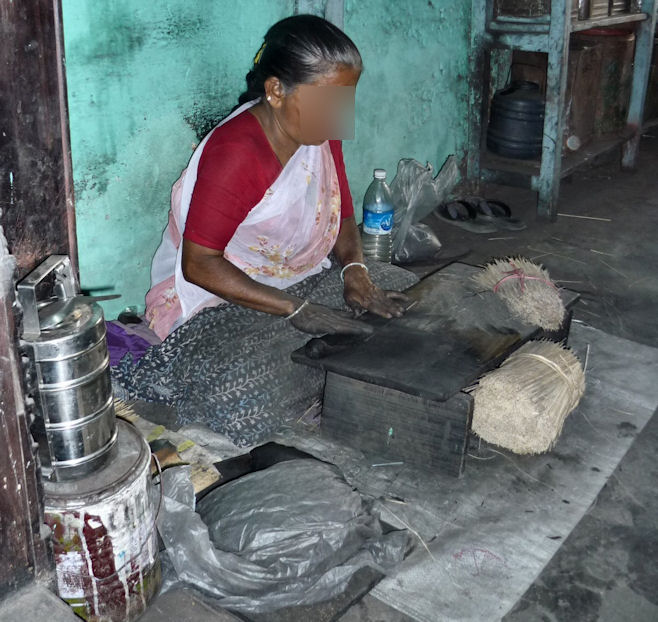
Abb.: Räucherstäbchen-Macherin, Mysore, Karnataka
[Bildquelle: runran. --
http://www.flickr.com/photos/runran/3357256915/. -- Zugriff am
2011-03-06. --
Creative
Commons Lizenz (Namensnennung, share alike)]
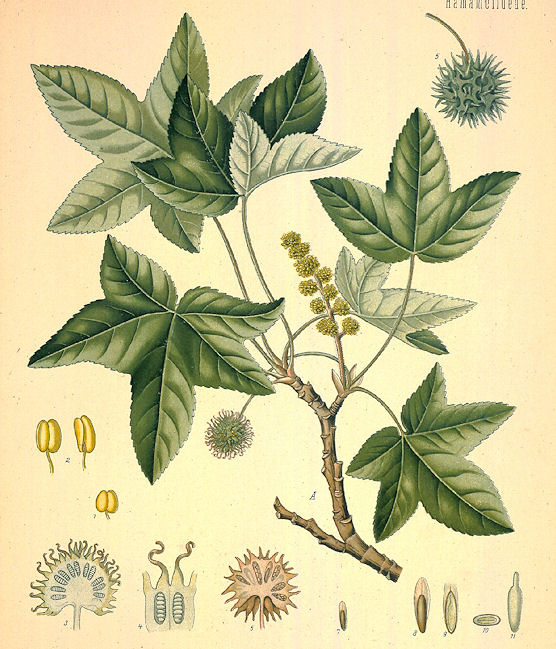
Abb.: सिह्लः ।
Liquidambar orientalis Miller - Amberbaum - Sweetgum
[Bildquelle: Köhler, 1883]
"LIQUIDAMBAR ORIENTALIS, Miller
Fig. - Bentl. and Trim., t. 107.
Liquid Storax
Hab.-Asia.
[...]
History, Uses, &C.—Liquid storax is prepared in the South Western Districts of Asia Minor by boiling the inner bark of the tree in water and pressing it; a superior kind is said to be obtained by simply pressing the bark before it is boiled. We learn from the author of the Periplus of the Erythrean Sea that as long ago as the first century storax was exported via the Red Sea to India.
About this time Silhaka ( Silaras) is mentioned as one of the imports at the port of Thana on the Western Coast. It was carried first to this country and afterwards to China by Arab traders in the same manner as myrrh, olibanum, and other odoriferous drugs. Upon the decline of the port of Thana the trade was transferred to Surat, then to Goa, and afterwards to Bombay, where it still continues, the imports averaging from 350 to 360 cwts. yearly. In the trade statistics of the early European traders it is called Rosa Mallas and Rosa Malloes, a name which it still retains, and the origin of which is doubtful, though some suppose it to be identical with Rasamāla, the Malay name for Altingia excelsa. That the latter supposition is incorrect we think there can be little doubt, as the only Rose malloes known in Bombay is that imported from Europe. The following extracts will, we think, show that the name is of European origin, and has been applied to Liquid Storax incorrectly through a confusion of that substance with the Honey dew or Manna collected from trees, the
δροσομελι of the Greeks and the Ros melleus of the the Middle Ages. Galen, speaking of δροσομελι says:—"I have sometimes known in summer a large quantity of honey to be found upon the leaves of trees, shrubs and certain herbs."lbn Baitar, on the authority of Hubaish, says:—
"Rasimilius is a substance which falls upon trees in Khorasan; it is useful in fevers, it moistens the chest, is detergent, &c." The author of the Makhzan says :—"Rasimilius is a Greek name for a kind of incense called in Arabic Dukhan-el-daru, and in Hindi बस्त लोबान् (Ast loban) or Western Frankincense." In another place, speaking of Daru, he says that the Greek name is Fazukus (ζυγος) ?.According to Aba Hanifeh "(Liquidambar orientalis) is of the trees of the mountains, and is like the great oak, having clusters (of berries) like those of the oak, but its berries are larger; its leaves are cooked, and when thoroughly cooked, are cleared away and the water thereof is returned to the fire, and coagulates, becoming like ' Kubaita' (a kind of sweetmeat), and is used medicinally as a remedy for roughness of the chest, and for pain of the fauces." The author of the Tuhfat-el-Muminm says:—"Darū or Zarū is the name of an Arabian tree like the oak ; its fruit is like that of the Butm (Pistacia Terebinthus), but its seeds are larger; the gum of this tree is storax (Hassi luban), and has already been noticed. The wood, leaves and fruit are hot and dry, and a decoction with sugar, when brought to the consistence of a syrup by boiling, is used for roughness of the throat and cough. The oil of the seeds is odoriferous and dissolves phlegmatic humours; it is useful in dyspepsia, and in the scabby eruptions of animals." In India it is always called Silāras, and is noticed in Sanskrit works as Silhaka, and described as a product of Turkey. The Hindus use it chiefly for perfuming medicinal oils, but are aware of its pectoral qualities, and occasionally prescribe it. In modern Arabic and Persian works Liquid Storax is called Meahsayelah and Lubnī, and is described as the gum or juice of a tree resembling the quince.
Three kinds are generally mentioned—viz.,
that which exudes naturally;
that which is obtained by pressing the bark, and
that which is obtained by boiling it.
These three kinds, however, are not at the present time distinguished in commerce in Bombay, though the article may vary in quality considerably. Storax is considered by the Mahometans to be tonic, resolvent, suppurative, and astringent; it is prescribed as a pectoral, and is thought to strengthen all the viscera; applied externally it is supposed to have a similar action upon the parts with which it comes in contact. It is a favourite application to swellings, and in India is much used in orchitis, the inflamed part being smeared with it and then bound up tight in tobacco leaves. The Burmese Storax noticed in the Pharmacopoeia of India is not known in India. Much interesting information regarding the history and sources of Storax may be found in the Pharmacographia."
[Quelle: Pharmacographia indica : a history of the principal drugs of vegetable origin met with in British India / by William Dymock [1834-1892], C. J. H. Warden and David Hooper [1858-1947]. -- Bd. 1. -- London, 1890. -- S. 593ff.]
| 30. turuṣkaḥ piṇḍakaḥ sihlo yāvano 'py atha pāyasaḥ śrīvāso vṛkadhūpo 'pi śrīveṣṭa-saraladravau
तुरुष्कः पिण्डकः सिह्लो यावनो
ऽप्य्
अथ पायसः । [Bezeichnungen für das Harz von Pinus roxburghii Sarg. 1897 - Chir Pine:]
|
Colebrooke (1807): "Terpentine."
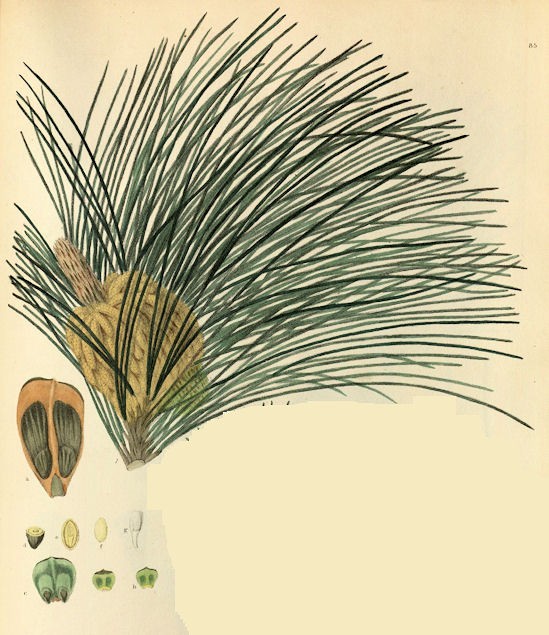
Abb.: सरलः । Pinus roxburghii
Sarg. 1897 - Chir Pine
[Bildquelle: Royle, J. Forbes <1799-1858>: Illustrations of the botany and other branches of the natural history of the
Himalayan Mountains :and of the flora of Cashmere. -- Vol 2: Plates. -- London :
Allen, 1839. -- Pl. 85.]
सरलद्रव - saraladrava m.: Sarala-Flüßigkeit (sarala m. = Pinus roxburghii Sarg. 1897), Sarala-Terpentin
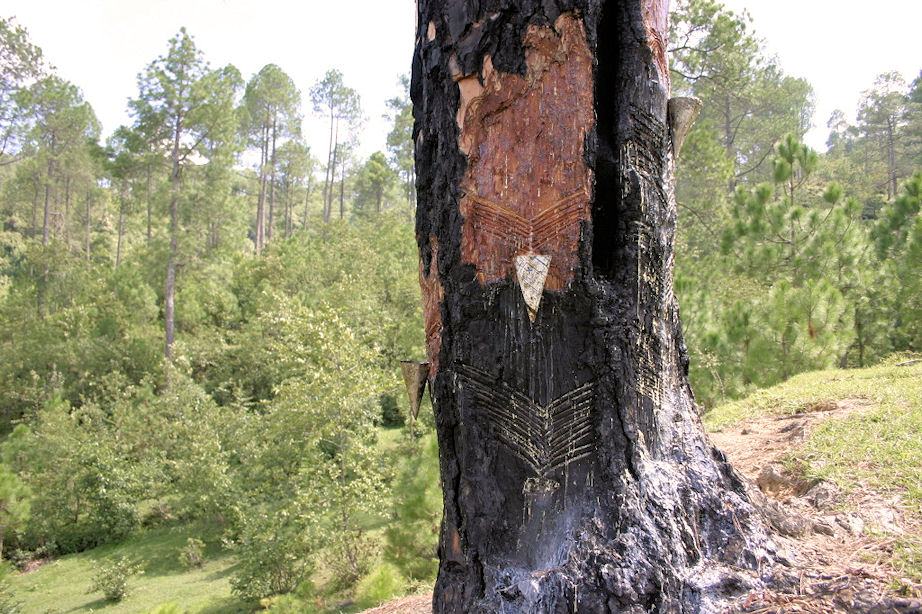
Abb.: सरलद्रवः । Harzgewinnung, Kausani -
कौसानी,
Uttarakhand
[Bildquelle: Jacob. --
http://www.flickr.com/photos/verseguru/3792161524/. -- Zugriff am
2011-03-08. --
Creative Commons Lizenz (Namensnennung, keine Bearbeitung)]
"PINUS LONGIFOLIA, Roxb. Fig.—Royle Ill., t. 85, f. 1; Griff. Ic. Pl. Asiat., tt 369, 370.
Hab.—Outer Himalayan Ranges.
The turpentine.
[...]
History, Uses, &c.—The wood, in Sanskrit Sarala, and the turpentine Sarala-drava, are mentioned as medicinal in Sanskrit works; plasters, ointments, and pastiles for fumigations are directed to be made from the turpentine. The latter, under the name of Ganda-biroja, or, more correctly, Gandah-birozah, is found in all the Indian bazars, and appears to have all the properties of ordinary turpentine, though differing from it in odour. It is chiefly used as a pectoral plaster like the pitch plaster of Europe, but it has also a reputation in veterinary practice as a remedy for mange. The Vaids obtain from it by distillation without water a limpid sherry-coloured oil having the peculiar odour of the drug, which they call Khanno oil in the Deccan; it is in much repute as a remedy for gleet or long-standing gonorrhoea.
Collection.—The Chir Pine, which is a large tree of Afghanistan and the North-West Himalayas, is the chief source of this turpentine. Atkinson, who describes its collection in Gurhwal and Kumaon, says that it is there called Birja and Lisha or Lassa (लासा) and that there are two kinds collected, viz., the natural exudation and Bakhar-birja (बाखर), which is obtained by making incisions in the sap-wood. The yield of a tree thus treated is said to be from 10 to 20 lbs. the first year, and about one-third the quantity the second year, after which the tree either dies or is blown down. (Atkinson, Brandis.)"
[Quelle: Pharmacographia indica : a history of the principal drugs of vegetable origin met with in British India / by William Dymock [1834-1892], C. J. H. Warden and David Hooper [1858-1947]. -- Bd. 3. -- London, 1893. -- S. 378.]
| 31a./b. mṛganābhir mṛgamadaḥ kastūrī cātha kolakam मृगनाभिर् मृगमदः कस्तूरी चाथ कोलकम् ।३१ क। [Bezeichnungen für Moschus:]
|
Colebrooke (1807): "Musk."
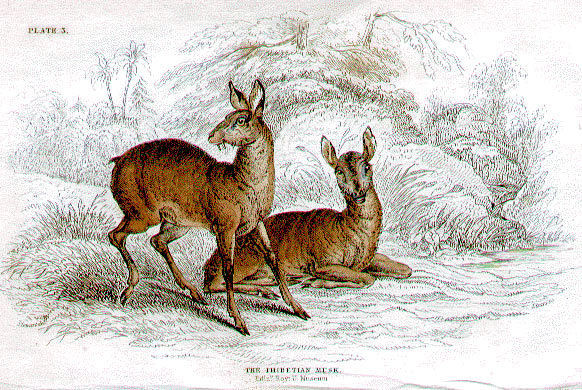
Abb.: कस्तुरीमृगौ । Himalaya-Moschushirsch (Moschus
chrysogaster)
[Bildquelle: Sir William Jardine's Naturalist's Library, Mammalia, 1835. --
Public domain]
"Musk of commerce is a secretion of the muskdeer, the Moschus moschiferus of the Himalaya, Siberia, Tonquin, and Cochin-China. In the year 1879-80, India exported 3224 ounces, value 90,039 rupees.
The musk-bag is at the end of the penis. It is globular, about 1 1/2 inches in diameter, and hairy, with a hole in the centre about the size of a lead pencil, from which the secretion can be squeezed. The orifice of the urethra lies near this, a little posteriorly. Round the margin of the opening of the gland is a circle of small glandular-looking bodies. In the living musk-deer the musk has the consistence of honey, is of a brownish-red colour, and has a strong odour. When dry, this musk is almost solid, granular, and of a dark-brown colour. It feels unctuous and fatty, has a bitter aromatic taste, and its smell is powerful. Good musk is in irregular, unctuous, light, dry, reddish-black, or dark-purple grains, concreted in a slightly oval bag, about 1 1/2 inches in diameter, hairy on one side and not on the other. They weigh from 200 to 250 grains a-piece. The small dark bags with the greyish hairs arranged evenly around the centre are the best.
The trace when rubbed on paper is a lively yellow, and no grittiness is felt or, residue left. It is sometimes adulterated with dried blood or catechu. If the former be present, agitation with distilled water will often form a solution, coagulated by heat. The latter is detected by adding a solution of muriate of iron to the water in which the musk was diffused. A deep black colour is produced if catechu be present. Globules of lead are often fraudulently introduced into the sacs ; the best test is the strength of the alcoholic solution."
[Quelle: Balfour, Edward <1813-1889>: Cyclopædia of India and of eastern and southern Asia, commercial, industrial and scientific: products of the mineral, vegetable and animal kingdoms, useful arts and manufactures / ed. by Edward Balfour. -- 3rd ed. -- London: Quaritch. -- Vol. 2. -- 1885. -- S. 1021]
"Moschus (Bisam), das Sekret, das von dem männlichen ð Moschustier (s. d.) in einem in der Nähe der Geschlechtsteile liegenden Beutel (Moschusbeutel) abgesondert wird. Man unterscheidet im Handel tongkinesischen (tibetischen, orientalischen) als besten, ferner Yünnanmoschus, Nepal-, Assammoschus und kabardinischen (russischen, sibirischen) M. Der tongkinesische kommt von Schanghai aus in den Handel. Aus den Beuteln genommene Moschussubstanz (M. ex vesicis) wird oft arg verfälscht, doch unterliegen auch die andern Handelssorten der Verfälschung. M. bildet eine anfangs salbenartige, später krümelige, körnige, braune, fettglänzende Masse von bitterlichem, widrig gewürzhaftem, schwach salzigem Geschmack und eigentümlichem, höchst durchdringendem und außerordentlich lange haftendem Geruch, der beim Trocknen der Substanz fast verschwindet, beim Befeuchten aber allmählich wieder stärker hervortritt und vielleicht auf einer eigentümlichen Selbstentmischung der Substanz beruht. Auch beim Zusammenreiben mit schwefelsauren und andern Metallsalzen, mit Sulfuraurat, Kampfer, Mutterkorn, Emulsionen etc. tritt der Geruch sehr zurück, doch nicht immer. Äußerst kleine Mengen von salzsaurem oder schwefelsaurem Chinin sollen den Geruch des M. völlig unterdrücken. An Wasser gibt M. 40–50, an Alkohol 8–10 Proz. lösliche Stoffe ab. M. wurde früher mehr als jetzt als Erregungsmittel, besonders im Todeskampf, arzneilich angewandt. Die Chinesen benutzen den M. seit alter Zeit, zu uns kam er erst durch die Araber; gegenwärtig wird er namentlich zu Parfümen verwendet, in denen er sich stets dadurch verrät, dass sein Geruch unverkennbar zurückbleibt, wenn alle ätherischen Öle verdunstet sind. Aus Schanghai wurden 1901: 1172 Catties (Kistchen mit 25–30 Moschusbeuteln) ausgeführt, davon 154 nach London, 599 nach Frankreich, 314 nach New York, 105 nach Hamburg."
[Quelle: Meyers großes Konversations-Lexikon. -- DVD-ROM-Ausg. Faksimile und Volltext der 6. Aufl. 1905-1909. -- Berlin : Directmedia Publ. --2003. -- 1 DVD-ROM. -- (Digitale Bibliothek ; 100). -- ISBN 3-89853-200-3. -- s.v.]
| 31. mṛganābhir mṛgamadaḥ kastūrī cātha kolakam kaṅkolakaṃ kośaphalam atha karpūram astriyām
मृगनाभिर् मृगमदः कस्तूरी चाथ कोलकम् । [Bezeichnungen für Piper cubeba L. f. 1782 - Kubeben-Pfeffer - Tailed Pepper:]
|
Colebrooke (1807): "Bdellium."
Vermutlich auch als Aphrodisiacum.
Zu Aphrodisiaca unentbehrlich:
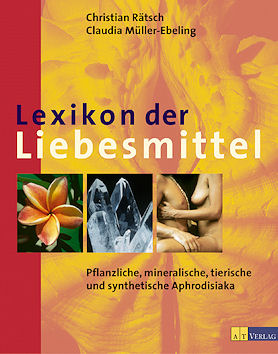
Rätsch, Christian <1957 - > ; Müller-Ebeling, Claudia <1956 - >: Lexikon der Liebesmittel : pfanzliche, mineralische, tierische und synthetische Aphrodisiaka. -- Aarau : AT Verlag, 2003. -- 784 S. : Ill. ; 28 cm. -- ISBN 3-85502-772-2
कङ्कोलक - kaṅkolaka n.: Kaṅkolaka
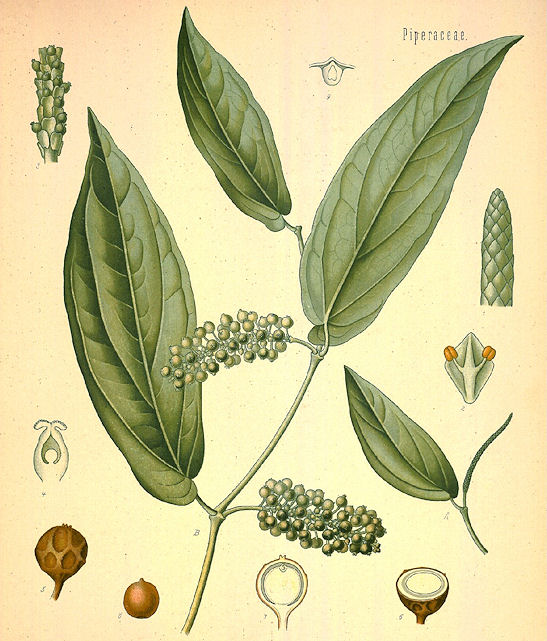
Abb.: कङ्कोलकम् । Piper cubeba
L. f. 1782 - Kubeben-Pfeffer - Tailed Pepper
[Bildquelle: Köhler, 1883]
कोशफल - kośaphala n.: Behälter-Frucht
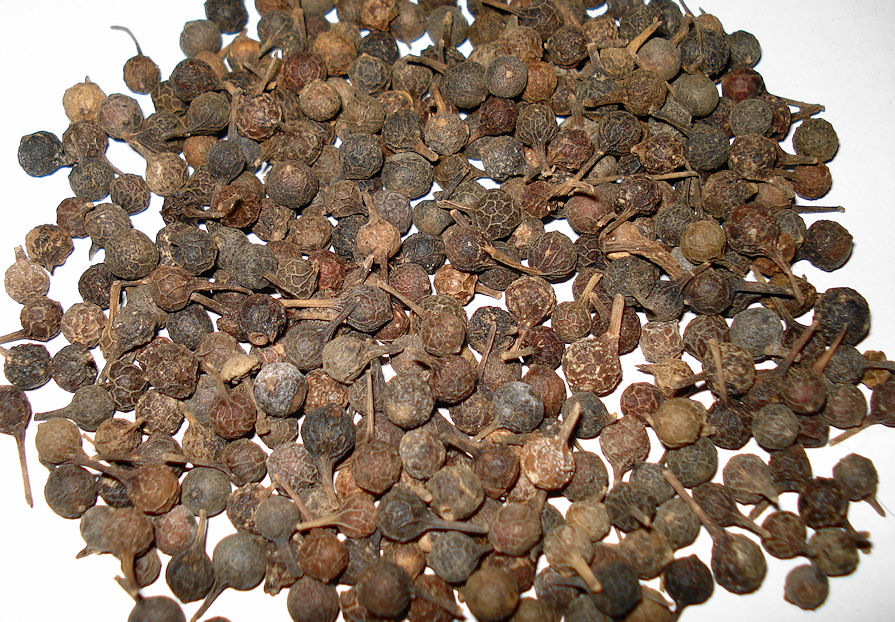
Abb.: कोशफलम् ।Piper cubeba
L. f. 1782 - Kubeben-Pfeffer - Tailed Pepper
[Bildquelle: Miansari66 / Wikimedia. -- Public domain]
"PIPER CUBEBA, Linn. f. Fig — Bentl. and Trim., t. 243.
Cubebs
Hab.—Java.
[...]
History, Uses, &C.—Cubebs were introduced into medicine by the Arabian physicians of the Middle Ages. Masudi in the 10th century stated them to be a production of Java. The author of the Sihah, who died in 1006, describes Kababeh as a certain medicine of China. Ibn Sina, about the same time, notices it as having the properties of madder, but a more agreeable taste, and states that it is said to possess hot and cold properties, but is really hot and dry in the third degree, a good deobstruent, and useful as an application to putrid sores and pustules in the mouth ; it is also good for the voice and for hepatic obstructions ; a valuable diuretic, expelling gravel and stone from the kidneys and bladder. He concludes by stating that the application of the saliva, after chewing it, increases the sexual orgasm. Later Mahometan writers have similar accounts of Kababeh, and say that it is called Hab-el-arus, "bridegroom's berry," and that Greek names for it are Mahilyun and Karfiyun, evidently a corruption of καρπεσιον, the name of an aromatic wood mentioned by Paulus Aegineta. It appears that cubebs were at one time known as Fructus carpesiorum in Europe. In the Raja Nirghanta, which was written about 600 years ago, cubebs appear under the name of Kankola, and the same name appears in the Hindi and Marathi Nighantas. Madanpal gives Katuka-kola, "pungent pepper," as a synonym for it. All the Sanskrit names appear to be of comparatively recent origin. The authors of the Pharmacographia draw attention to the fact that the action of cubebs upon the urino-genital organs, though known to the old Arabian physicians, was unknown to modern European writers on Materia Medica at the commencement of the present century. According to Crawfurd, its importation into Europe, which had long been discontinued, recommenced in 1815, in consequence of its medicinal virtues having been brought to the knowledge of the English medical officers serving in Java, by their Hindu servants. (Op. cit., 2nd Ed., p. 585.) In earlier times cubeb pepper was used in Europe as a spice, as it still is, to some extent, in the East."
[Quelle: Pharmacographia indica : a history of the principal drugs of vegetable origin met with in British India / by William Dymock [1834-1892], C. J. H. Warden and David Hooper [1858-1947]. -- Bd. 3. -- London, 1893. -- S. 180f.]
| 31c./d. kaṅkolakaṃ kośaphalam atha karpūram astriyām 32a./b. dhanasāraś candrasaṃjñaḥ sitābhro himavālukā
कङ्कोलकं कोशफलम् अथ कर्पूरम् अस्त्रियाम् ॥३१ ख॥ [Bezeichnungen für Kampfer von Cinnamomum camphora (L.) J. Presl 1825 - Kampferbaum - Camphor Tree bzw. Dryobalanops aromatica Gaertn. 1805 - Borneokampfer - Baru Camphor:]
|
Colebrooke (1807): "Camphor. Or any name of the moon."
कर्पूर - karpūra n., m.: Kampfer
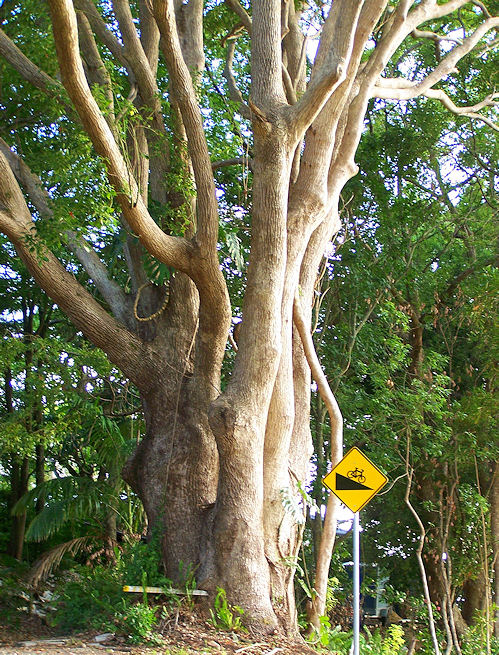
Abb.: कर्पूरः । Cinnamomum
camphora (L.) J. Presl 1825 - Kampferbaum - Camphor Tree, Australien
[Bildquelle: YAZMDG. --
http://www.flickr.com/photos/yazmdg/4213669455/. -- Zugriff am
2011-03-03. --
Creative Commons Lizenz (Namensnennung, keine kommerzielle Nutzung,
keine Bearbeitung)]
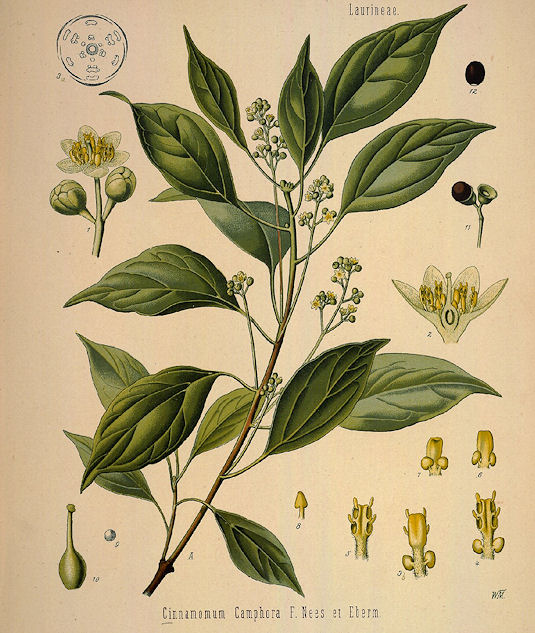
Abb.: कर्पुरः । Cinnamomum
camphora (L.) J. Presl 1825 - Kampferbaum - Camphor Tree
[Bildquelle: Köhler, 1883]
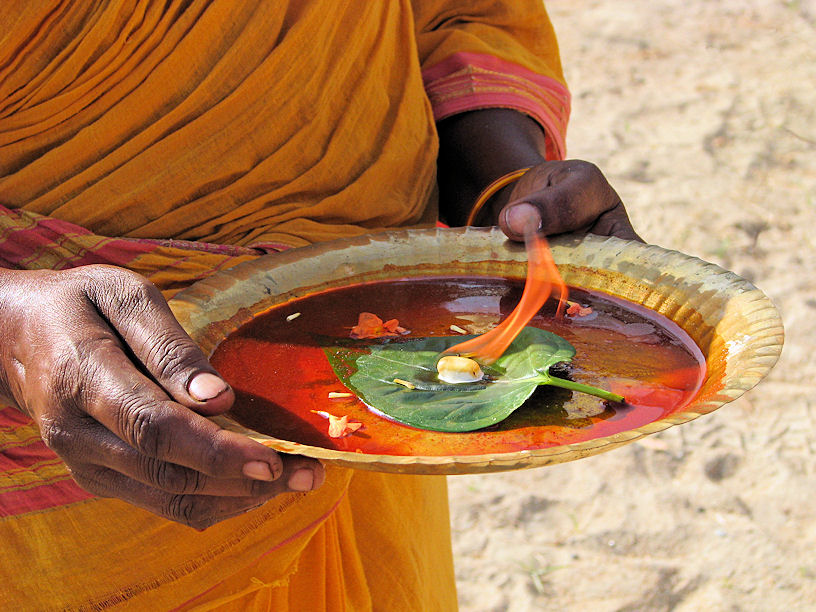
Abb.: कर्पूरम् । Brennender Kampfer bei Willkommens-Zeremonie, Tamil Nadu
[Bildquelle:
McKay Savage. --
http://www.flickr.com/photos/mckaysavage/2458852328/. -- Zugriff am
2011-03-07. --
Creative
Commons Lizenz (Namensnennung)]
सिताभ्र - sitābhra m.: weiße Wolke, Kampfer
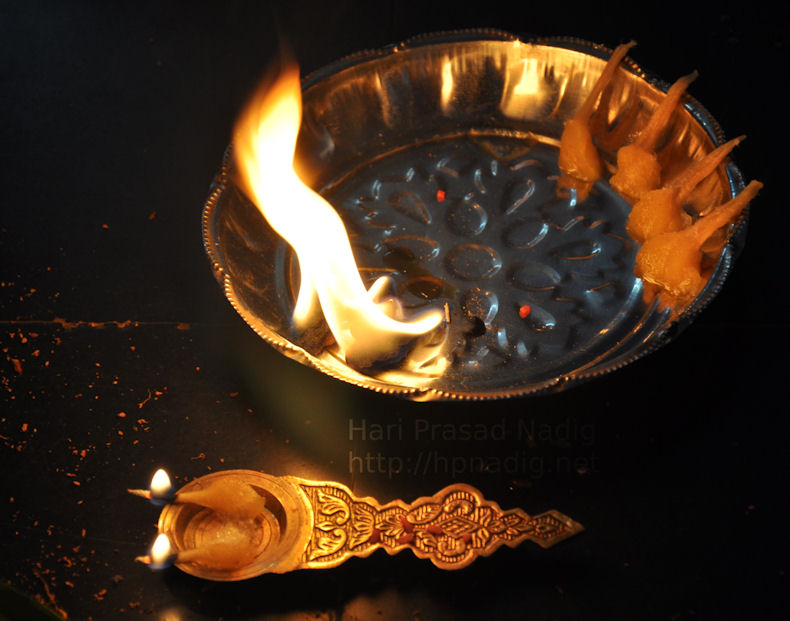
Abb.: सिताभ्रः । आरती - Aarti (in der Schüssel brennt Kampfer),
Karnataka
[Bildquelle:
Hari Prasad Nadig. --
http://www.flickr.com/photos/hpnadig/4933947270/. -- Zugriff am
2011-03-03. --
Creative
Commons Lizenz (Namensnennung, share alike)]
धनसार - dhanasāra m.: Reichtums-Essenz

Abb.: धनसारः । आरती - Aarti mit brennendem Kampfer für den Ganges,
Haridwar - हरिद्वार, Uttarakhand
[Bildquelle: NID chick. --
http://www.flickr.com/photos/38997886@N00/1441745678/. -- Zugriff am
2011-03-03. --
Creative
Commons Lizenz (Namensnennung)]
"CINNAMOMUM CAMPHORA; Nees
[...]
Hab.—China, Japan.
Camphor and Oil of Camphor.
[...]
History, Uses, &c.—As has been already mentioned (see article "Dryobalanops"), Sanskrit writers, under the name of Karpura, speak of two kinds of camphor, Pakva and Apakva. It is generally supposed that the former term, which means prepared by the aid of heat, refers to ordinary commercial camphor obtained from the wood of C. Camphora. The researches of Flückiger and Hanbury show that the only camphor known in early times was that found in the trunk of Dryobalanops aromatica. Early Chinese writers only speak of C. Camphora as producing a valuable wood, and we have no information as to the date of the first extraction of camphor from it. Garcia d'Orta, who wrote at Goa about the middle of the sixteen century, was well acquainted with both kinds of camphor, and mentions that the China camphor is the only kind exported to Europe. The medicinal uses to which camphor is put in the East have been already noticed under "Dryobalanops." With the exception of a small quantity of refined camphor imported from Japan, the bulk of the drug used in India is imported in the raw state and resublimed in the country. The process of resublimation is a peculiar one, the object being to get as much interstitial water as possible into the camphor cake. The vessel used is a tinned cylindrical copper drum, one end of which is removable; into this is put 14 parts of crude camphor and 2 1/2 parts of water; the cover is then luted with clay, and the drum being placed upon a small furnace made of clay, is also luted to the top of the furnace. In Bombay four of these furnaces are built together, so that the tops form a square platform. The sublimation is completed in about three hours ; during the process the drums are constantly irrigated with cold water. Upon opening them a thin cake of camphor is found lining the sides and top; it is at once removed and thrown into cold water. Camphor sublimed in this way is not stored, but distributed at once to the shopkeepers before it has time to lose weight by drying. It is sold at the same price as the cfude article, the refiner's profit being derived from the introduction of water. Experiments by Clautrian (Berichte, xxiv., 2612) have proved that camphor possesses considerable hygroscopic properties which are not shared by thymol. 40 grains of camphor will absorb .054 gram of water from air saturated with aqueous vapour at 16°C. The absorption of moisture by camphor would appear to be a purely physical phenomenon. Both China and Japan crude camphor is imported into Bombay, but the latter is preferred, as it is cleaner. From Japan is also imported refined camphor in large square cakes an inch and a half thick, with a hole in the centre; it is nearly equal in quality to that refined in Europe. The method of obtaining crude camphor in Japan will be found fully described by H. Oishi in the Journ. Soc. Chem Ind., 1884, p. 353. Camphor is largely used in India in performing the arti (आरती), a ceremony performed in adoration of some god by waving, in a circle before the image, a platter containing a five-wicked burning lamp, flour, and incense; the lamp being fed with camphor. The same rite, only substituting a bridegroom for the idol, is called
ārta, and is performed on the arrival of the bridegroom at the house of the bride. In Sanskrit this light is called आरात्रिक (ārātrika)."[Quelle: Pharmacographia indica : a history of the principal drugs of vegetable origin met with in British India / by William Dymock [1834-1892], C. J. H. Warden and David Hooper [1858-1947]. -- Bd. 3. -- London, 1893. -- S. 199ff.]
कर्पूर - karpūra n., m.: Kampfer
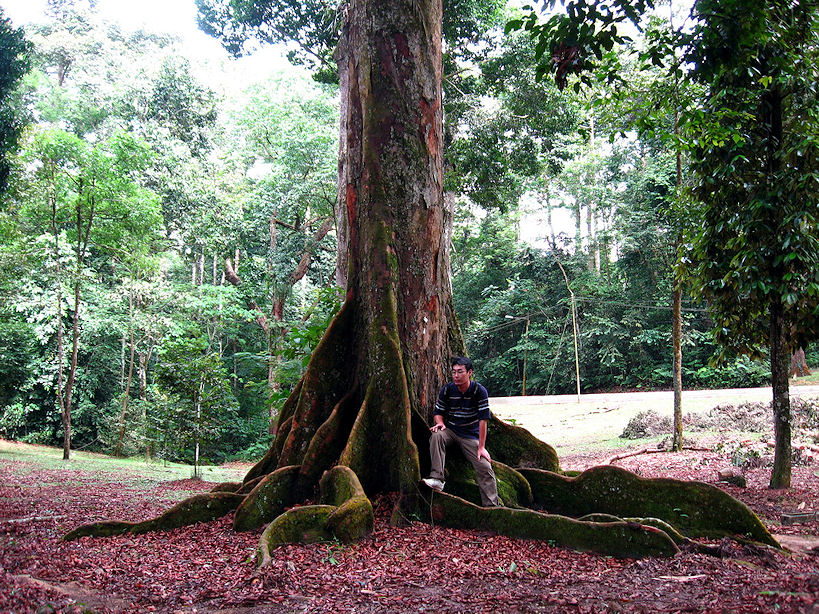
Abb.: कर्पूरः ।
Dryobalanops aromatica Gaertn. 1805 - Borneokampfer - Baru Camphor,
Selangor, Malaysia
[Bildquelle:
Min Sheng Khoo. --
http://www.flickr.com/photos/khooms/3130119859/. -- Zugriff am
2011-03-03. --
Creative
Commons Lizenz (Namensnennung, keine kommerzielle Nutzung, share alike)]
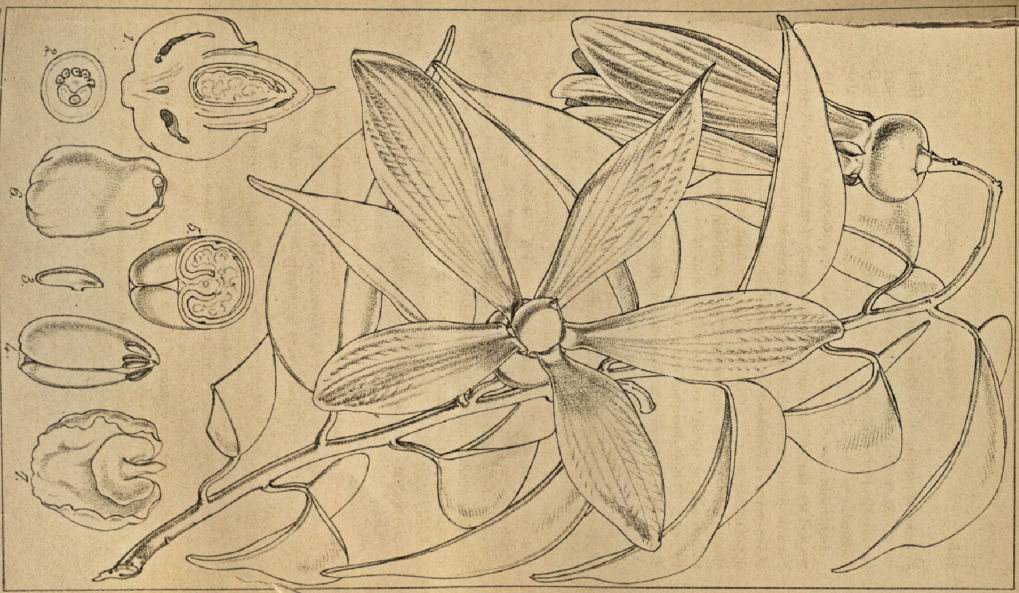
Abb.: कर्पूरः ।
Dryobalanops aromatica Gaertn. 1805 - Borneokampfer - Baru Camphor
[Bildquelle: Hooker's Journal. -- Vol. 4 (1852). -- Pl. VII.]
हिमवालुका - himavālukā f.: Schnee-Sand
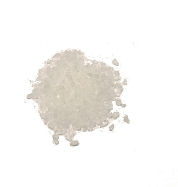
Abb.: हिमवालुका
। Kampfer von
Dryobalanops aromatica Gaertn. 1805 - Borneokampfer - Baru Camphor
[Bildquelle: Sjschen / Wikimedia. -- GNU FDLicense]
"DRYOBALANOPS AROMATICA, Gaertn.
Fig. -Hook. Journ. Bot., 1852, t. 7; Hayne xiii., t. 17
Borneo Camphor.
Hab.-Sumatra, Borneo.
[...]
History, Uses, &c.—Sanskrit writers mention two kinds of camphor, Pakva und Apakva (cooked and uncooked); it is generally considered that Borneo camphor is meant by the latter term. In the Rajanirghantu oil of camphor is mentioned ; this may refer to the Borneo camphor oil, or to some preparation made by dissolving camphor in oil. Mahometan writers describe the Borneo camphor as the best kind, and notice the way in which it is obtained by splitting the trunk of the tree, The author of the Makhzan-el-Adwiya gives a full account of it, and mentions the fact of several pieces of the timber having been brought to the Hughli, which when cut up into planks yielded a quantity of camphor. He also describes the way in which the oil is obtained by incising the tree. Borneo camphor is supposed by native .physicians to have the- properties of camphor in a much higher degree than ordinary camphor; on this account it fetches an extraordinarily high price. From the researches of Flückiger and Hanbury it appears that this camphor was the only kind known in Europe in the Middle Ages and was the
καφουρα of the later Greek writers, who obtained their knowledge of it from the Arabians. Camphor is considered by the Hindus to be hot and dry, and by the Mahometans to be cold and dry, and to stimulate the brain and heart; it is prescribed in a great variety of disorders. The Hindus consider Borneo camphor to be aphrodisiacal, but the Mahometans hold a contrary opinion; both regard it as a valuable cooling application to the eyelids in inflammatory conditions of the eye. Ainslie mentions the Dryobalanops camphor as having been recently described by Mr. H. T. Colebroke, who was the first to determine its Botanical source, but wrongly supposes it to be the chief source of the camphor used in India. Mr. John Macdonald (1793) described the collection of the camphor in Sumatra in the following terms:—"The Sumatrians previous to their setting out in search of camphor discharge a variety of religious duties and ceremonies. They select old trees and pierce them, if they yield oil plentifully it is presumed they contain concreted camphor, which is found in small whitish flakes, situated perpendicularly in irregular veins, in and near the centres of the trees. The tree is cut down, divided into junks and carefully divested of its camphor. The camphor is repeatedly washed and soaked in soapy water to clean it. When clean it will sink in water, and have a white glossy smooth appearance, tending to transparency. After washing it is passed through three sieves of different mesh, so as to be divided into head, belly, and foot camphor : certain proportions of each compose the chests made up for the China market, where they are sold for £350 sterling nearly. An inferior kind is made by boiling down the liquid oil. Sumatra affords annually from 15 to 20 picu!s of 133 1/3 lbs. each, and more oil than there is at present a demand for." (As. Researches, vi., 19.) Flückiger and Hanbury in the Pharmacographia say:—"The produce of a single tree does not, it is supposed, often exceed 11 lbs. A good proportion of the small quantity produced is consumed in the funeral rites of the Batta princes. The camphor which is exported is eagerly bought for the China market, but some is also sent to Japan, Laos, Cochin China, Cambodia and Siam." In India it is chiefly used by the Jains to prepare an Abir or sacrificial powder called Vasakshepa ; this powder consists of sandalwood, saffron, Borneo camphor and musk."[Quelle: Pharmacographia indica : a history of the principal drugs of vegetable origin met with in British India / by William Dymock [1834-1892], C. J. H. Warden and David Hooper [1858-1947]. -- Bd. 1. -- London, 1890. -- S. 197ff.]
| 32c./d. gandhasāro malayaṃjo
bhadraśrīś candanam astriyām गन्धसारो मलयंजो भद्रश्रीश् चन्दनम् अस्त्रियाम् ॥३२ ख॥ [Bezeichnungen für Santalum album L. 1753 - Weißes Sandelholz - Sandalwood:]
|
Colebrooke (1807): "Sandal-wood."
मलयंज - malayaṃja m.: im Malbargebirge (malaya) Wachsender
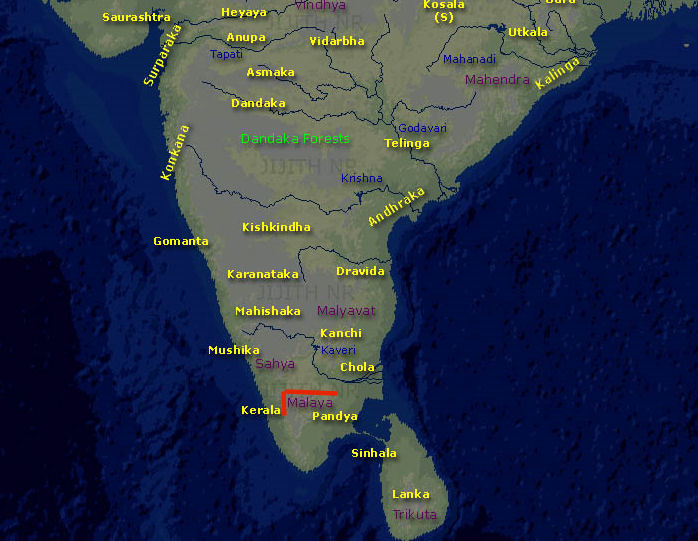
Abb.: Lage des Malaya-Gebirges
[Bildquelle: JIJITH NR / Wikimedia. -- GNU FDLicense]
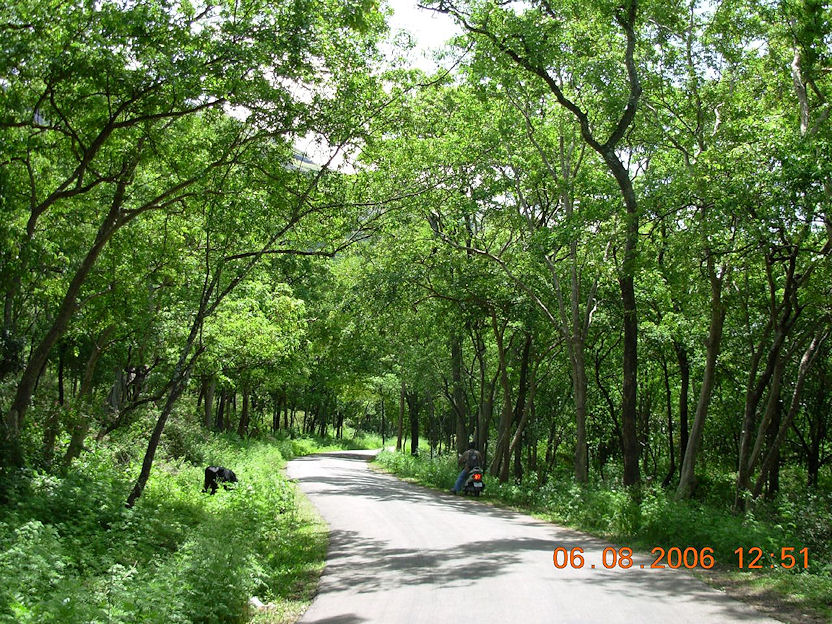
Abb.: मलयंजाः । Santalum album
L. 1753 - Weißes Sandelholz - Sandalwood, Marayoor - മറയൂർ, Kerala
[Bildquelle: Madhav Pai. --
http://www.flickr.com/photos/madpai/249398183/. -- Zugriff am
2011-03-04. --
Creative
Commons Lizenz (Namensnennung)]
चन्दन - candana n.: Sandel
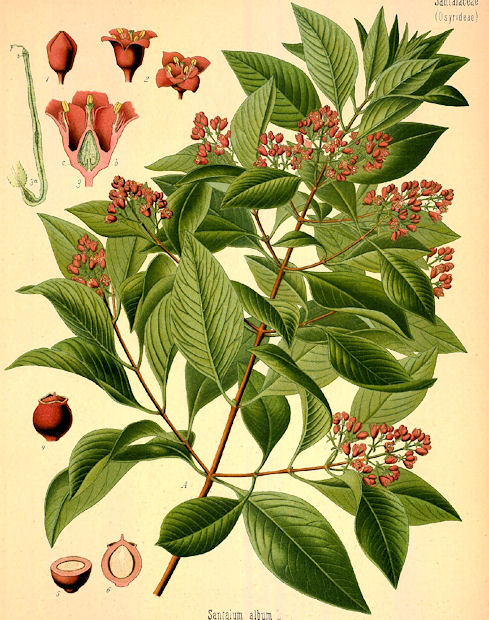
Abb.: चन्दनम् । Santalum
album L. 1753 - Weißes Sandelholz - Sandalwood
[Abb.: Köhler, 1883]
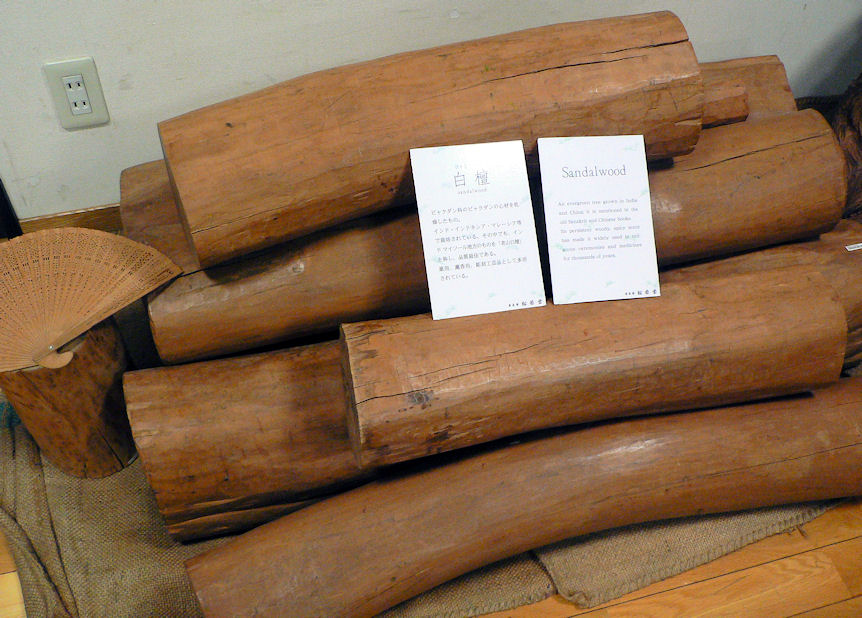
Abb.: चन्दनम् Sandelholz, Japan
[Bildquelle: Katie. --
http://www.flickr.com/photos/missioncontrol/4090631763/. -- Zugriff am
2011-03-02. --
Creative
Commons Lizenz (Namensnennung, keine kommerzielle Nutzung, share alike)]
गन्धसार - gandhasāra m.: Geruchs-Essenz
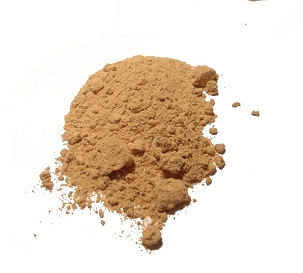
Abb.: गन्धसारः । Sandelholzpulver
[Bildquelle: Sjschen / Wikimedia. -- GNU FDLicense]
भद्रश्री - bhadraśrī f.: glückliche Pracht, großes Glück
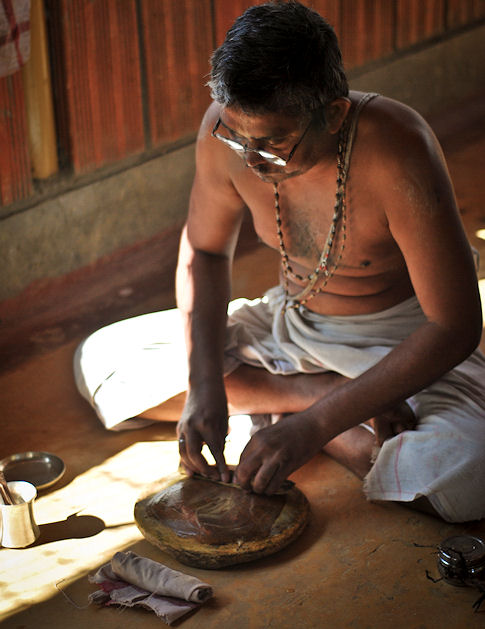
Abb.:
भद्रश्री । Zubereitung von Sandelholz-Paste, Agara, Karnataka
[Bildquelle:
Harsha K R. --
http://www.flickr.com/photos/mynameisharsha/5363140095/. -- Zugriff am
2011-03-02. --
Creative
Commons Lizenz (Namensnennung, share alike)]
"SANTALUM ALBUM, Linn. Fig.—Bedd. Fl. Sylv., t. 256; Hayne, Arnz. Gewachs. x., t. 1; Bentl. and Trim., t. 292; Rumph, Amb, ii., t. 11.
Sandalwood
Hab.—Deccan Peninsula.
The wood and essential oil.
[...]
History, Uses, &c.—Sanskrit writers make two kinds of Chandana: the darker, heartwood, they call Pitachandana, or yellow Sandal; and the lighter wood, Srikhanda, or white Sandal. Chandana is mentioned in the Nirukta, or writings of Yaska, the oldest Yedic commentary extant, said to be written not later than the 5th century B. C. It is also referred to in the ancient epic poems of the Hindus, the Ramayana and Mahabharata.
According to the Kathasaritsagara, it is one of the trees of the Buddhic paradise, and the chariot of the sun is made of its wood bound with gold.
Sanskrit medical writers describe sandalwood as bitter, cooling, astringent, and useful in bilious fever and heat of body ; a paste of the wood is directed to be applied externally to inflammatory affections of the skin, and is a domestic remedy for all kinds of pains and aches. Under the name of gandh (perfume), it is largely used in Hindu ceremonial, being smeared upon idols and upon the foreheads of their worshippers. The wood is chiefly consumed at the chita or funeral pile, even comparatively poor people spending as much as fifty rupees upon it. The Parsees also use it at their funeral ceremonies. Mahometan medical writers, commencing with Masih and Ibn Sina, call the wood Sandal, and follow the Hindus in distinguishing the dark-coloured portion from the light. The author of the Makhzan describes it as cold and dry, cardiacal, tonic, astringent, alexipharmic, antaphrodisiac, a resolvent of inflammatory swellings, &c. He recommends an emulsion in bilious fever, on account of its cooling and protective influence over the heart, brain, stomach, &c. As an external application a paste made with rose water and camphor, or with sarcocolla and white of egg, may be applied to relieve headache, or to any kind of inflammatory swelling or skin affection. Sometimes the paste is made with the juices of herbs, such as purslane, nightshade, &c. Ainslie states that in Southern India sandalwood given with milk is regarded as a valuable remedy in gonorrhoea. Rumphius (ii., p. 42) mentions a similar use of it at Amboyna. In the Concan sandalwood oil with cardamoms and bamboo manna is given in gonorrhoea, and mixed with lime juice and camphor it is used as a cooling application to eruptions, &c. A conserve of sandalwood is also made by boiling the wood cut in small pieces in bangar-khār (impure carbonate of potash) and water (4 seers sandal, half a seer bangar-khār, and 32 seers water), until it is quite soft. It is then preserved in a thick syrup. Sandalwood was known to the Greeks from the time of Alexander. Arrian mentions
ξυλα σαγαλινα among the Indian imports into Oman in the Persian Gulf. Constantinus Africanus, a physician of the School of Salerno, appears to have been the first to use it medicinally in Europe. In the Pharmacopoeia of India, Dr. M. Ross is stated to have subjected the wood to trial, and found that whilst its effects as a stimulant were very slight, its secondary effect was that of a sedative on the circulation. Tn remittent fevers in which it was administered, it acted as a diaphoretic, diminishing at the same time the rapidity rather than the violence of the heart's action. Dr. Henderson, of Glasgow, and, in France, Drs. Panas, Gubler and Simmonet, have directed the attention of European physicians to the valuable properties of the oil as remedy for gonorrhoea, in doses of from 30 to 40 minims three times a day, and there is now some demand for it in India for this purpose.[...]
Description. - Sandalwood logs are about a yard in length and 5 to 6 inches in diameter; they are stripped of the bark and a portion of the sapwood.
Andreas Petersen of Copenhagen, who made in 1886 a very careful investigation of the wood, says :—
"It is very homogeneous, rather hard and ponderous, although it does not sink in water. The heartwood is pale reddish, with darker reddish-brown and brighter yellowish concentric zones, which, when examined under the microscope, prove to be annual rings. In the inner part of the wood they are sometimes very wide, measuring, for instance, as much as seven millimetres. Possibly, therefore, they do not correspond to one year's growth, but to that of a longer period.
"The transverse section, examined by means of a lens, displays the numerous narrow medullary rays; the vessels are partly empty, partly loaded with yellow resin. In the bright yellowish sapwood both vessels and medullary rays are less distinct. The sapwood is scentless, whereas the heartwood, especially when freshly cut, is in a high degree possessed of the very agreeable and remarkably persistent odour of sandal oil.""
[Quelle: Pharmacographia indica : a history of the principal drugs of vegetable origin met with in British India / by William Dymock [1834-1892], C. J. H. Warden and David Hooper [1858-1947]. -- Bd. 3. -- London, 1893. -- S. 232ff.]
"Santalum album. (Linn.) N. O. Santalaceae. Sandal-wood
[...]
Description.—Tree, 20-25 feet; [...]
Fl. Nearly all the year.
Roxb. Fl. Ind. i. 442.
Border of Wynaad. Peninsula. Mysore.
Medical Uses.—The wood ground up with water to the consistence of paste is a common application among the natives to erysipelatous and local inflammations, to the temples in fevers, and to allay heat in cutaneous diseases. In remittent fevers it acts as a diaphoretic. It yields by distillation a pale-yellow volatile oil, which is stated to be a remedy in gonorrhoea, and from the use of which the most satisfactory results have arisen. It has been reckoned superior to Copaiba and Cubebs, and has succeeded where these latter have failed.—Pharm. of India.
Economic Uses.—This tree yields the Sandal-wood of commerce, which is usually cut into billets and disposed of in that state. It is burnt to perfume temples and dwelling-houses. Reduced to powder, it is taken in cocoa-nut water, and the natives us6 it in bathing to cool the body. The Mohammedans express a precious oil from the moist yellow part of the wood, which they value as a perfume. The same tree yields both the white and yellow Sandal-wood, the last being the inner part of the tree, and is very hard and fragrant, especially near the root. Large quantities of Sandal-wood oil are annually exported from Madras.—J. Graham, Comm. Prod. Mad. Pres.
In Mysore an experimental attempt has been made to cultivate the Sandal-wood tree. The revenue derived from its sale forms the principal item of forest revenue in Mysore. In 1866-67, 74,598 rupees were realised, the value of stock being 156,321 rupees. The natural habitats of the tree, it is said, have been reduced with the spread of cultivation. An increased production of the tree, either by cultivation or by aiding its natural growth and regeneration, would therefore be most useful, and would produce a largely-expanding revenue. The tree i9 said to attain the age of maturity in about twenty-five years.—(Govt Letter to Comm. of Mysore, Sept. 1867.) Though found all over Mysore, it grows very unequally in different parts of the country. The tree attains its greatest bulk and height in talooks with a moderately heavy rainfall, but the perfume of the wood grown in such localities is not so strong as of that grown in more arid spots, especially where the soil is red and stony. It will thrive among rocks where the soil is good; and trees in such places, though small, are generally fuller of oil. The bark and sap-wood have no smell, but the heartwood and roots are highly scented, and rich in oil. The heartwood is hard and heavy. The best parts are used for carving boxes, album-covers, desks, and other useful and ornamental articles. The roots (which are richest in oil) and chips go to the still; while Hindoos who can afford it, show their wealth and respect for their departed relatives by adding sticks of Sandal-wood to the funeral pyre. The wood, either in powder or rubbed up into a paste, is used by all Brahmins in the pigments used in their distinguishing caste-marks. The oil forms the basis of many scents, and is sometimes used for disguising with its scent articles which, being really carved from common wood, are passed off as if made from the true Sandal-wood. The greatest portion of the wood sold yearly in Mysore goes to Bombay.—(Van Someren's Report on Mysore Forests, 1869-70.) A fine quality is said to grow at the foot of the Annamullays. A large revenue from the sale of the wood from the forests of South Canara and others on the western coast is realised; this amounted to 3 1/2 lakhs in eight years. Great attention is here paid to the preparation and classification of the billets and roots, and also the distillation of the oil from the chips, which operation is carried on in South Canara by Mr Cadell. Reproduction of the tree by planting is attended with great difficulty. —Conservator's Report to Mad. Govt. 1867."
[Quelle: Drury, Heber <1819 - 1872>: The useful plants of India : with notices of their chief value in commerce, medicine, and the arts. -- 2d ed. with additions and corrections. London : Allen, 1873. -- xvi, 512 p. ; 22 cm. -- s.v.]
| 33a./b. tailaparṇika-gośīrṣe haricandanam astriyām तैलपर्णिक-गोशीर्षे हरिचन्दनम् अस्त्रियाम् । [Sorten von Sandelholz:]
|
Colebrooke (1807): "Varieties of sandal-wood. Denominated from the countries in which they are produced : or, as some derive these terms, from other circumstances. The first sort is white ; the second, the colour of brass and very fragrant. The third is yellow and said to smell like a ripe mango."
tailaparnika n.: Santalum album L. 1753 - Weißes Sandelholz - Sandalwood: siehe zum Vorigen
gośīrṣa n.: ?
haricandana n.: Coscinium fenestratum (Gaertn.) Colebr. -- Tree Tumeric: siehe oben!
तैलपर्णिक - tailaparnika n.: "Öl-Blättriges" = Santalum album L. 1753 - Weißes Sandelholz - Sandalwood
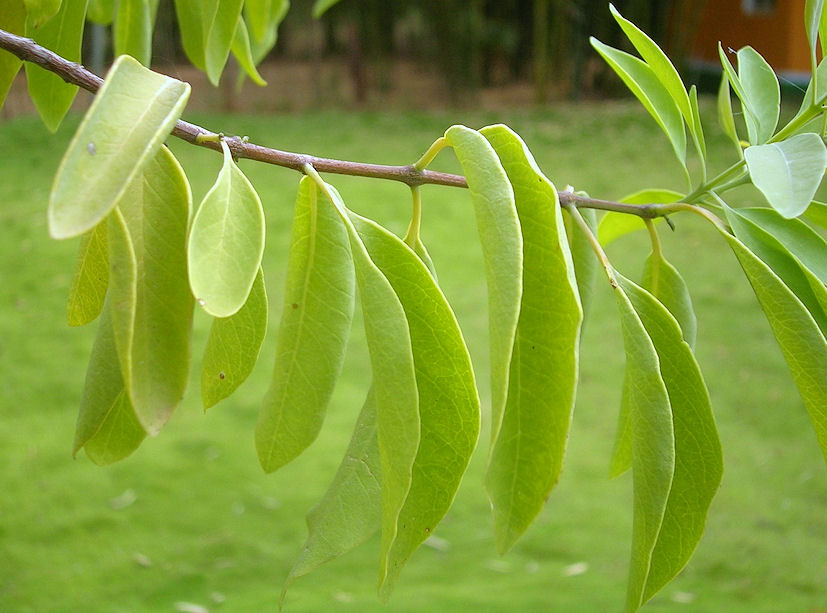
Abb.: तैलपर्णिकम् ।
Santalum album L. 1753 - Weißes Sandelholz - Sandalwood,
Karnataka
[Bildquelle: L. Shyamal / Wikipedia. -- GNU FDLicense]
| 33c./d. tilaparṇī tu patrāṅgaṃ rañjanaṃ raktacandanam 34a./b. kucandanaṃ cātha jātīkośa-jātīphale same
तिलपर्णी तु पत्राङ्गं रञ्जनं रक्तचन्दनम् ॥३२ ख॥ [Bezeichnungen für Pterocarpus santalinus L. f. 1781 - Rote Flügelfrucht - Sandalwood Paduak:]
|
Colebrooke (1807): "Red sanders. Pterocarpus santolinus. Some interpret this, red lead (Minium). But medical writers disjoin these terms and make the Patranga to Sappan wood (Caesalpinia sappan)."
कुचन्दन - kucandana n.: schlechter Sandel
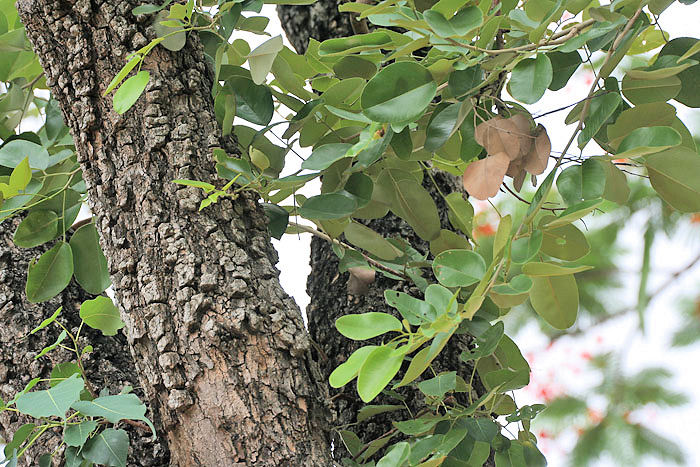
Abb.: कुचन्दनम् । Pterocarpus santalinus L. f. 1781 -
Rote Flügelfrucht - Sandalwood Paduak, Talakona Forest -
తలకోన,
Andhra Pradesh
[Bildquelle: J. M. Garg / Wikimedia. -- GNU FDLicense]
तिलपर्णी - tilaparṇī f.: Sesamblatt
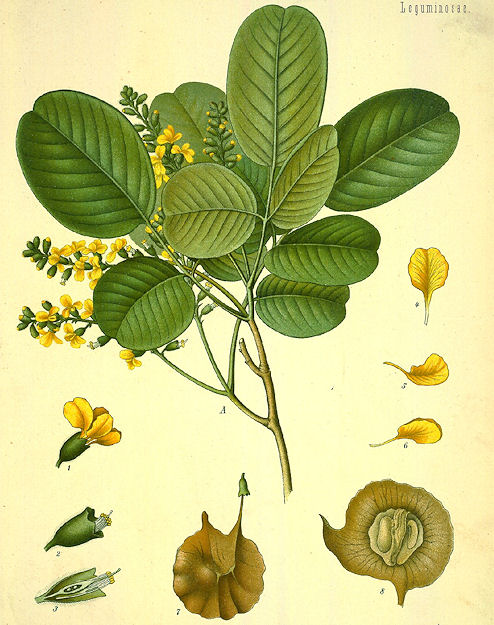
Abb.: तिलपर्णी
। Pterocarpus santalinus L. f. 1781 -
Rote Flügelfrucht - Sandalwood Paduak
[Bildquelle: Köhler, 1883]
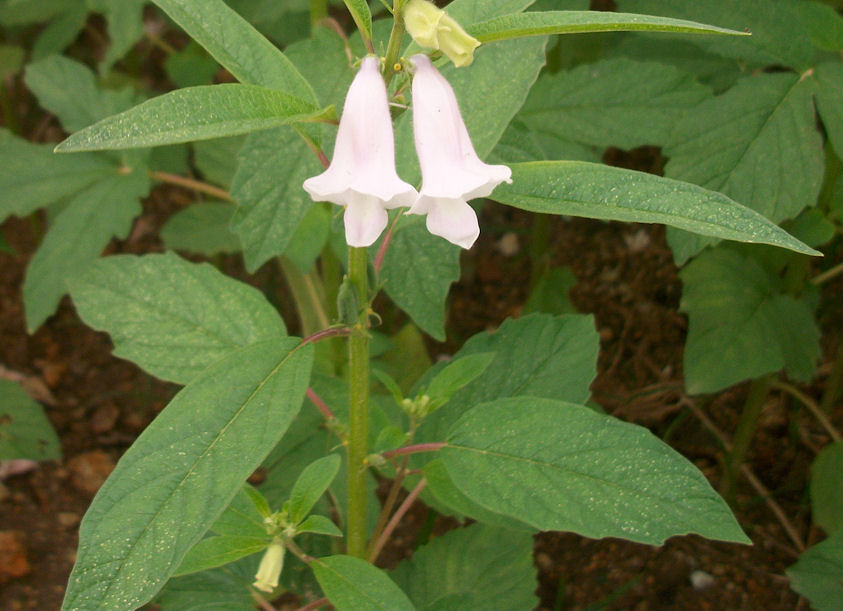
Abb.: Blätter von Sesamum indicum L. 1753 - Sesam
[Bildquelle: KeepOpera / Wikimedia. -- GNU FDLicense]
पत्राङ्ग - patrāṅga n.: "Feder-Gliedriges"
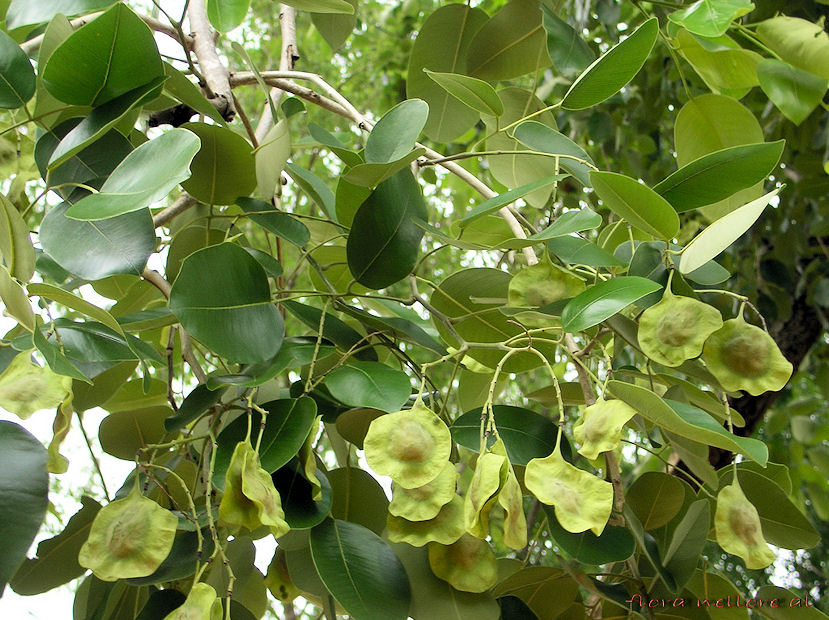
Abb.: पत्राङ्गम् । Pterocarpus santalinus L. f. 1781 -
Rote Flügelfrucht - Sandalwood Paduak, Penchala Kona, Nellore District -
శ్రీ అమరజీవి
పొట్టి శ్రీరాములు నెల్లూరు జిల్లా,
Andhra Pradesh
[Bildquelle: Lalithamba. --
http://www.flickr.com/photos/45835639@N04/4665047219/. -- Zugriff am
2011-03-04. --
Creative
Commons Lizenz (Namensnennung)]
"PTEROCARPUS SANTALINUS, Linn, fil.
Fig.—Bedd. Fl. Sylv., t. 22; Bentl. and Trim., t. 82.
Red Sanders
Hab.—Western Peninsula.
[...]
History, Uses, &c.—According to Sanskrit writers there are three kinds of sandalwood, Srikhanda or white, Pitachandana or yellow, and Raktachandana or red. The first two are the dark and light-coloured wood of Santalum album. Upon the subject of red sandalwood, Dutt (Materia Medica of the Hindus, p. 154,) has the following remark:—"It has been a question how the wood of Pterocarpus santalinus, which is nearly inodorous, came to be called by the name of Raktachandana in Sanskrit and the vernaculars of India. I am inclined to think that it is owing to the similarity in the uses to which the Hindus put both these articles. Both sandalwood and red sandalwood are rubbed on a piece of stone with water, and the emulsions used after bathing and in religious services." Hindu physicians consider red sandalwood to be astringent and tonic; they use it as a cooling application to inflamed parts and to the head in headache; as an external application it is supposed to be more powerful than white sandalwood, given internally to be less, so the two are often combined, and are considered to have similar properties. Mahometan writers follow the Hindus in describing the three kinds of sandalwood and their uses. The author of the Shafa-el-askam says that in bilious fluxes white sandal is used, when blood is being passed red sandal, and when the stools contain both bile and blood the two woods are combined. This treatment must be based upon the doctrine of signatures. Red sanders wood is well known in Europe as an ingredient in French polish."
[Quelle: Pharmacographia indica : a history of the principal drugs of vegetable origin met with in British India / by William Dymock [1834-1892], C. J. H. Warden and David Hooper [1858-1947]. -- Bd. 3. -- London, 1893. -- S. 462.]
"Pterocarpus santalinus (Linn.) Red Sandal-wood
[...]
Description. — Tree, 60 feet or more; [...]
W. & A. Prod. i. 266.—Roxb. Fl. Ind. iii. 234.
Coromandel. Cuddapah. North Arcot. Godavery forests.
Medical Uses.—The wood is dark red with black veins, close, capable of good polish, and sinking in water. It is known in commerce as the Red Sandal-wood which is used chiefly by dyers and colour manufacturers. Also employed to colour several officinal preparations, such as the compound tincture of lavender. This deep-red colouring matter is apparently of a resinous nature. It forms beautifully-coloured precipitates with many metallic solutions. It also yields a kind of dragon's-blood. The wood powdered and mixed with oil is used for bathing and purifying the skin. Also given internally in haemorrhages in powders ground up with milk; and externally, is mixed with honey in case of scabies. Also in certain cases of ophthalmia and sore eyes, beaten up into a paste and applied to the eyes.—Roxb. Ainslie. Lindley."
[Quelle: Drury, Heber <1819 - 1872>: The useful plants of India : with notices of their chief value in commerce, medicine, and the arts. -- 2d ed. with additions and corrections. London : Allen, 1873. -- xvi, 512 p. ; 22 cm. -- s.v.]
| 34a./b. kucandanaṃ cātha jātīkośa-jātīphale same कुचन्दनं चाथ जातीकोश-जातीफले समे ।३४ क। [Bezeichnungen für Myristica fragrans Houtt. 1774 - Muskatnuss - Nutmeg:]
|
Colebrooke (1807): "Mace."
जातीकोश - jātīkośa n.: "Geburts-Behälter", Muskatnuss
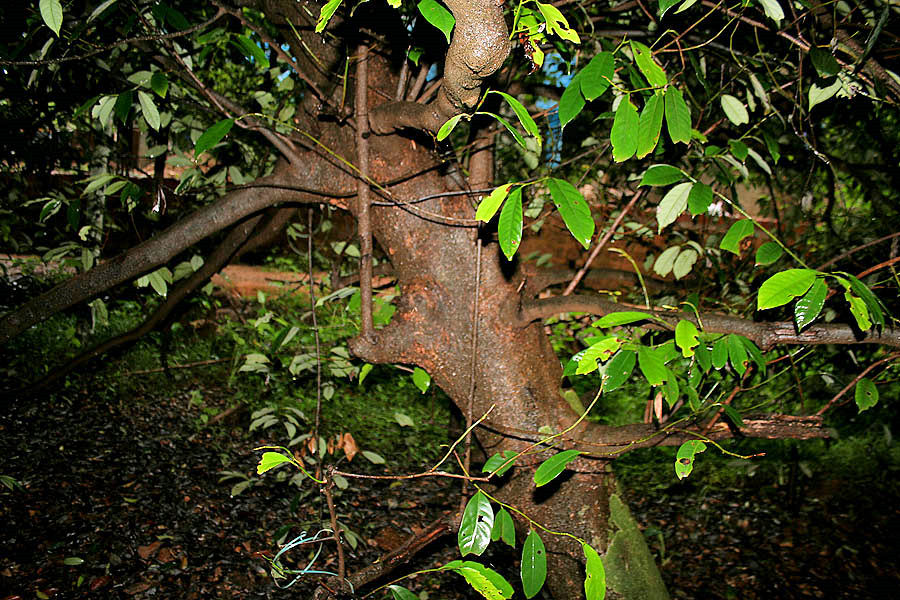
Abb.: जातीकोशम् । Myristica
fragrans Houtt. 1774 - Muskatnuss - Nutmeg, Goa
[Bildquelle: J. M. Garg / Wikimedia. -- GNU FDLicense]
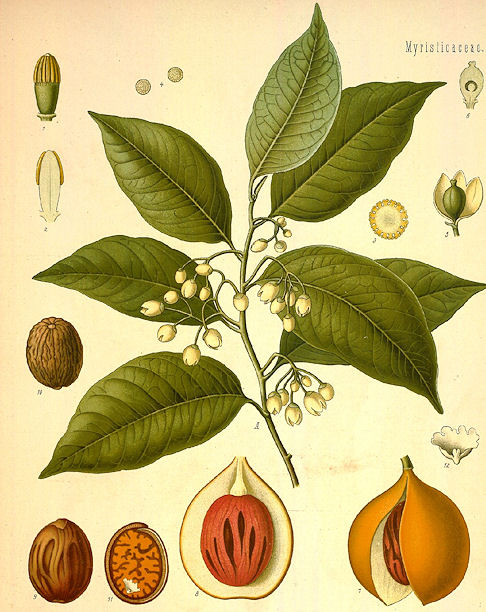
Abb.: जातिकोशम् । Myristica
fragrans Houtt. 1774 - Muskatnuss - Nutmeg
[Bildquelle: Köhler, 1883]
जातीफल - jātīphala n.: "Geburts-Frucht", Muskatnuss
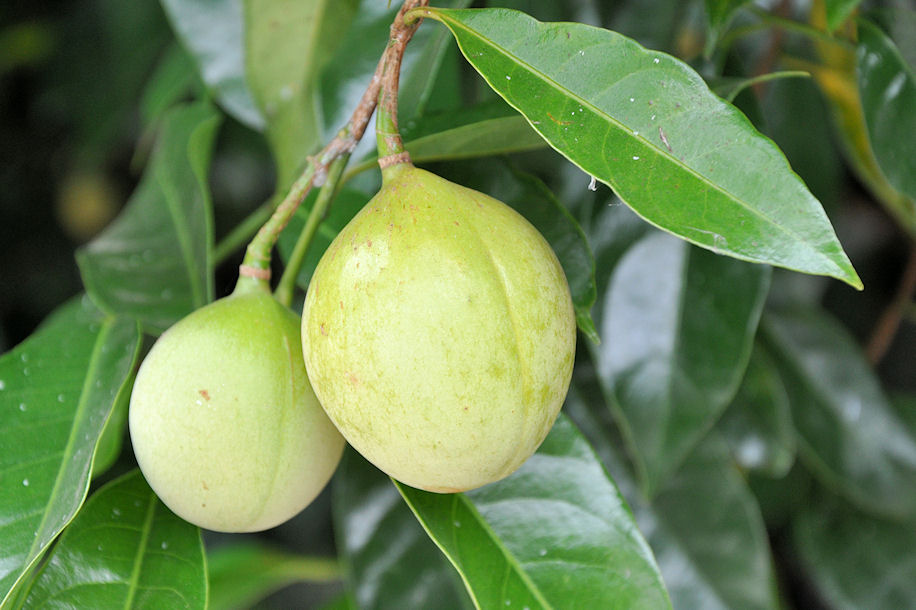
Abb.: जातीफलम् । Myristica
fragrans Houtt. 1774 - Muskatnuss - Nutmeg,
Angamaly - അങ്കമാലി,
Kerala
[Bildquelle: Joe Ravi / Wikipedia. -- GNU FDLicense]
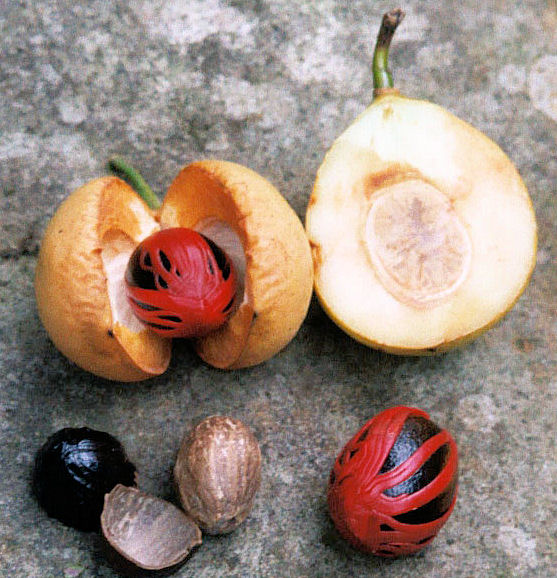
Abb.: जातीफलम् । Myristica
fragrans Houtt. 1774 - Muskatnuss - Nutmeg, Grenada
[Bildquelle: Alexander Daniel / Wikipedia. -- GNU FDLicense]
"MYRISTICA FRAGRANS, Houtt.
Fig.—Bentl. and Trim., t. 218 ; Reichb. Ic. Exot., t. 276-277; Nees, Pl. Med., t. 133; Rumph. Herb. Amb., ii., t. 4.
Nutmeg
Hab.—Moluccas. Cultivated in Penang, Malay Island, and Zanzibar.
[...]
History, Uses, &c.—Natmegs, in Sanskrit Jāti and Jātiphala, are mentioned by Susruta, and in the Nighantas bear various synonyms, such as Jāti-kosha, Jāti-sāra, Shālūka, and Majja-sāra ; they are considered to be hot, digestive, carminative, expectorant and anthelmintic. Mace is called Jāti-pattri, and is said to have similar properties. Both of these spices probably became known in India through the Hindu colonists in Java and the Eastern Islands. From India they would appear to have reached Persia and Eastern Europe. The authors of the Pharmacographia remark that nutmegs were probably known at Constantinople about the year 540. The Arabs evidently first became acquainted with nutmegs through the Persians, as their name Jouz-bawwa is a corruption of the Persian Gauz-i-buya, " fragrant nut." Masudi, who travelled in the East in A.D. 916—920, discovered that they were obtained from the Zerbad Islands. Ibn Sina describes both nutmegs and mace (Basbāseh). Edrisi, who wrote in the middle of the 12th century, mentions both nutmegs and mace (Basbāseh) as articles of import into Aden. By the end of the 12th century both of these spices were well known in Continental Europe,
Mir Muhummad Husain says that the Dutch keep the trade in their own hands, but that he has heard that the tree is now-cultivated in Sounda in Southern India. Whether he was rightly informed with regard to Sounda, we are unable to say. But that his information was substantially correct, there can be no doubt, as Ainslie tells us that in his time the true nutmeg tree was growing in the Tinnevelly District, and produced pretty good fruit. The tree has also been introduced into Ceylon and Zanzibar, and appears to flourish in the warm moist climates of those islands.
Mahometan doctors describe nutmegs and mace as stimulating, narcotic, digestive, tonic, and aphrodisiac, useful in choleraic diarrhoea, especially when roasted; also in obstructions of the liver and spleen. A paste made with nutmegs is used as an external application in nervous headache, palsy, &c.; applied round the eyes it is thought to strengthen the sight. The expressed oil of nutmegs is imported into India from Banda, and is known as Jawitri-ka-tel (oil of mace). It was formerly exclusively brought into European commerce via Holland, in oblong cakes having nearly the form of common bricks, but somewhat smaller, and packed in monocotyledonous leaves, commonly called "flag leaves." At the present time much of the oil is manufactured in Europe, and put up in the same shape, but packed in paper. When discoloured and hardened by age, the oil is called "Banda soap. Oil of mace is manufactured by exposing imperfect and broken nutmegs, reduced to a paste and enclosed in a bag, to steam, and then pressing the bag between heated iron plates. The yield is about 20 to 23 per cent. (Brannt.) The bark of the tree is astringent. (Pereira, Mat. Med., ii., p. 475.) We have found nutmegs and their essential oil a valuable adjunct to other drugs in the treatment of diarrhoea and dysentery; they appear to relieve the pain."
[Quelle: Pharmacographia indica : a history of the principal drugs of vegetable origin met with in British India / by William Dymock [1834-1892], C. J. H. Warden and David Hooper [1858-1947]. -- Bd. 3. -- London, 1893. -- S. 192ff.]
"Myristica moschata (Thunb.)
Nutmeg-tree.
Description.—Tree; [...]
Dec. Prod. xiv. 189.
M. fragrans, Houtt. Hist. Nat. ii. part 3, p. 233. - Blume Rumphia, p. ] 80, t. 55.
M. officinalis, Linn. Hook. Exot. Bot. t. 155, 156.—Rumph. Amb. t. 4.
Cultivated.
Medical Uses.—A volatile oil resides in the kernel of the fruit. It is stimulant and carminative, and in larger doses narcotic. It is used in atonic diarrhoea and some forms of dyspepsia, but is chiefly used as an addition to other remedies. It is used largely as a condiment. Oil of nutmeg is a useful application in rheumatism, paralysis, and sprains, diluted with a bland oil. Mace, the false aril investing the shell of the kernel as met with in commerce, is of a pale cinnamon yellow, and an odour and taste analogous to those of nutmegs. It yields by distillation a volatile oil, which, in composition, effects, and uses, is similar to that of nutmegs. It is chiefly used as a condiment.—Pharm. of India.
Economic Uses.—Indigenous to the Indian Archipelago, but has long been successfully cultivated in the warm moist climate of the western coast of India. The tree begins to bear at eight years old; it is in its prime at twenty-five years, and continues to bear fruit till sixty or older. The mace is dried in the sun, but the nutmegs are smoked by slow fires of wood for three months before they are fit for exportation. The refuse nuts are ground down, and by steaming and pressure afford a brown fluid, which cools into the so-called "nutmeg soap."—(T. Oxley.) In 1870-71 about 7 cwt. of nutmegs were exported from Bombay, and 30 cwt. from Madras, valued respectively at Rs. 575 and Rs. 3012.—Trade Reports."
[Quelle: Drury, Heber <1819 - 1872>: The useful plants of India : with notices of their chief value in commerce, medicine, and the arts. -- 2d ed. with additions and corrections. London : Allen, 1873. -- xvi, 512 p. ; 22 cm. -- s.v.]
| 34c./d. karpūrāgurukastūrī kakkolair yakṣakardamaḥ कर्पूरागुरुकस्तुरी कक्कोलैर् यक्षकर्दमः ॥३४ ख॥ Kampfer, Adlerholz, Moschus mit Kubeben-Pfefferkörnern (gemischt) heißt यक्षकर्दम - yakṣakardama m.: Yakṣa-Schlamm1 |
Colebrooke (1807): "Perfumed paste. Consisting of camphor, agallochum, musk, bdellium, (or else the three first, with saffron and sandal wood,) in equal proportions."
karpūra: Kampfer von Cinnamomum camphora (L.) J. Presl 1825 - Kampferbaum - Camphor Tree bzw. Dryobalanops aromatica Gaertn. 1805 - Borneokampfer - Baru Camphor (siehe oben!)
aguru: Aquilaria agallocha Roxb. - Adlerholzbaum - Agarwood (siehe oben!)
kasturī f.: Moschus (siehe oben!)
kakkola m.: Piper cubeba L. f. 1782 - Kubeben-Pfeffer - Tailed Pepper (siehe oben)
1 यक्षकर्दम - yakṣakardama m.: Yakṣa-Schlamm
"YAKSHAS. A class of supernatural beings attendant on Kuvera, the god of wealth. Authorities differ as to their origin. They have no very special attributes, but they are generally considered as inoffensive, and so are called Puṇya-janas, good people, but they occasionally appear as imps of evil. It is a Yaksha in whose mouth Kāli-dāsa placed his poem Megha-dūta (cloud messenger)."
[Quelle: Dowson, John <1820-1881>: A classical dictionary of Hindu mythology and religion, geography, history, and literature. -- London, Trübner, 1879. -- s.v. ]
Commiphora wightii (Arn.) Bhandari. - Guggul - Bdellium
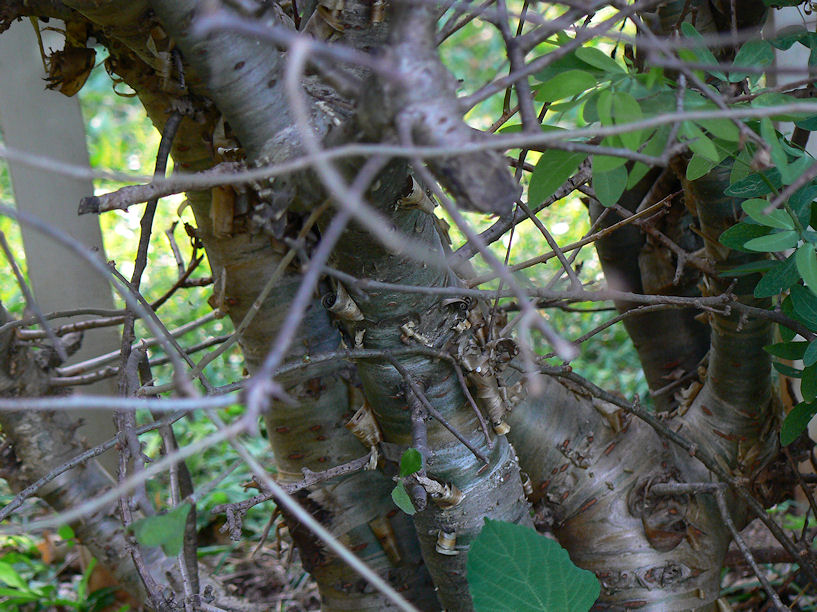
Abb.:
Commiphora wightii (Arn.) Bhandari.
[Bildquelle: dinesh_valke. --
http://www.flickr.com/photos/dinesh_valke/2095517392/. -- Zugriff am
2011-03-07. --
Creative
Commons Lizenz (Namensnennung, keine kommerzielle Nutzung, keine
Bearbeitung)]
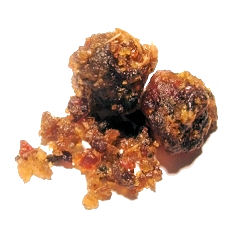
Abb.: Guggul - Bdellium: Harz von Commiphora wightii
(Arn.) Bhandari.
[Bildquelle: Sjschen / Wikimedia. -- GNU
FDLicense]
"
Other allied Gum Resins.—From Berbera also comes Bdellium (Vem. Mhaisābol, or Bysabol). In the bales of this drug two distinct kinds are met with, viz., ordinary Bdellium, which to a certain extent resembles Myrrh, but is of a darker colour, less oily, and has a peculiar odour destitute of the aroma of Myrrh, and a perfumed kind called by the Arabs Habak-Hadee, which occurs in irregular-shaped pieces more or less flat, some of them having earth and fragments of bark adhering; it is of a dark reddish brown colour, but opaque yellowish white streaks run through the semi-transparent reddish mass. The odour is more powerful and more perfumed than that of common Bdellium; the taste perfumed, aromatic, and feebly bitter, whereas common Bdellium is strongly bitter and has hardly any aroma. Indian Bdellium (Mhaisagūggal), the produce of Balsamodendron Mukul, somewhat resembles the African drug in general appearance, the pieces often having portions of papery bark attached to them, but the colour is lighter, often greenish ; the odour and taste are somewhat different, and a certain proportion of it is in distinct vermiform pieces as thick as the little finger. Its value is one-third less than that of African Bdellium. Opaque Bdellium is found in small quantities in the packages of Myrrh and other gums which come from Africa. It is known in Bombay as Meenaharma, and is of a yellowish white colour; and quite opaque like ammoniacum ; it has hardly any odour, but a very bitter taste. The native practitioners use it to facilitate the extraction of Guinea-worms; it would appear to poison the animal, as it makes it loosen its hold upon the tissues. Indian Bdellium (Mhaisagūggal), the produce of Balsamodendron Boxburghii, occurs in irregular lumps, covered more or less with dirt and hair, to which portions of papery bark as well as the thick inner bark sometimes adhere; it is of a greenish yellow colour, with an occasional tinge of red; consistence waxy, soft, and brittle; odour peculiar and balsamic, something like cedarwood; taste bitter. With water it forms a greyish-white emulsion ; when inflamed it swells and sputters instead of burning with a clear flame like the Guggal of Boswellia serrata. We have been favoured by Mr. Woodrow with fresh specimens of the stem and exudation of B. Rox burghii collected near Peit, about 3.0 miles north of Poona, where the tree has been planted to form a hedge round a Hindu temple."[Quelle: Pharmacographia indica : a history of the principal drugs of vegetable origin met with in British India / by William Dymock [1834-1892], C. J. H. Warden and David Hooper [1858-1947]. -- Bd. 1. -- London, 1890. -- S. 310f.]
| 35a./b. gātrānulepanī vartir varṇakaṃ syād vilepanam गात्रानुलेपनी वर्तिर् वर्णकं स्याद् विलेपनम् ।३५ क।
|
Colebrooke (1807): "Perfume for the person. Whether ground and pounded, or not ; but some distinguish the two last as restricted to perfumes ground."
वर्णक - varṇaka n.: Malfarbe, Schminke

Abb.: वर्णकम् । Reklame für Haut-Aufheller-Creme im Fernsehen
[Bildquelle: Gary Graves. --
http://www.flickr.com/photos/ggraves/4503383035/. -- Zugriff am
2011-03-09. --
Creative Commons Lizenz (Namensnennung, keine kommerzielle Nutzung,
keine Bearbeitung)]
| 35c./d. cūrṇāni vāsayogāḥ syur bhāvitaṃ
vāsitaṃ triṣu चूर्णानि वासयोगाः स्युर् भावितं वासितं त्रिषु ॥३५ ख॥ [Bezeichnungen für Puder:]
|
Colebrooke (1807): "Powder. To be thrown on the clothes ; red powder, &c."
| 35c./d. cūrṇāni vāsayogāḥ syur bhāvitaṃ
vāsitaṃ triṣu चूर्णानि वासयोगाः स्युर् भावितं वासितं त्रिषु ॥३५ ख॥ [Bezeichnungen für parfümiert:]
|
Colebrooke (1807): "Perfumed."
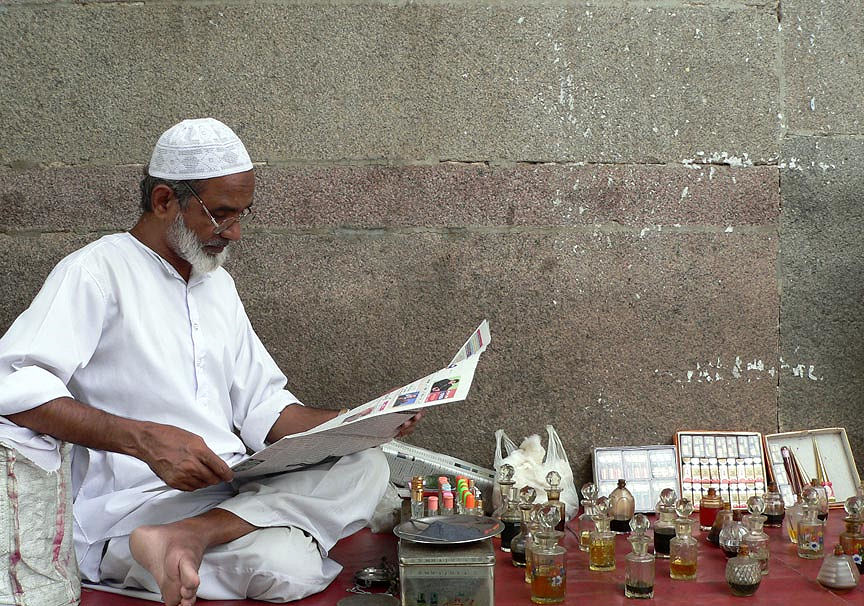
Abb.: वासाः । Parfümverkäufer vor Moschee, Hyderabad -
హైదరాబాద్,
Andhra Pradesh
[Bildquelle:
Koshy Koshy. --
http://www.flickr.com/photos/kkoshy/2866148863/. -- Zugriff am
2011-03-06. --
Creative
Commons Lizenz (Namensnennung)]
वासित - vāsita 3: parfümiert

Abb.: वासिता । "Labanyavati perfumed by her maids", Orissa, 18. Jhdt.
[Bildquelle: Asian Curator at The San Diego Museum of
Art. --
http://www.flickr.com/photos/asianartsandiego/4836265858/. -- Zugriff am
2011-03-06. --
Creative Commons Lizenz (Namensnennung, keine kommerzielle Nutzung,
keine Bearbeitung)]
भावित - bhāvita 3: zur Existenz gebracht, entfaltet

भाविता ।
[Plakat, Genf, 1913]
| 36a./b saṃskāro gandhamālyādyair yaḥ syāt tad adhivāsanam संस्कारो गन्धमाल्याद्यैर् यः स्यात् तद् अधिवासनम् ।३६ क। Wenn man sich mit Duftstoffen, Kränzen u. ä. zurechtmacht, heißt das अधिवासन - adhvāsana n.: zusätzliches Bekleiden, Parfümierung |
Colebrooke (1807): "Adjusting with perfumes. With fragrant wreathes, resins, &c."
| 36c./d. mālyaṃ mālā-srajau mūrdhni keśamadhye tu garbhakaḥ माल्यं माला-स्रजौ मूर्ध्नि केशमध्ये तु गर्भकः ॥३६ ख॥ [Bezeichnungen für Kranz] auf dem Kopf
|
Colebrooke (1807): "A chaplet."
माला - mālā f.: Kranz
Abb.: मालाः । Jasminkränze (மல்லிகை), Chennai - சென்னை, Tamil Nadu
[Bildquelle: Chandrachoodan Gopalakrishna. -- http://www.flickr.com/photos/ravages/2631488198/. -- Zugriff am 2011-03-07. -- Creative Commons Lizenz (Namensnennung, keine kommerzielle Nutzung, share alike)]
माल्य - mālya n.: Kranz

Abb.: माल्यानि । Kuchipudi-Tänzerinnen - కూచిపూడి, Hyderabad
- హైదరాబాద్,
Andhra Pradesh
[Bildquelle: Hiramrajkamal / Wikipedia. -- Public domain]
स्रज - sraj f.: Kranz

Abb.: स्रक् । Tamilische Hochzeit, Mumbai - मुंबई, Maharashtra
[Bildquelle:
Anand Balasubramaniam. --
http://www.flickr.com/photos/wormtongue/4254239086/. -- Zugriff am
2011-03-06. --
Creative Commons Lizenz (Namensnennung, keine kommerzielle Nutzung,
keine Bearbeitung)]
| 36c./d. mālyaṃ mālā-srajau mūrdhni keśamadhye tu garbhakaḥ माल्यं माला-स्रजौ मूर्ध्नि केशमध्ये तु गर्भकः ॥३६ ख॥ Ein Kranz inmitten der Haare heißt गर्भक - garbhaka m.: in die Haare verschlungener Blütenkranz (zu garbha m.: Mutterleib, Inneres |
Colebrooke (1807): "One worn in the hair.

Abb.: गर्भकः । Mohiniyattam-Tänzerin -
മോഹിനിയാട്ടം,
Kerala
[Bildquelle: Oct11988duh / Wikipedia. -- Public domain]
| 37a./b. prabhraṣṭakaṃ śikhālambi puronyastaṃ lalāmakam प्रभ्रष्टकं शिखालम्बि पुरोन्यस्तं ललामकम् ।३७ क। Ein Kranz, der von der śikhā herabhängt, heißt प्रभ्रष्टक - prabhraṣṭaka n.: "Herabfallendes" |
Colebrooke (1807): "Or suspended from the middle lock."
शिखा - śikhā f.: Haarbüschel, Haarsträhne, Pfauenkamm, Flamme, Gipfel (siehe http://www.payer.de/amarakosa3/amara211d.htm)
प्रभ्रष्टक - prabhraṣṭaka n.: "Herabfallendes"

Abb.:
प्रभ्रष्टकम्
। Tirukkalikundram, Tamil Nadu
[Bildquelle: Bram. --
http://www.flickr.com/photos/brumd/3282847684/. -- Zugriff am
2011-03-07. --
Creative
Commons Lizenz (Namensnennung, keine kommerzielle Nutzung, share alike)]
| 37a./b. prabhraṣṭakaṃ śikhālambi puronyastaṃ lalāmakam प्रभ्रष्टकं शिखालम्बि पुरोन्यस्तं ललामकम् ।३७ क। Ein Kranz, der vorne (vom Kopf) herabfällt, heißt ललामक - lalāmaka n.: auf der Stirn liegender Blumenkranz |
Colebrooke (1807): "Or falling over the forehead."
| 37c./d. prālambam ṛjulambi syāt kaṇṭhād vaikakṣikaṃ tu tat प्रालम्बम् ऋजुलम्बि स्यात् कण्ठाद् वैकक्षिकं तु तत् ॥३७ ख॥ Ein Kranz, der vom Hals gerade herabhängt, heißt प्रालम्ब - prālamba n.: Herabhängendes, Gehänge |
Colebrooke (1807): "Or hung round the neck."
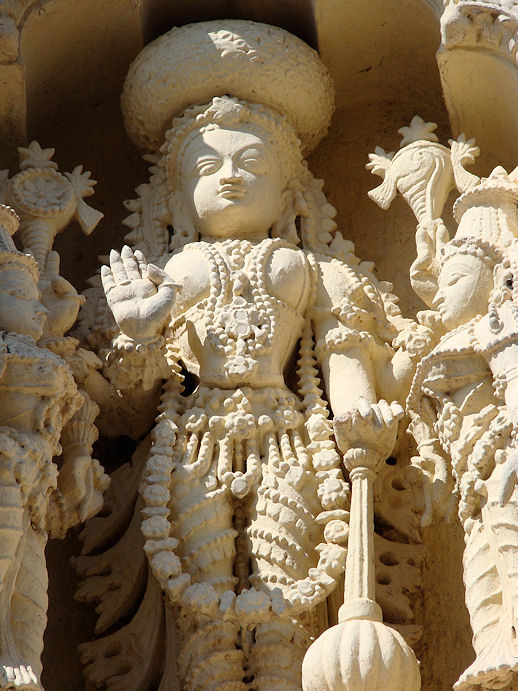
Abb.: प्रालम्बम् । Viṣṇu (mit Blütenkranz), Srirangapatna -
ಶ್ರೀರಂಗಪಟ್ಟಣ,
Karnataka
[Bildquelle:
Gopal Venkatesan. --
http://www.flickr.com/photos/gopalarathnam_v/3150348586/. -- Zugriff am
2011-03-07. --
Creative
Commons Lizenz (Namensnennung, share alike)]

Abb.: प्रालम्बम् । Braut
[Bildquelle: rajkumar1220. --
http://www.flickr.com/photos/ahinsajain/5221172986/. -- Zugriff am
2011-03-07. --
Creative
Commons Lizenz (Namensnennung)]

Abb.: प्रालम्बे । Thaipusam-Fest (தைப்பூசம்)
der Tamilen, Kuala Lumpur, Malaysia
[Bildquelle: Mister Jo. --
http://www.flickr.com/photos/guerinjeanmarc/5382969672/. -- Zugriff am
2011-03-07. --
Creative
Commons Lizenz (Namensnennung)]
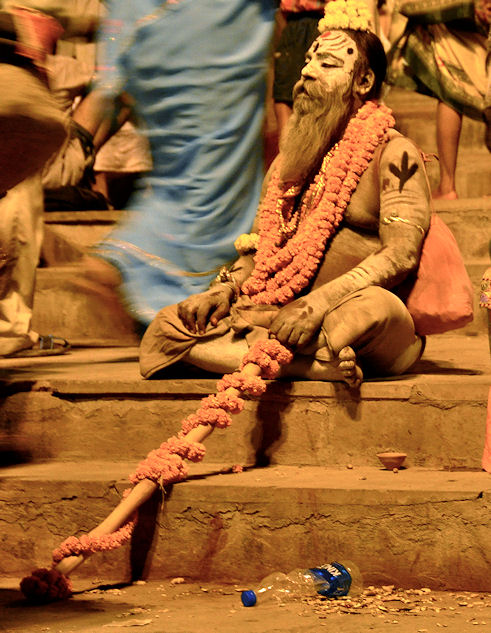
Abb.: प्रालम्बानि । Varanasi - वाराणसी, Utttar Pradesh
[Bildquelle:
Shreyans Bhansali. --
http://www.flickr.com/photos/thebigdurian/4139189215/.
-- Zugriff am 2011-03-07. --
Creative
Commons Lizenz (Namensnennung, keine kommerzielle Nutzung, share alike)]
| 37c./d. prālambam ṛjulambi syāt kaṇṭhād vaikakṣakaṃ tu tat 38a./b. yat tiryak kṣiptam urasi śikhāsv āpīḍa-śekharau
प्रालम्बम् ऋजुलम्बि स्यात् कण्ठाद् वैकक्षकं तु तत्
॥३७ ख॥ Ein Kranz, der auf der Brust waagrecht umgeworfen ist, heißt वैकक्षक - vaikakṣaka n.: "Versteckendes", Überwurf |
Colebrooke (1807): "Or worn as a scarf."

Abb.:
वैकक्षकम् । New Delhi
[Bildquelle: Anil Gautam. --
http://www.flickr.com/people/prism0710/. -- Zugriff am 2011-03-07. --
Creative
Commons Lizenz (Namensnennung, keine kommerzielle Nutzung, share alike)]

Abb.: वैकक्षकम्
। Braut, Chennai -
சென்னை, Tamil Nadu
[Bildquelle:
Kamakshi Sachidanandam. --
http://www.flickr.com/photos/rx_kamakshi/196344285/. -- Zugriff am
2011-03-07. --
Creative Commons Lizenz (Namensnennung, keine kommerzielle Nutzung,
keine Bearbeitung)]
| 38a./b. yat tiryak kṣiptam urasi śikhāsv āpīḍa-śekharau यत् तिर्यक् क्षिप्तम् उरसि शिखास्व् आपीड-शेखरौ ।३८ क। Ein Kranz auf den Śikhā's heißt:
|
Colebrooke (1807): "Or tied on the crown."
शिखा - śikhā f.: Haarbüschel, Haarsträhne, Pfauenkamm, Flamme, Gipfel (siehe http://www.payer.de/amarakosa3/amara211d.htm)
आपीड - āpīḍa m.: "Drückender", Druck
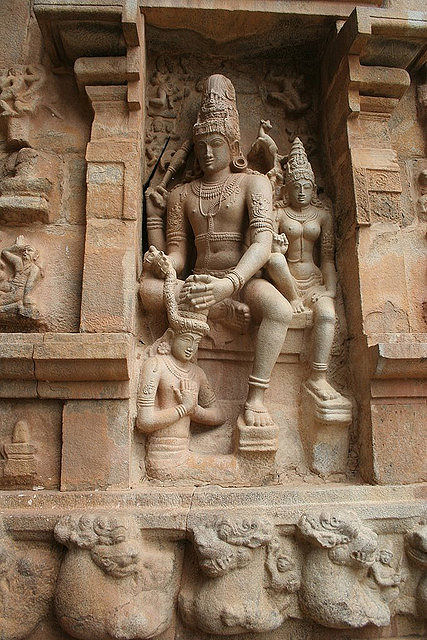
Abb.: आपीडः । Śiva krönt Candeśa mit einem Blütenkranz, Gangaikonda Cholapuram - கங்கைகொண்ட
சோழபுரம், Tamil Nadu, 11. Jhdt. n. Chr.
[Bildquelle: swamysk. --
http://www.flickr.com/photos/swamysk/1461645946/. -- Zugriff am
2011-03-07. --
Creative Commons Lizenz (Namensnennung, keine kommerzielle Nutzung,
keine Bearbeitung)]
शेखर - śekhara m.: Gipfel, Diadem
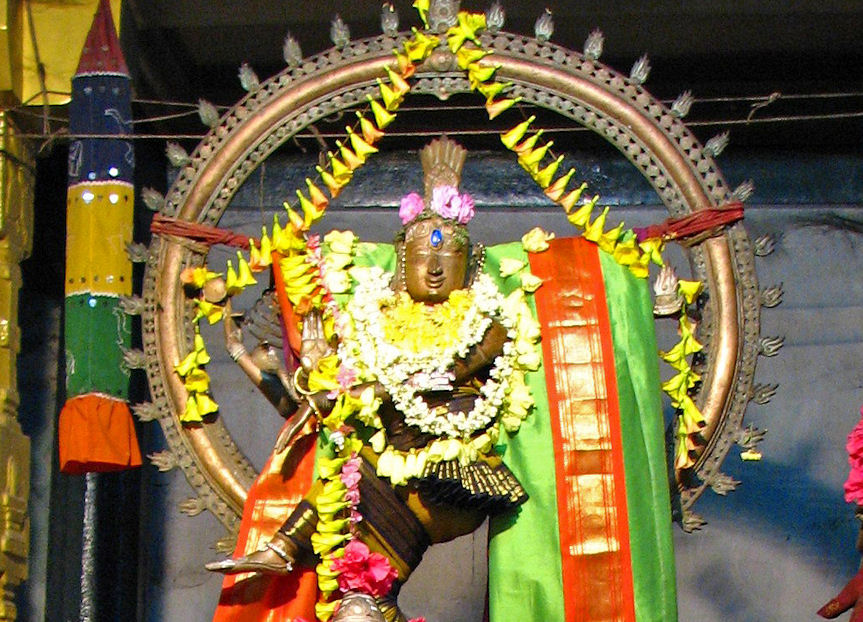
Abb.: शेखरः । Śiva Nāṭyarāja, Kanchipuram - காஞ்சிபுரம், Tamil Nadu
[Bildquelle: McKay Savage. --
http://www.flickr.com/photos/mckaysavage/1885620624/. -- Zugriff am
2011-03-07. --
Creative
Commons Lizenz (Namensnennung)]
| 38c./d. racanā syāt parisyandaa ābhogaḥ paripūrṇatā रचना स्यात् परिस्यन्द आभोगः परिपूर्णता ॥३८ ख॥ a var. lect. parispanda (m.: Bewegung) [Bezeichnungen für Frisur:]
|
Colebrooke (1807): "Decoration of hair."
रचना - racanā f.: Ordnen, Ordnung, Anordnen
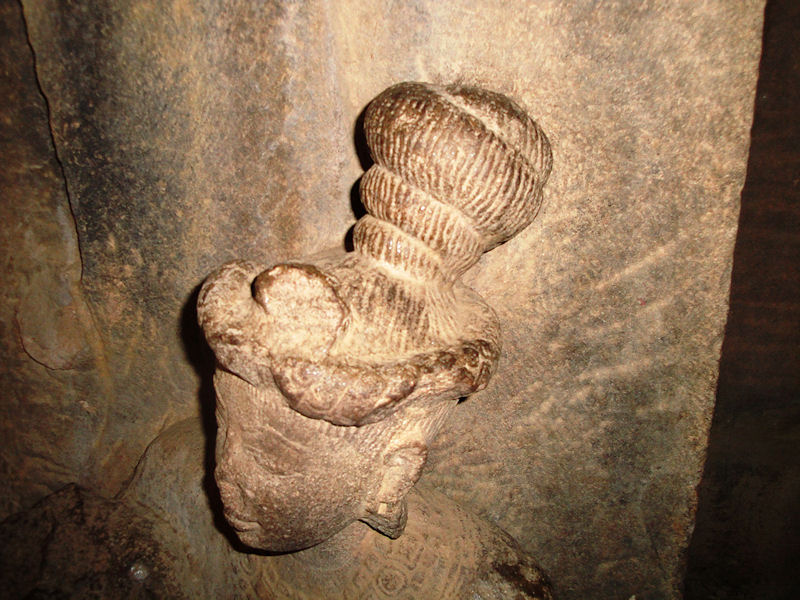
Abb.: रचना । Virupaksha Tempel, Pattadakal -
ಪಟ್ಟದಕಲ್,
Karnataka, 760/780 n. Chr.
[Bildquelle: Rakhee. --
http://www.flickr.com/photos/olderock/4471125263/. -- Zugriff am
2011-03-10. --
Creative Commons Lizenz (Namensnennung, keine kommerzielle Nutzung,
keine Bearbeitung)]
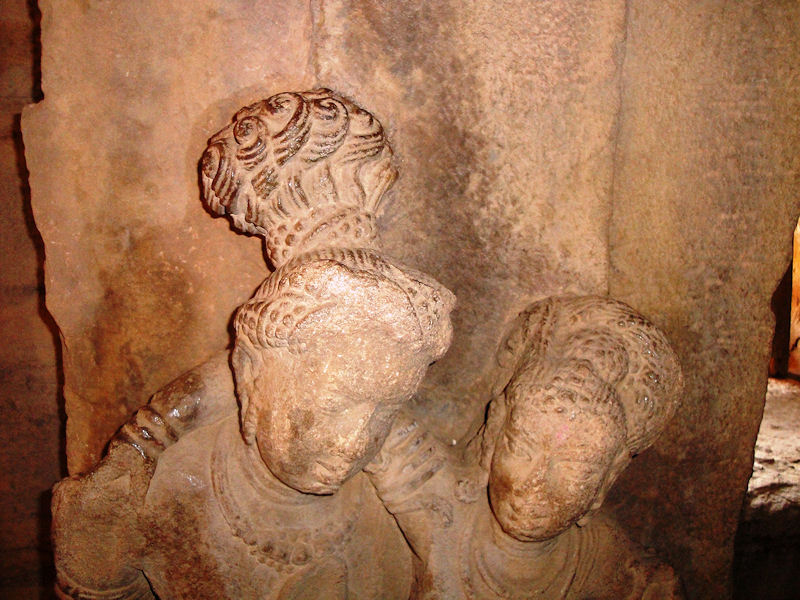
Abb.: रचना । Virupaksha Tempel, Pattadakal -
ಪಟ್ಟದಕಲ್,
Karnataka, 760/780 n. Chr.
[Bildquelle: Rakhee. --
http://www.flickr.com/photos/olderock/4471124037/. -- Zugriff am
2011-03-10. --
Creative Commons Lizenz (Namensnennung, keine kommerzielle Nutzung,
keine Bearbeitung)]
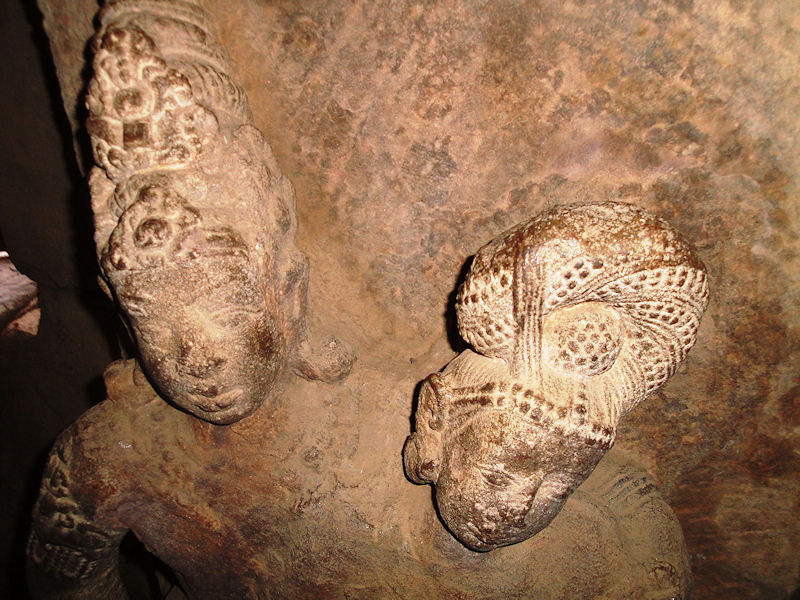
Abb.: रचना । Virupaksha Tempel, Pattadakal -
ಪಟ್ಟದಕಲ್,
Karnataka, 760/780 n. Chr.
[Bildquelle: Rakhee. --
http://www.flickr.com/photos/olderock/4471127719/. -- Zugriff am
2011-03-10. --
Creative Commons Lizenz (Namensnennung, keine kommerzielle Nutzung,
keine Bearbeitung)]
परिस्यन्द - parisyanda m.: Strom, Fluss
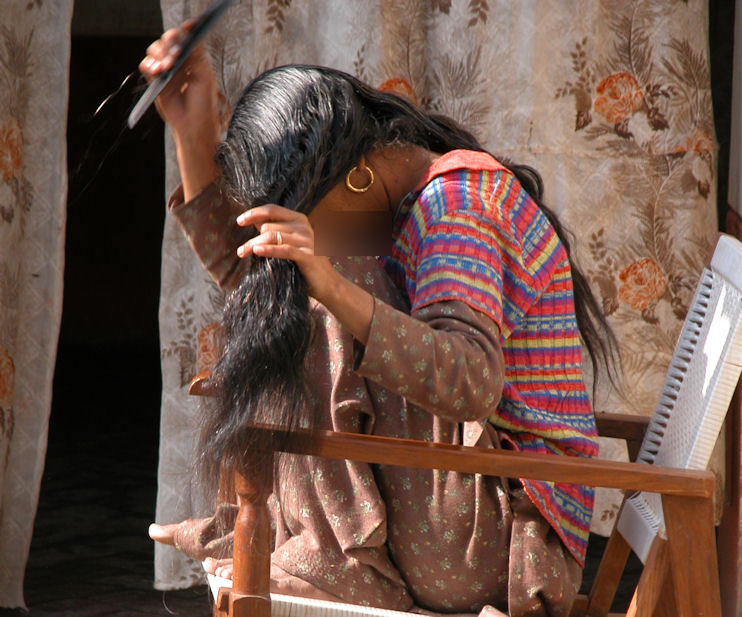
Abb.: परिस्यन्दः । Punjab
[Bildquelle: Matt Corks. --
http://www.flickr.com/photos/mvcorks/312446276/. -- Zugriff am
2011-03-10. --
Creative
Commons Lizenz (Namensnennung, keine kommerzielle Nutzung, share alike)]
| 38c./d. racanā syāt parisyanda ābhogaḥ paripūrṇatā रचना स्यात् परिस्यन्द आभोगः परिपूर्णता ॥३८ ख॥ [Bezeichnungen für Vollendung, Fülle:]
|
Colebrooke (1807): "Completion or fullness."
आभोग - ābhoga m.: Rundung, Umfang, Fülle

Abb.: आभोगः । Sikh-Hochzeit, USA
[Bildquelle:
Gurumustuk Singh. --
http://www.flickr.com/photos/mrsikhnet/241566029/. -- Zugriff am
2011-03-10. --
Creative
Commons Lizenz (Namensnennung, keine kommerzielle Nutzung, share alike)]
परिपूर्णता - paripūrṇatā f.: Erfüllung, Vollendung
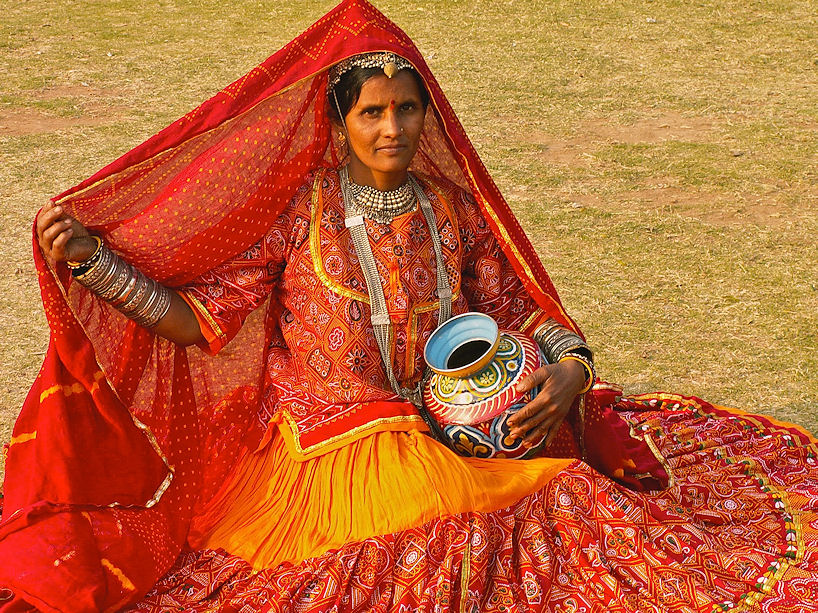
Abb.: परिपूर्णता
। Braut, Agra, Uttar Pradesh
[Bildquelle: Paul Stocker. --
http://www.flickr.com/photos/paalia/2558350880/. -- Zugriff am
2011-03-10. --
Creative
Commons Lizenz (Namensnennung)]
| 39a./b. upadhānaṃ tūpabarhaḥ śayyāyāṃ śayanīyavat उपधानं तूपबर्हः शय्यायां शयनीयवत् ।३९ क। [Bezeichnungen für Kissen:]
|
Colebrooke (1807): "A pillow."
उपधान - upadhāna n.: Aufsetzen, Kissen, Polster
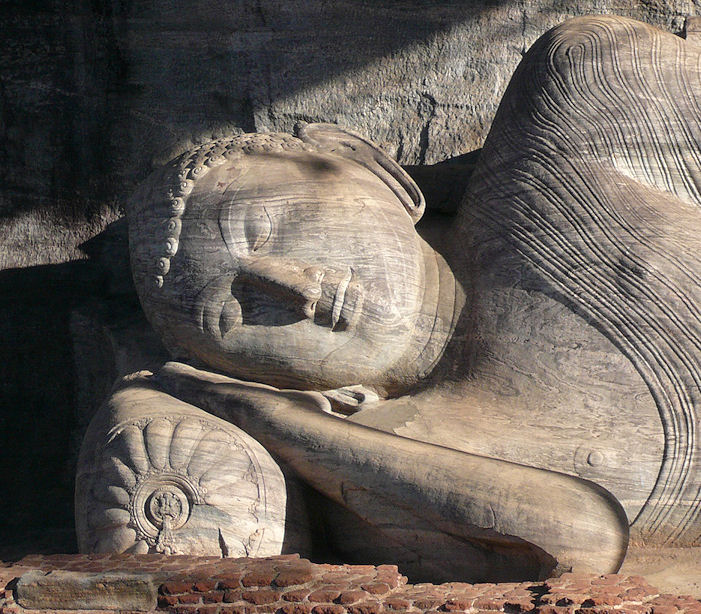
Abb.: उपधानम् । Liegender Buddha, Polonnaruwa - පොළොන්නරුව,
Sri Lanka
[Bildquelle: Lankapic / Wikipedia. -- GNU FDLicense]
उपबर्ह - upabarha m.: Kissen, Polster ("Stärkung")
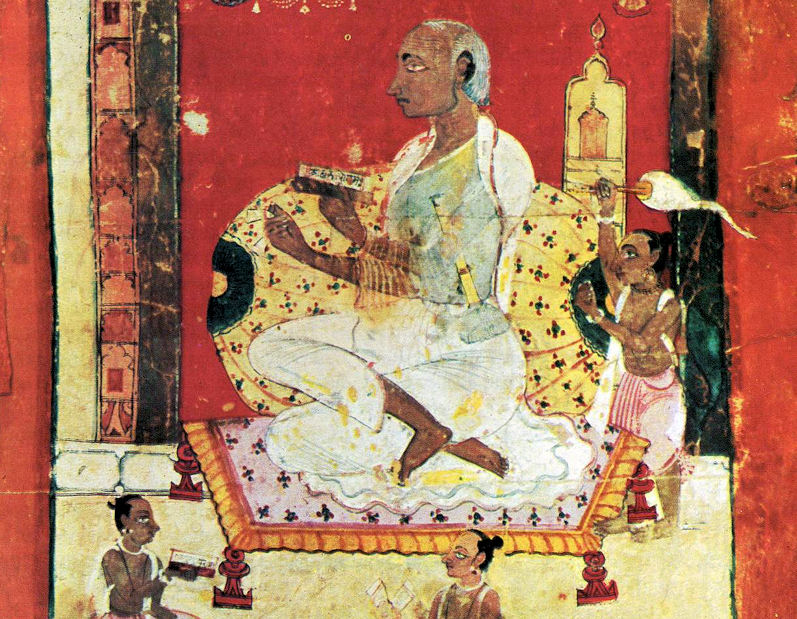
Abb.: उपबर्हः । Lehrer, Bundi - बूंदी, Rajasthan, 16. Jhdt.
| 39. upadhānaṃ tūpabarhaḥ śayyāyāṃ śayanīyavat śayanaṃ mañca-paryaṅka-palyaṅkāḥ khaṭvyā samāḥ
उपधानं तूपबर्हः शय्यायां शयनीयवत् । Bezeichnungen für शय्या - śayyā f.: Lager, Bett sind Wortbildungen in der Art von शयनीय - śayanīya n.: zum Liegen Dienendes, Liegestatt |
Colebrooke (1807): "A bed."
शय्या - śayyā f.: Lager, Bett
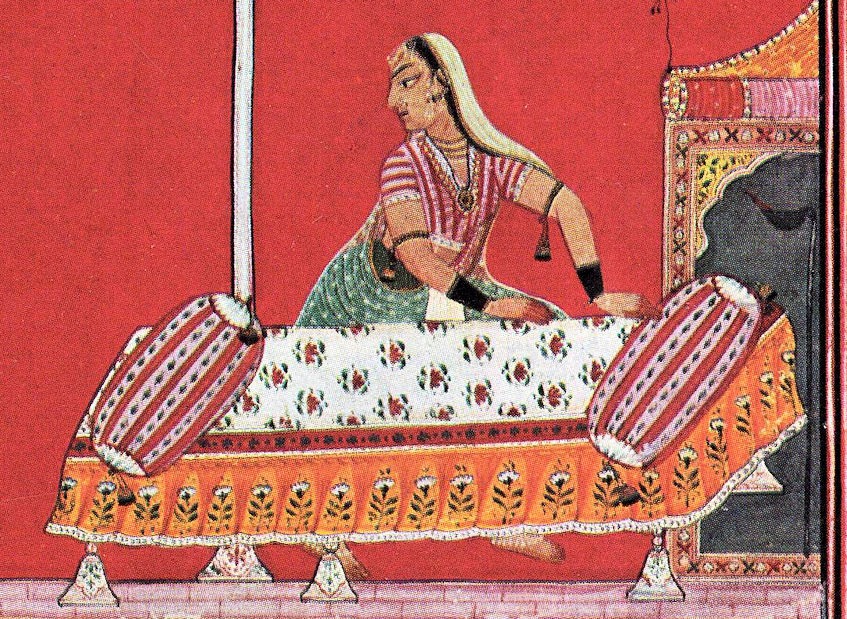
Abb.: शय्या । Radhā bereitet das Lager Kṛṣṇas, Basohli - बशोली, Ende 17. Jhdt.
शयनीय - śayanīya n.: zum Liegen Dienendes, Liegestatt
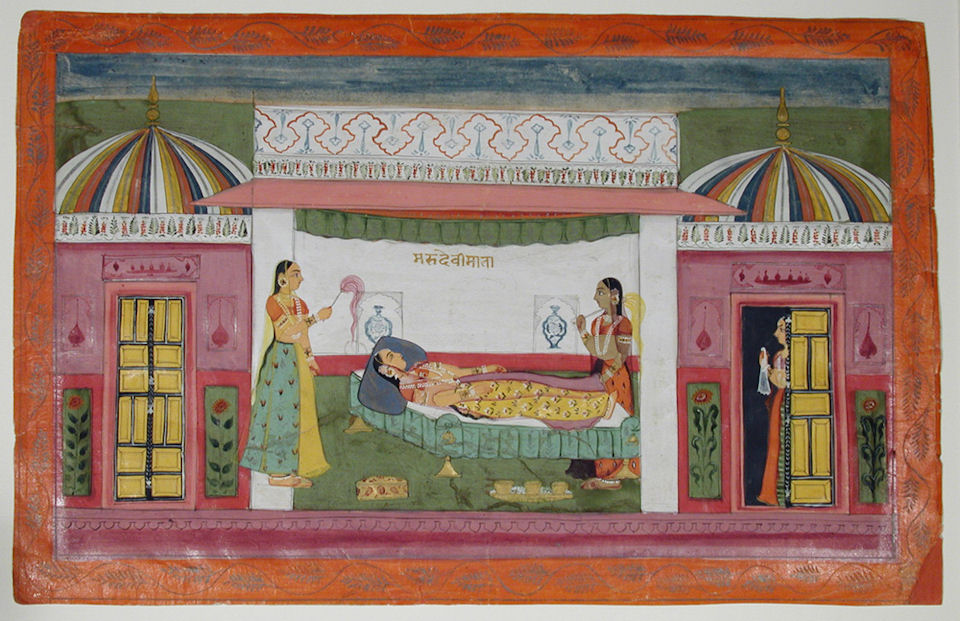
Abb.: शयनीयम् । Rajasthan, ca. 1680
[Bildquelle: Asian Curator at The San Diego Museum of
Art. --
http://www.flickr.com/photos/asianartsandiego/4835652111/. -- Zugriff am
2011-03-06. --
Creative Commons Lizenz (Namensnennung, keine kommerzielle Nutzung,
keine Bearbeitung)]
| 39c./d. śayanaṃ mañca-paryaṅka-palyaṅkāḥ khaṭvyā samāḥ शयनं मञ्च-पर्यङ्क-पल्यङ्काः खट्व्या समाः ॥३९ ख॥ [Bezeichnungen für Bett:]
|
Colebrooke (1807): "A bedstead."
मञ्च - mañca m.: Schaugerüst, Tribüne, Bett
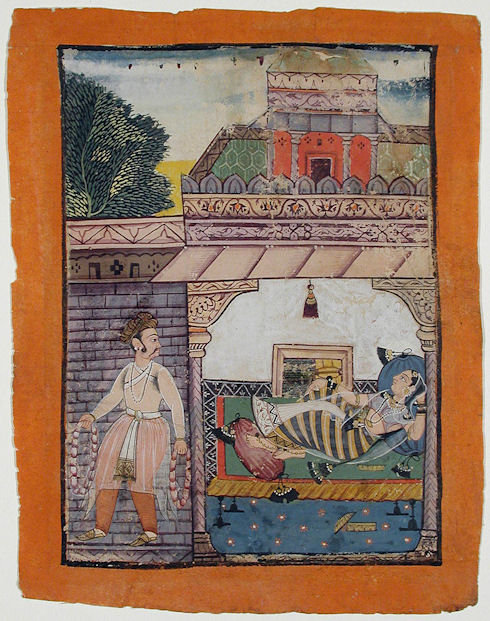
Abb.: मञ्चः । Rajasthan, ca. 1630
[Bildquelle: Asian Curator at The San Diego Museum of
Art. --
http://www.flickr.com/photos/asianartsandiego/4835687725/. -- Zugriff am
2011-03-06. --
Creative Commons Lizenz (Namensnennung, keine kommerzielle Nutzung,
keine Bearbeitung)]
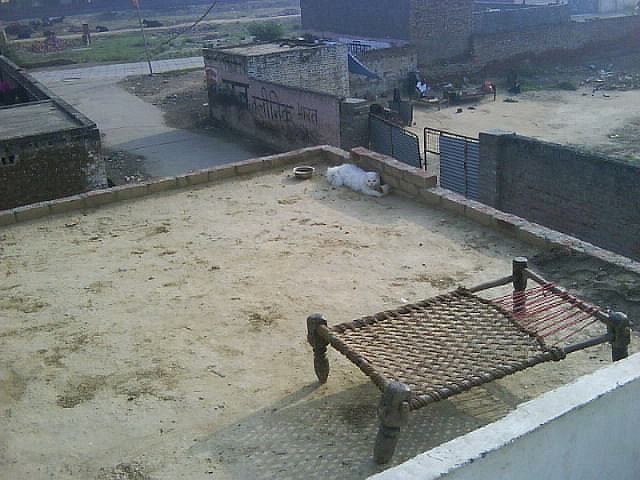
Abb.: मञ्चः । Karnal -
करनाल, Haryana
[Bildquelle: sarahamina. --
http://www.flickr.com/photos/29208923@N06/3716085997/. -- Zugriff am
2011-03-07. --
Creative
Commons Lizenz (Namensnennung, keine kommerzielle Nutzung, share alike)]
खट्वा - khaṭvā f.: Bett
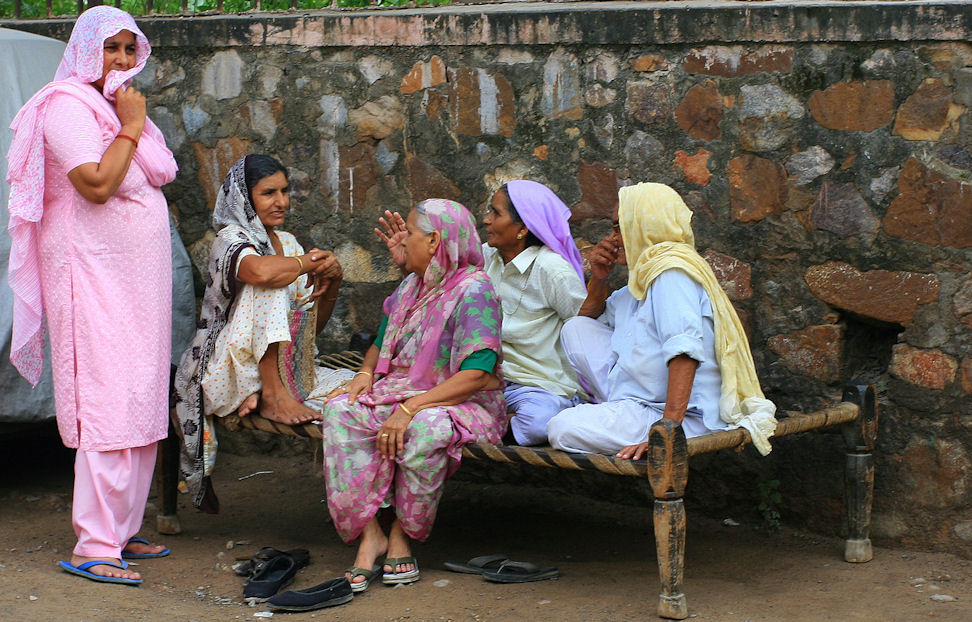
Abb.: खट्वा । Neu Delhi
[Bildquelle: Carol Mitchell. --
http://www.flickr.com/photos/webethere/1257035928/. -- Zugriff am
2011-03-07. --
Creative Commons Lizenz (Namensnennung, keine Bearbeitung)]
पर्यङ्क - paryaṅka m.: Sitzen mit untergeschlagenen Beinen, Sofa, Diwan, Thronsessesel
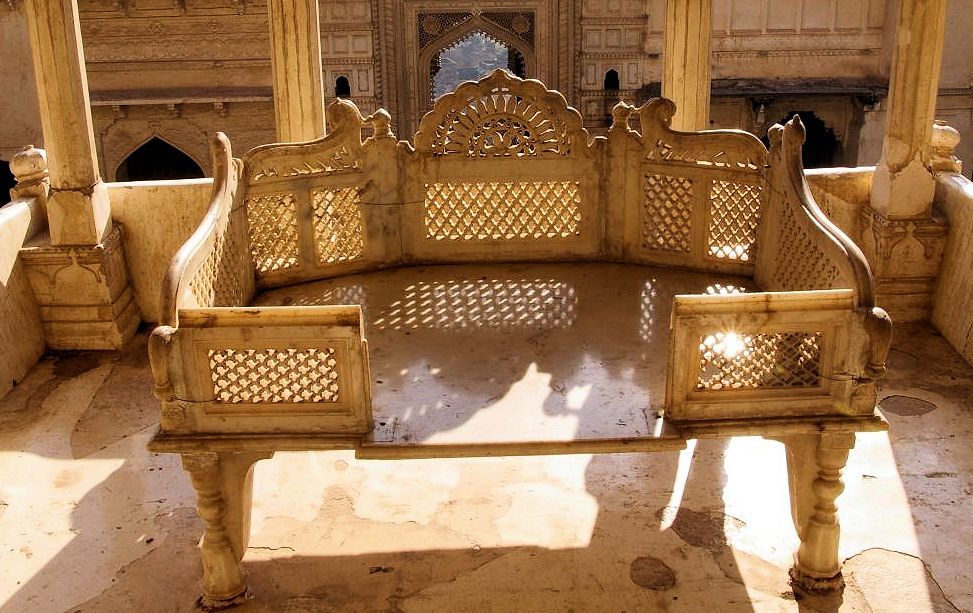
Abb.: पर्यङ्कः । Thron, Palast, Bundi - बूंदी, Rajasthan
[Bildquelle: Andrea Kirkby. --
http://www.flickr.com/photos/andreakirkby/5483502082/. -- Zugriff am
2011-03-10. --
Creative Commons Lizenz (Namensnennung, keine kommerzielle Nutzung)]
| 40a./b gendukaḥ kanduko dīpaḥ pradīpaḥ pīṭham āsanam गेन्दुकः कन्दुको दीपः प्रदीपः पीठम् आसनम् ।४० क। [Bezeichnungen für Spielball:]
|
Colebrooke (1807): "A ball to play with."
| 40a./b gendukaḥ kanduko dīpaḥ pradīpaḥ pīṭham āsanam गेन्दुकः कन्दुको दीपः प्रदीपः पीठम् आसनम् ।४० क। [Bezeichnungen für Lampe:]
|
Colebrooke (1807): "A lamp."
दीप - dīpa m.: Lampe
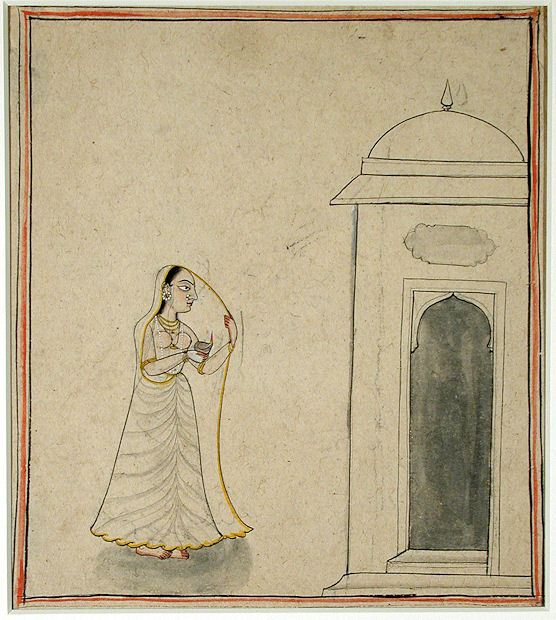
Abb.: दीपः । Frau mit Lampe, Jammu und Kaschmir, ca. 1750
[Bildquelle: Asian Curator at The San Diego Museum of
Art. --
http://www.flickr.com/photos/asianartsandiego/4837843081/. -- Zugriff am
2011-03-06. --
Creative Commons Lizenz (Namensnennung, keine kommerzielle Nutzung,
keine Bearbeitung)]
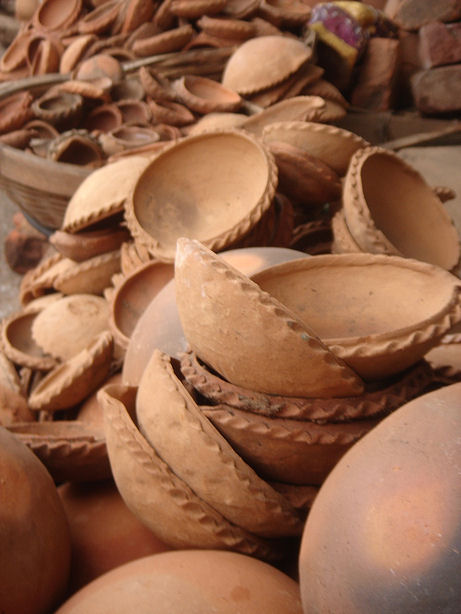
Abb.: दीपाः । Schalen für Diwali-Lampen
[Bildquelle: Kulasundari. --
http://www.flickr.com/photos/savia/49894546/. -- Zugriff am 2011-03-06.
-- Creative
Commons Lizenz (Namensnennung, keine kommerzielle Nutzung, keine
Bearbeitung)]
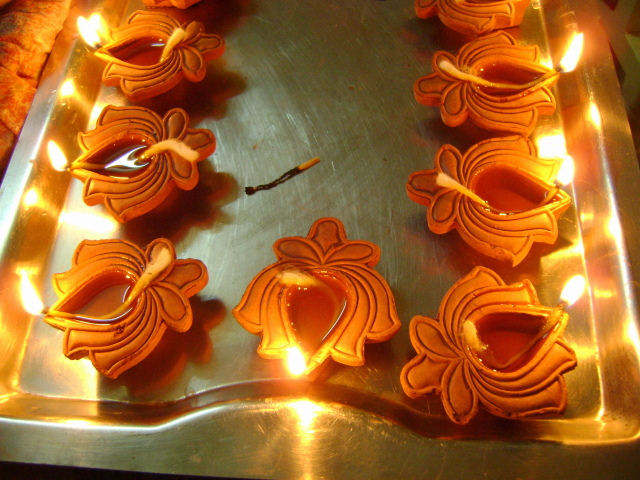
Abb.:
दीपाः । Diwali (दीपावली),
Indore - इंदौर,
Madhya Pradesh
[Bildquelle: Rashmi Gupta. --
http://www.flickr.com/photos/rashmi_g/5183330079/. -- Zugriff am
2011-03-06. --
Creative
Commons Lizenz (Namensnennung, keine kommerzielle Nutzung, share alike)]
प्रदीप - pradīpa m.: Lampe
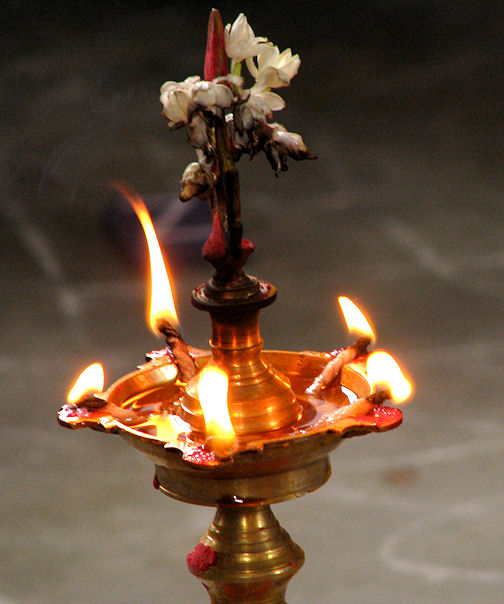
Abb.: प्रदीपः । Zeremonial-Lampe, Chinnamkulam, Tamil Nadu
[Bildquelle:
McKay Savage. --
http://www.flickr.com/photos/mckaysavage/4038861377/. -- Zugriff
am 2011-03-06. --
Creative
Commons Lizenz (Namensnennung)]
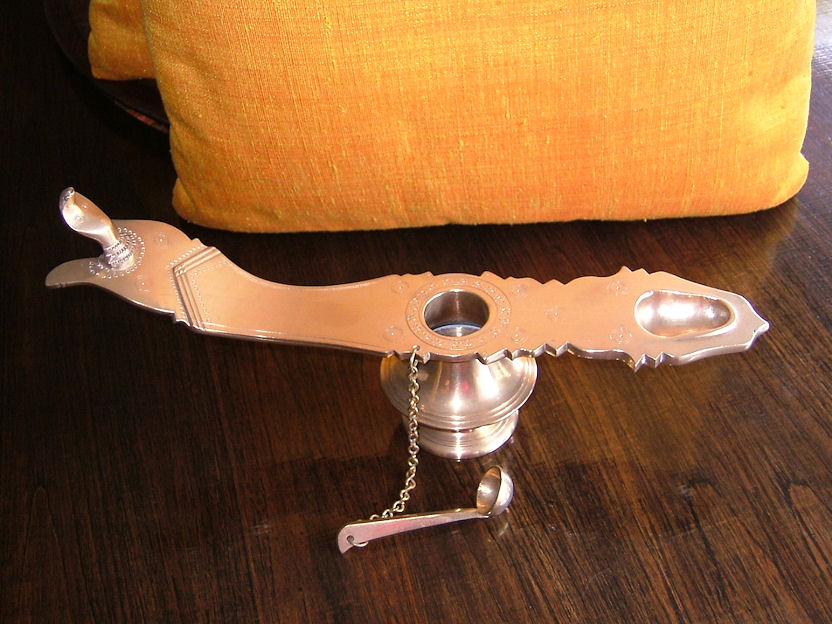
Abb.: प्रदीपः । Lampe
[Bildquelle: Alasam. --
http://www.flickr.com/photos/alasam/472817550/. -- Zugriff am
2011-03-06. --
Creative Commons Lizenz (Namensnennung, keine kommerzielle Nutzung,
keine Bearbeitung)]
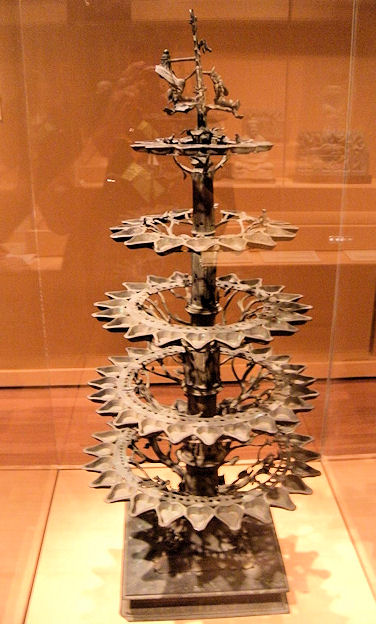
Abb.: प्रदीपः । Lampe, Kerala, 13./14. Jhdt.
[Bildquelle: airforceJK. --
http://www.flickr.com/photos/airforcejk/3305828256/. -- Zugriff am
2011-03-06. --
Creative
Commons Lizenz (Namensnennung)]
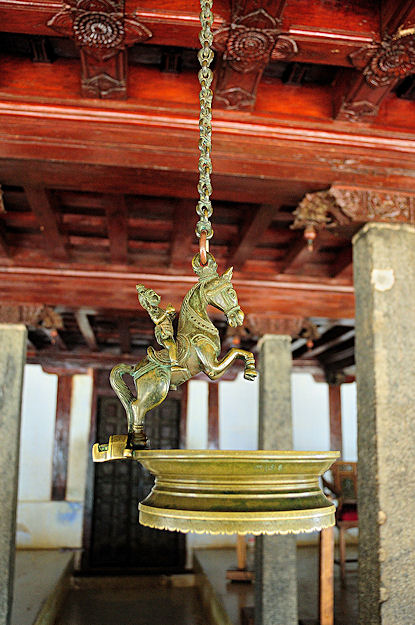
Abb.: प्रदीपः । Lampe, Palast, Padmanabhapuram -
பத்மனாபபுரம், Tamil Nadu
[Bildquelle:
Thejas Panarkandy. --
http://www.flickr.com/photos/thejasp/2683635172/. -- Zugriff am
2011-03-06. --
Creative Commons Lizenz (Namensnennung, keine kommerzielle Nutzung,
keine Bearbeitung)]
| 40a./b gendukaḥ kanduko dīpaḥ pradīpaḥ pīṭham āsanam गेन्दुकः कन्दुको दीपः प्रदीपः पीठम् आसनम् ।४० क। [Bezeichnungen für Sitz:]
|
Colebrooke (1807): "A chair or stool."
आसन - āsana n.: Sitz
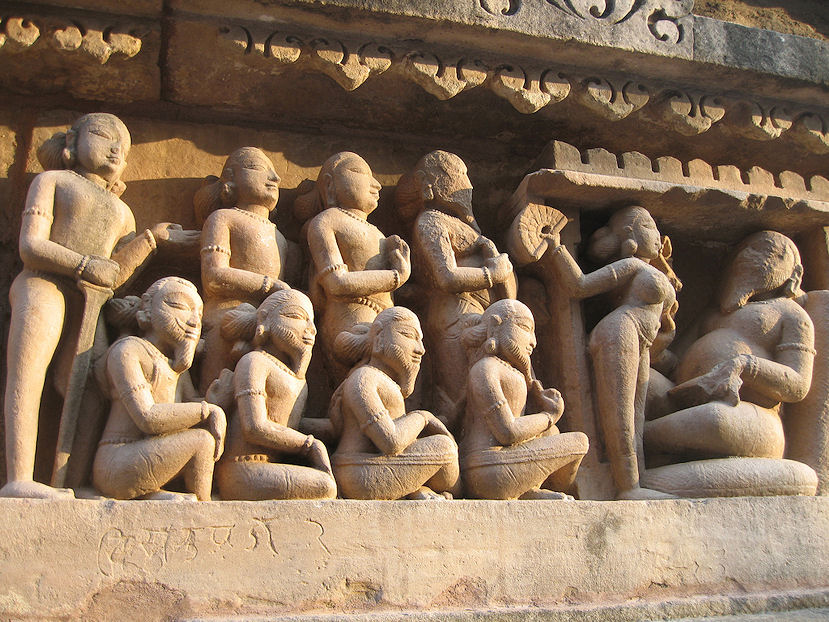
Abb.: आसनम् । Khajuraho -
खजुराहो,
Madhya Pradesh
[Bildquelle: Dan.be. --
http://www.flickr.com/photos/70534225@N00/384078263/. -- Zugriff am
2011-03-07. --
Creative Commons Lizenz (Namensnennung, keine kommerzielle Nutzung,
keine Bearbeitung)]
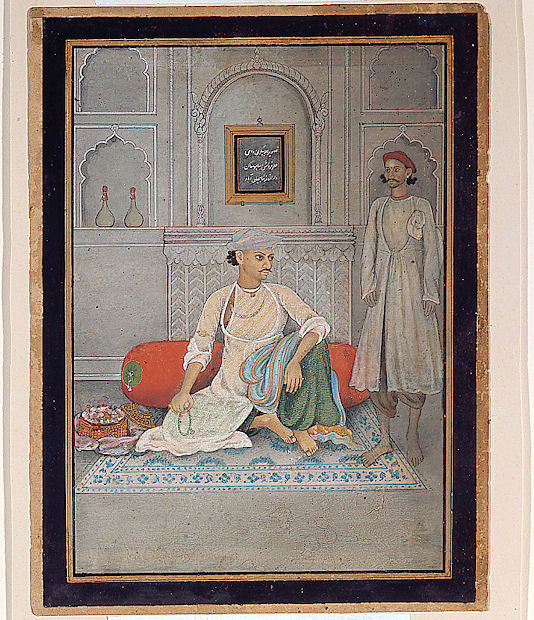
Abb.: आसनम् । Der Kaufmann Bhagwan Das von Delhi, 1825/1850
[Bildquelle: Asian Curator at The San Diego Museum of
Art. --
http://www.flickr.com/photos/asianartsandiego/4836311364/. -- Zugriff am
2011-03-07. --
Creative Commons Lizenz (Namensnennung, keine kommerzielle Nutzung,
keine Bearbeitung)]
पीठ - pīṭha n.: Sitz, Stuhl, Bank
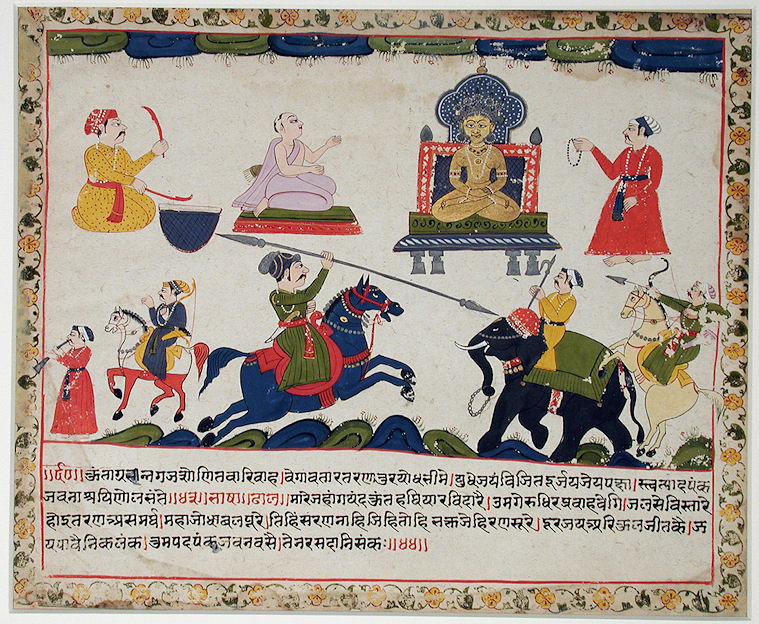
Abb.: पीठम् । Ein Jaina-Tīrtaṃkāra auf einem Stuhl, Rajasthan 19.
Jhdt.
[Bildquelle: Asian Curator at The San Diego Museum of
Art. --
http://www.flickr.com/photos/asianartsandiego/4836262882/. -- Zugriff am
2011-03-06. --
Creative Commons Lizenz (Namensnennung, keine kommerzielle Nutzung,
keine Bearbeitung)]
| 40c./d. samudgakaḥ saṃpuṭakaḥ pratigrāhaḥ patadgrahaḥ समुद्गकः संपुटकः प्रतिग्राहः पतद्ग्रहः ॥४० ख॥ [Bezeichnungen für Dose, Schmuckkästchen:]
|
Colebrooke (1807): "A casket."
| 40c./d. samudgakaḥ saṃpuṭakaḥ pratigrāhaḥ patadgrahaḥ समुद्गकः संपुटकः प्रतिग्राहः पतद्ग्रहः ॥४० ख॥ [Bezeichnungen für Spucknapf:]
|
Colebrooke (1807): "A spitting pot."
| 41a./b. prasādhanī kaṅkatikā piṣṭātaḥ paṭavāsakaḥ प्रसाधनी कङ्कतिका पिष्टातः पटवासकः ।४१ क। [Bezeichnungen für Kamm:]
|
Colebrooke (1807): "A comb."
प्रसाधनी - prasādhanī f.: "Ordnerin, Finish", Kamm
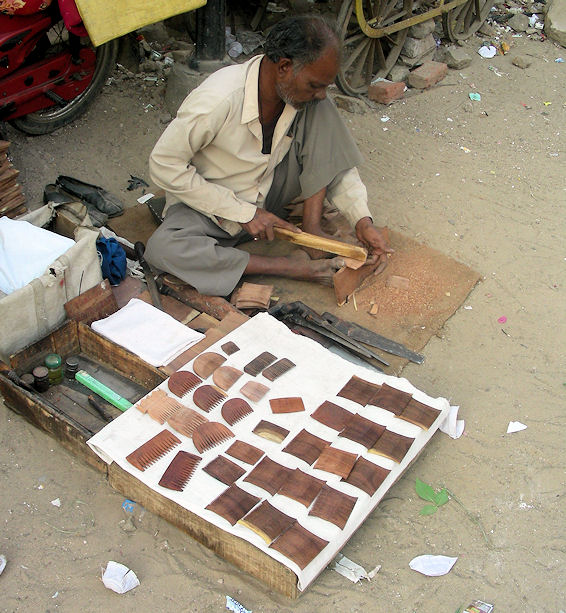
Abb.: प्रसाधन्यः । Kamm-Macher, Pushkar -
पुष्कर,
Rajasthan
[Bildquelle:
Tracy Hunter. --
http://www.flickr.com/photos/tracyhunter/289213232/. -- Zugriff am
2011-03-06. --
Creative
Commons Lizenz (Namensnennung)]
| 41a./b. prasādhanī kaṅkatikā piṣṭātaḥ paṭavāsakaḥ प्रसाधनी कङ्कतिका पिष्टातः पटवासकः ।४१ क। [Bezeichnungen für parfümiertes Puder:]
|
Colebrooke (1807): "Perfumed powder."
| 41c./d. darpaṇe mukurādarśau
vyajanaṃ tālavṛntakam
दर्पणे मुकुरादर्शौ व्यजनं तालवृन्तकम् ॥४१ ख॥ Bezeichnungen für दर्पण - darpana n.: "Stolz-Macher", Spiegel:
|
Colebrooke (1807): "A mirror."
मुकुर् - mukura m.: Spiegel
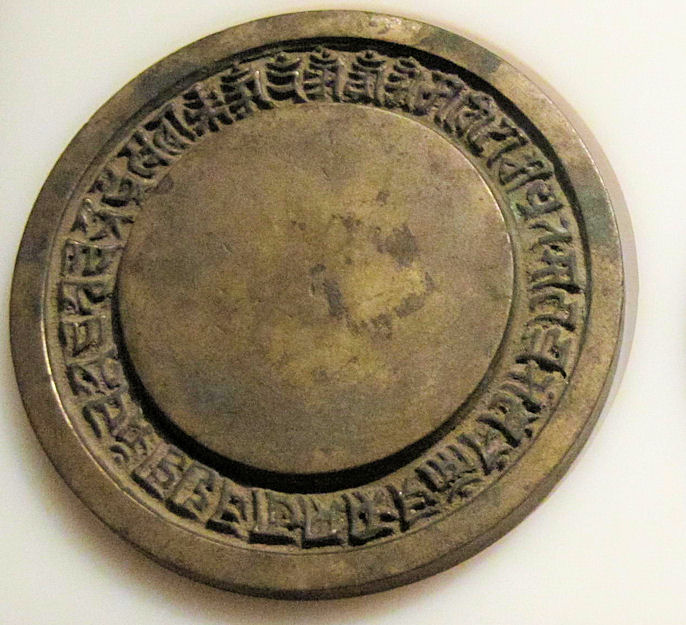
Abb.: मुकुरः । Bronzespiegel
[Bildquelle: Ivan Walsh. --
http://www.flickr.com/photos/ivanwalsh/4398065518/. -- Zugriff am
2011-03-07. --
Creative
Commons Lizenz (Namensnennung)]
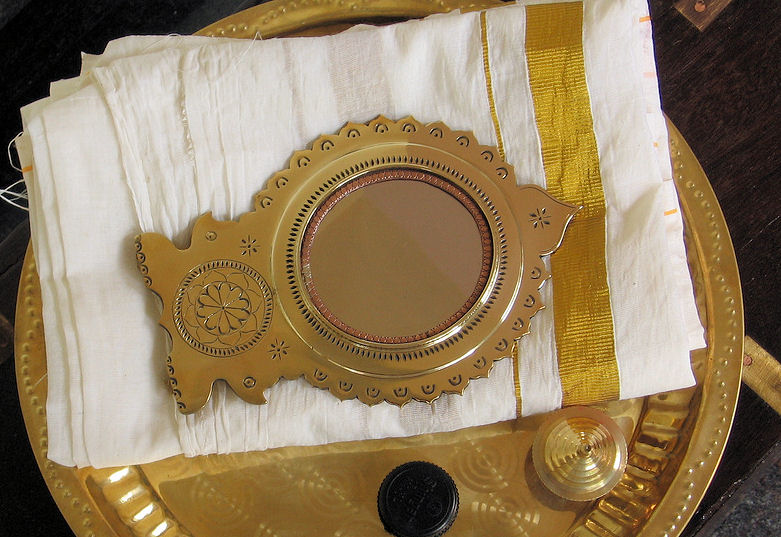
Abb.: मुकुरः । Metallspiegel, Aranmula - ആറന്മുള, Kerala
[Bildquelle: Rajesh Nair. --
http://www.flickr.com/photos/rajeshn/537285170. -- Zugriff am
2011-03-07. --
Creative
Commons Lizenz (Namensnennung)]
आदर्श - ādarśa m.: Anblick, Spiegel, Abbild
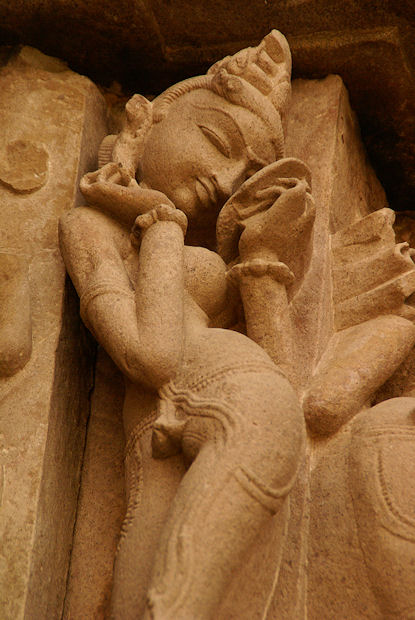
Abb.: आदर्शः । Khajuraho -
खजुराहो,
Madhya Pradesh
[Bildquelle: Patrik M. Loeff. --
http://www.flickr.com/photos/bupia/2285107753/. -- Zugriff am
2011-03-07. --
Creative Commons Lizenz (Namensnennung, keine kommerzielle Nutzung,
keine Bearbeitung)]
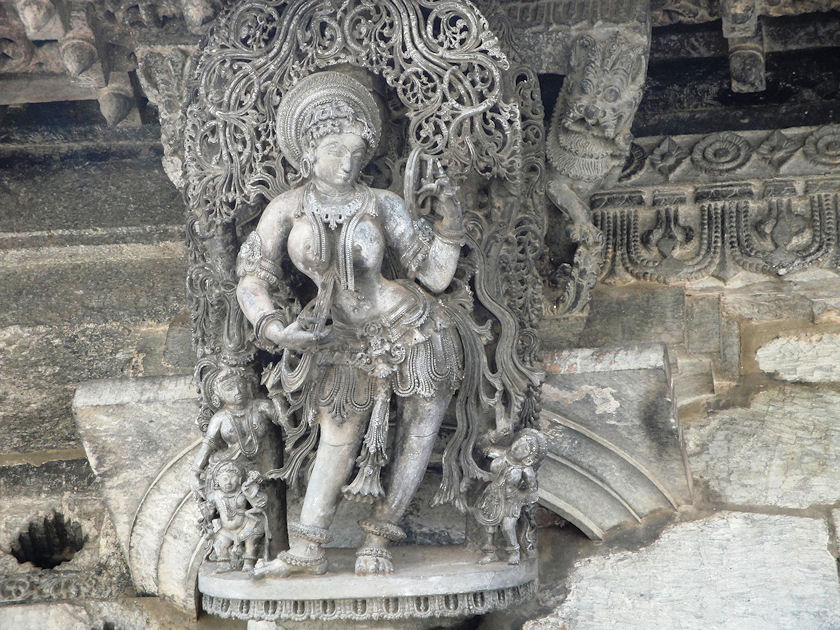
Abb.: आदर्शः । Belur -
ಬೇಲೂರು, Karnataka, 12. Jhdt. n.
Chr.
[Bildquelle: Rakhee. --
http://www.flickr.com/photos/olderock/4436710151/. -- Zugriff am
2011-03-06. --
Creative Commons Lizenz (Namensnennung, keine kommerzielle Nutzung,
keine Bearbeitung)]
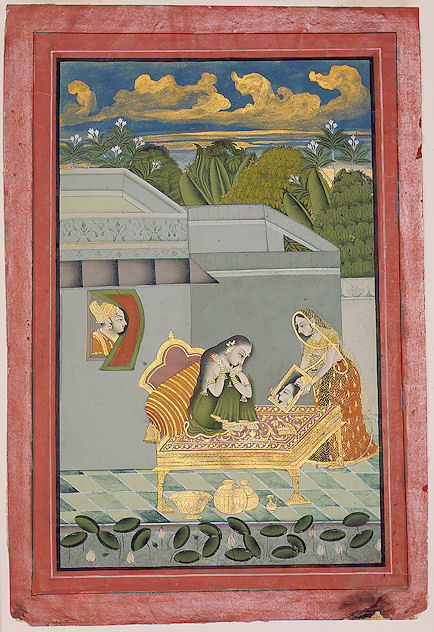
Abb.: आदर्शः । "A Glimpse of the Loved One", Rajasthan, 18. Jhdt.
[Bildquelle: Asian Curator at The San Diego Museum of Art. --
http://www.flickr.com/photos/asianartsandiego/4837706733/. -- Zugriff am
2011-03-05. --
Creative Commons Lizenz (Namensnennung, keine kommerzielle Nutzung,
keine Bearbeitung)]
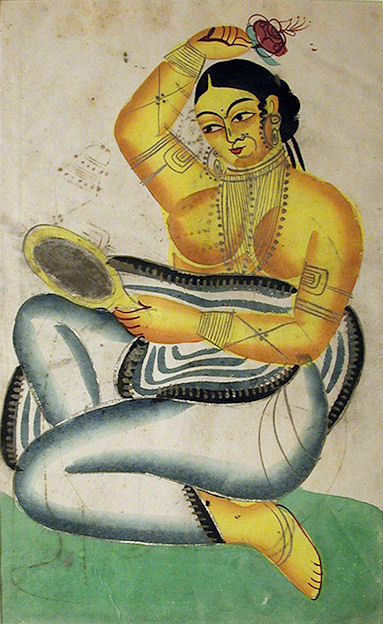
Abb.: आदर्शः । Hure mit Spiegel, West Bengal, ca. 1880
[Bildquelle: Asian Curator at The San Diego Museum of
Art. --
http://www.flickr.com/photos/asianartsandiego/4838582230/. -- Zugriff am
2011-03-06. --
Creative Commons Lizenz (Namensnennung, keine kommerzielle Nutzung,
keine Bearbeitung)]
| 41c./d.
darpaṇe mukurādarśau vyajanaṃ tālavṛntakam
दर्पणे मुकुरादर्शौ व्यजनं तालवृन्तकम् ॥४१ ख॥ [Bezeichnungen für Fächer:]
|
Colebrooke (1807): "A fan."
1 tāla m. = Borassus flabellifer L. 1753 - Palmyrapalme - Toddy Palm. Siehe: http://www.payer.de/amarakosa/amara208b.htm
व्यजन - vyajana n.: Fächeln, Fächer
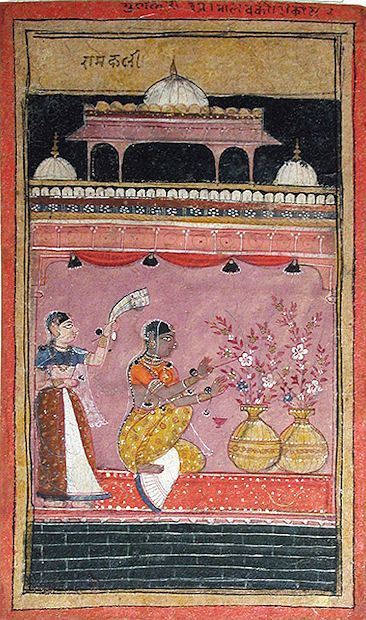
Abb.: व्यजनम् । Rajasthan, ca. 1600
[Bildquelle: Asian Curator at The San Diego Museum of Art. --
http://www.flickr.com/photos/asianartsandiego/4836295576/. -- Zugriff am
2011-03-05. --
Creative Commons Lizenz (Namensnennung, keine kommerzielle Nutzung,
keine Bearbeitung)]
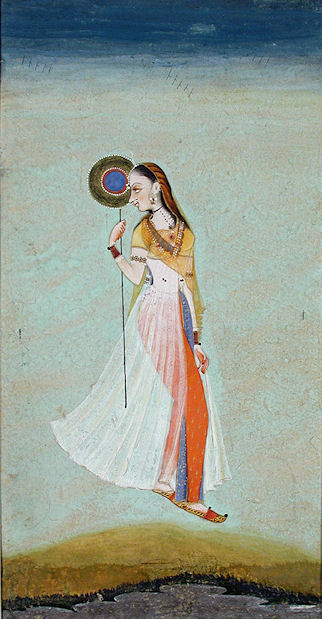
Abb.: व्यजनम् । Rajasthan, 1722
[Bildquelle: Asian Curator at The San Diego Museum of
Art. --
http://www.flickr.com/photos/asianartsandiego/4838351868/. -- Zugriff am
2011-03-06. --
Creative Commons Lizenz (Namensnennung, keine kommerzielle Nutzung,
keine Bearbeitung)]
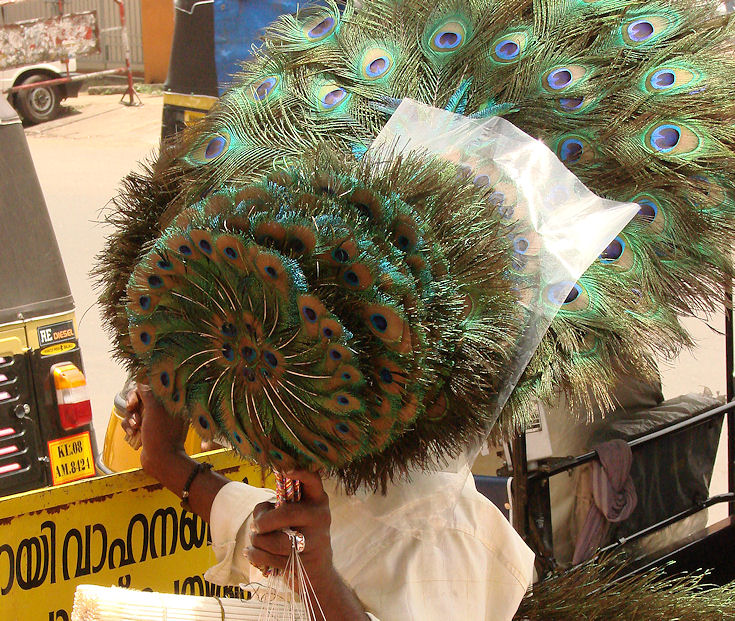
Abb.: व्यजनानि । Fächer-Verkäufer, Thrissur -
തൃശൂര്, Kerala
[Bildquelle: Adam Jones. --
http://www.flickr.com/photos/adam_jones/3773670705/. -- Zugriff am
2011-03-07. --
Creative
Commons Lizenz (Namensnennung, share alike)]
तालवृन्तक - tālavṛntaka n.: Palmyrapalm-Stängel, Palmypalm-Fächer, Palmblatt-Fächer

Abb.: तालवृन्तके । Orissa, 18. Jhdt.
[Bildquelle: Asian Curator at The San Diego Museum of
Art. --
http://www.flickr.com/photos/asianartsandiego/4836265930/. -- Zugriff am
2011-03-06. --
Creative Commons Lizenz (Namensnennung, keine kommerzielle Nutzung,
keine Bearbeitung)]
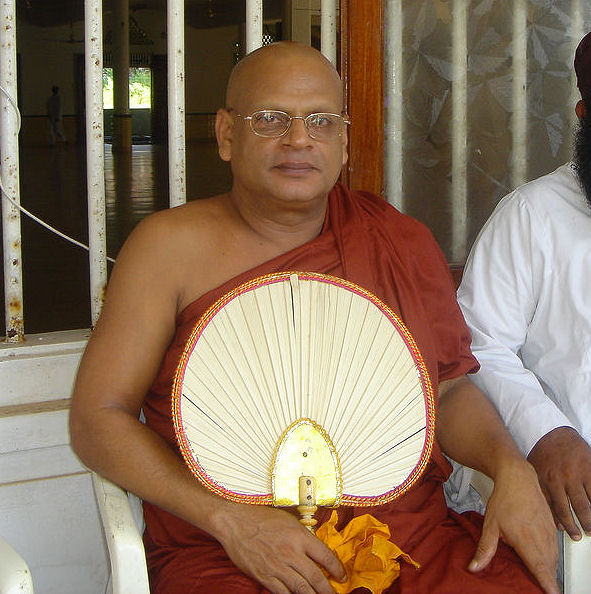
Abb.: तालवृन्तकम् । Buddhistischer Mönch, Sri Lanka
[Bildquelle:
Sarvodaya Shramadana. --
http://www.flickr.com/photos/sarvodaya/4289496/. -- Zugriff am
2011-03-07. --
Creative
Commons Lizenz (Namensnennung)]
iti manuṣyavargaḥ
इति मनुष्यवर्गः
Zu brahmavargaḥ (Abstammung, Stände, Brahmanen) - Vers 1 - 7a